
















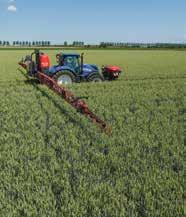
INDUSTRY NEWS

04 With knowledge, threatening changes can become opportunities
06 Planning in the face of uncertainty
09 Unique industry forum continues to gain traction
10 Study finds link between evolution and herbicide resistance
13 Customised crop recording (and compliance) on the go
14 Keep a weather eye on one-of-a-kind model
17 Crop scientist welcomes extension work with growers
18 Major update for crop modelling in OverseerFM
20 Annual rye learns to love Queensland heat
21 World-first quality control system comes into effect next harvest
SEEDS
22 Just right - Goldilocks zone beckons for lower seed loss at harvest
24 Can we lift plantain seed yields?
25 Improving yield, returns for linseed SUSTAINABILITY
26 New test for biological soil health
31 Livestock adds value to arable, field day told
34 On guard – your best biosecurity defence is constant vigilance CEREALS
37 Spoiled for choice – grain breeder brings raft of new options to the market
39 Digging into the nitty-gritty of cereal economics
42 Long-running trials give growers confidence in cultivar performance
44 Whopper proves to be consistent performer despite challenges
AgriMedia Ltd, Ashcroft House PO Box 37151, Halswell, Christchurch 8245 ph 03 329 6555 www.agrimedia.co.nz www.novachem.co.nz
PUBLISHED BY: Publishers of Rural Contractor & Large Scale Farmer, AgriBusiness, AgriVet, NZ Cropping Yearbook, Australian AG Contractor & Large Scale Farmer, NZ Novachem Agrichemical Manual.

MAIZE
46 Closing the knowledge gap on narrow row spacing
48 Resilience & recovery underway in Gisborne
50 Maize delivers benefits to South Island farmers
CONTRIBUTORS
53 More focussed and flexible foliar disease control
54 New Duncan triple disc drill turns heads
56 Marking 10 years’ commitment to the future
57 Get back growing sooner
59 Sensor science supports more efficient nutrient use with no yield sacrifice
62 Clean, high yielding brassica crops a step closer this season
65 Sustainable nutrient management, to the next level
67 Keep on top of aphids before they’re on top of your crops
68 Adding value to Southland oats
71 Brace for the windy season
72 Glyphosate decisions based on politics
74 Stacking DMIs providing early season disease control in wheat
76 Want a drying floor without building a new shed? No problem
79 Wet year highlights the importance of drainage
80 ‘Listen, learn, deliver’ key to supporting farmers & growers
82 Prosaro & VIMOY iblon will help you deliver crop yield
85 Popular arable herbicide kills two birds with one stone
86 New control for rust in ryegrass seed crops excels
88 Banish grass weeds without having to add adjuvants
91 COMPANY LISTINGS
103 FIELD CONTACTS
112 SEED CERTIFICATION
EDITOR
Kathy Davis PO Box 37151, Halswell, Christchurch 8245 ph 03 577 5640
PRODUCTION & DESIGN
Hannah Kincaid email art@agrimedia.co.nz
ADVERTISING MANAGER
Paula Forde mob 027 229 0362
email paula@agrimedia.co.nz
CIRCULATION
email admin@agrimedia.co.nz
As 2023 is a referendum year for FAR, I would like to start by recognising the foresight of the original team of growers who were instrumental in campaigning and gaining industry support for the establishment of the levy funded, independent research organisation that is FAR.
WORDS: STEVEN BIERMA, CHAIR, FOUNDATION FOR ARABLE RESEARCHThey recognised that the New Zealand arable industry couldn’t rely on duplicating overseas research results; our unique climate meant imported approaches often provided quite different outcomes.
The initial goal of this group was to develop an applied research programme that would increase New Zealand arable crop yields, and with them, growers’ profitability.
The resulting research programme, which has included CPT trials, grass seed plant growth regulator research, fertiliser timing for a range of crops, 20 tonnes by 2020 and long term cultivation and establishment trials, has contributed to the development of a New Zealand specific approach to arable cropping and agronomy.
And nearly 30 years later, the FAR team has grown to include an outstanding range of plant and environmental research, technical, extension, financial and management skills.
This increase in skills reflects the changing world in which farmers now operate.
Rules and regulations, driven by consumer demand, have more impact on the way we farm than ever before.
In my opinion, the only way to meet those demands is through demonstrating proven good management practice (GMP), based on knowledge, scientific proof and data collected on-farm.
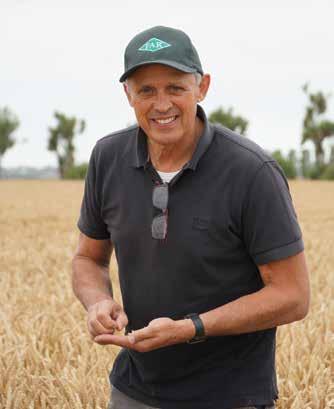
Since the end of World War II, food production has increased exponentially; artificial fertilisers, herbicides, fungicides and pesticides have played a big role in that.
Over time, a number of chemicals were found to be not that friendly and use was ceased. The availability and efficacy of pesticides, fungicides and herbicides is constantly changing due to regulation and resistance.
Current FAR work includes a big investment in identifying other solutions, with biopesticides, biological fertilisers, technical solutions and farm systems all being investigated.
2023 has also seen the launch of Cultivate Ventures, an investment fund, initiated by FAR, to support and encourage innovative New Zealand companies in the development

of technologies that will benefit arable growers.
I thank the growers, who share FAR’s vision, and have co-invested in this first round. Northington Partners, who are managing the fund, are keen to get this project on the way.
Growers Leading Change (GLC) is about to complete its third and final year.
Grower involvement and feedback has been high and FAR hopes to extend and expand on what we have learned from the first three years of MPI and grower investment.
Growers Leading Change has allowed growers to identify key issues and opportunities in their region and work with facilitators to receive targeted support and information.
Crop and region specific research, like exciting new technologies in maize, also create future opportunities.
As noted earlier, FAR is a levy organisation, and 2023 is a referendum year when we ask you, our growers, to confirm to the Minister for Primary Industries that we are delivering valuable research.
Voting papers will be out in July, and I would like to urge all the arable growers of New Zealand to vote and return the referendum papers, hard copies or digital.
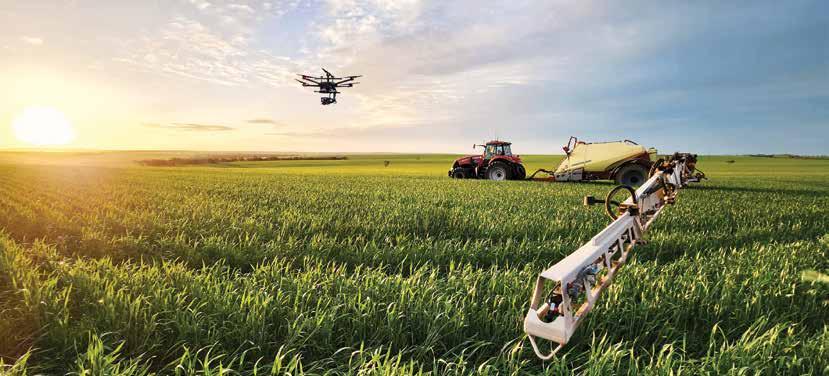
Delivering a complete suite of crop protection solutions for today’s arable growers.
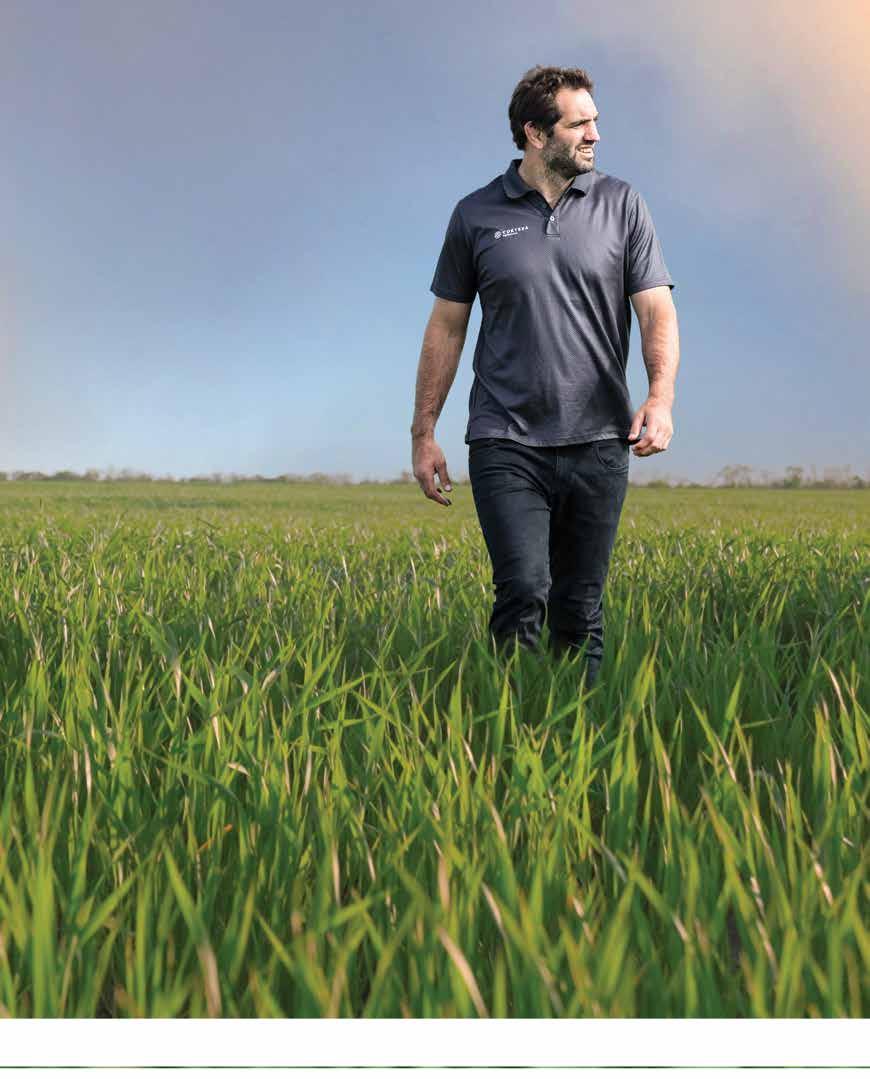
Samuel Whitelock – Plant Science Graduate, Lincoln University.
Our portfolio of powerful, proven products has helped farmers from one end of the country to the other create and maintain thriving businesses, and has earned us a reputation as New Zealand’s arable protection specialists.
Our suite of innovative crop protection solutions provide local farmers with everything they need to win the war on weeds, pests and diseases. Visit corteva.co.nz to view our range of online arable resources.
If there is one thing that last year has taught us it is that we are living in turbulent times and that trying to predict and plan ahead, with even a smidgen of certainty, is going to be very challenging.
WORDS: ALISON STEWART, CEO, FOUNDATION FOR ARABLE RESEARCHCovid related restrictions have lingered longer than many people anticipated and, while not impacting the arable sector to the same extent as those that rely more heavily on migrant labour, they have still brought many logistics and supply change challenges.
Add in the flow-on effects of Russia’s invasion of Ukraine and it’s not surprising that we’re seeing price increases along with food and fuel shortages around the world.
New Zealand is somewhat protected at present, but we can expect significantly higher farm production costs over the next 12-18 months.
Yes, high grain prices will help to balance the farm budget in the short term, but the revenue highs will be relatively short lived, while input costs are unlikely to come down.
Increased compliance costs are also looming with greenhouse gas emissions levies for agriculture coming into force in 2025, and following one of the most difficult harvests in decades, the risk of more regular extreme weather events is also on growers’ minds.
Obviously arable growers have more options available to modify farm management practices in the face of fluctuating input costs and market demands than monoculture systems, but it will still be challenging.
So how can you manage your farm business through such uncertainty?
How will you decide which crops to include in your rotation for the next five years? How will you identify which contracts offer fair and realistic prices for grain and seed you grow?
Unfortunately, there is no specific industry wide guidance that levy bodies or industry consultants can give because the market is changing so quickly and the trends are somewhat unpredictable. Basically, it comes down to understanding the true cost of production for
each crop and livestock unit within the farm and having a farm operational plan that allows for maximum flexibility.
This may seem like teaching growers how to suck eggs, but we know, from the farm profitability workshops that FAR has held over the last few years, that many growers do not accurately account for all of the direct and indirect costs for each crop and often overestimate forecast gross margins.
This, combined with price uncertainty, could result in growers signing forward contracts at prices that will deliver limited if any returns.


Armed with this knowledge, growers will be able to identify fair contract prices, with acceptable margins of error for price fluctuations. This could be even more effective if growers worked together to negotiate contract prices, terms and conditions with the various seed, feed and grain companies.
Many other industry sectors have grower contracts with differential pricing tiers linked to specified market conditions.
Armed with this knowledge, growers will be able to identify fair contract prices, with acceptable margins of error for price fluctuations.
Many farm finance packages address accounting, but they do not necessarily provide detail on the profitability of individual crops/livestock units. This is where platforms such as ProductionWise® fit in.
ProductionWise is freely available to all arable levy payers and captures very specific details on crop inputs and outputs, thus providing a more accurate assessment of gross margins. On a simpler scale, FAR has also produced a simple crop production cost template (in the form of an Excel spreadsheet) that growers can use if they want a quick assessment of production costs.
This also allows growers to do some sensitivity analyses by playing around with different input costs and potential contract prices so that they can see what their gross margins will look like under different scenarios.
This is not about growers trying to screw every dollar they can out of the processor/distributor, rather, it is about fair financial recompense for the quality and quantity of product being sold, and enabling growers to maintain profitability and continue to service the needs of the processors/ distributors.
Surely a win-win for all parties. Arable growers are known for their technical competence and ability to manage complex farm systems, but do not always have the same abilities when it comes to finance and budgeting.
With the introduction of emissions pricing in 2025, it will become even more important to understand exactly where your farm income (and greenhouse gas emissions) come from. For example, if your system includes livestock finishing or winter grazing, you need to be able to work out the extra cost associated with the livestock’s methane emissions versus the revenue generated from the animals to make sure that having livestock on the farm makes financial sense.
Likewise, given the many new growing opportunities around plant proteins, plant based milk, specialty grains etc, which are likely to come along over the next 10 years, it is important that you are able to calculate the true cost of each component of your farm business and from there, the real value of new crops. We don’t need more low value commodity crops!
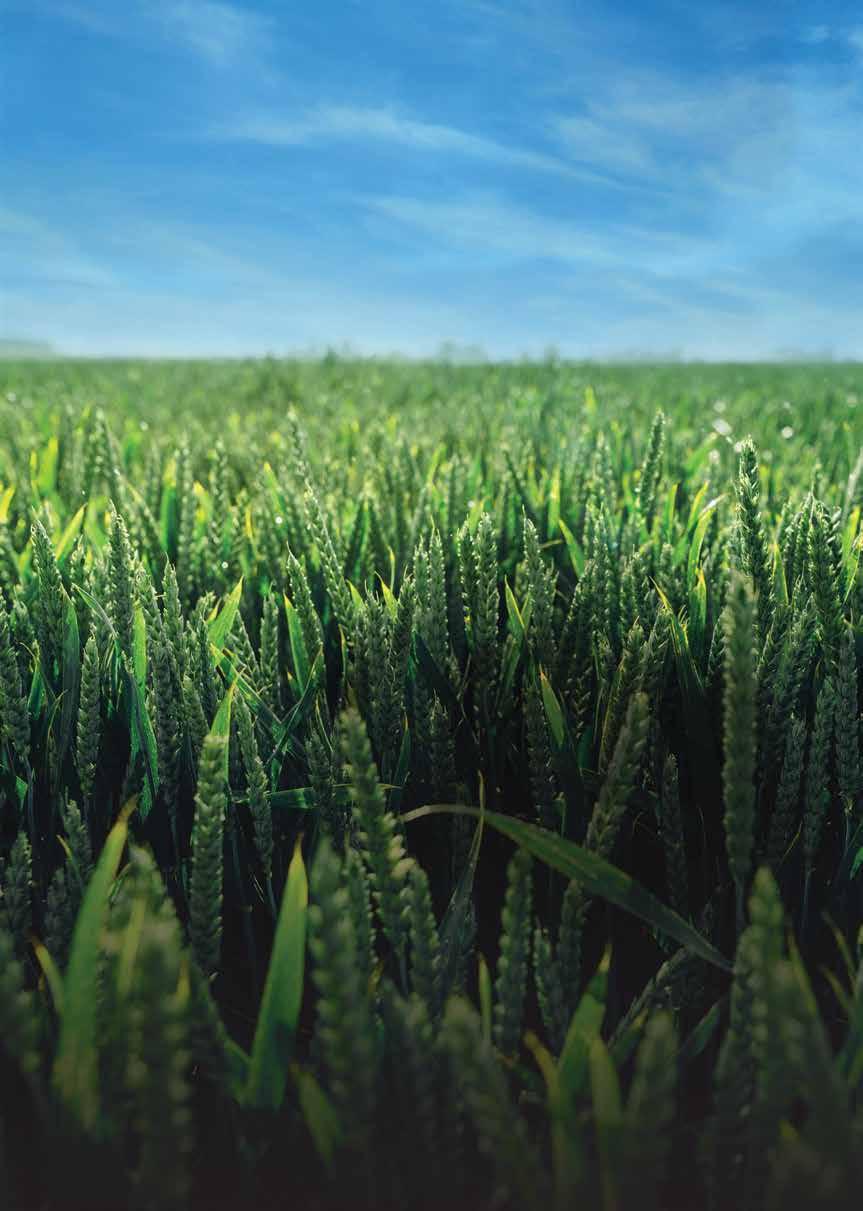
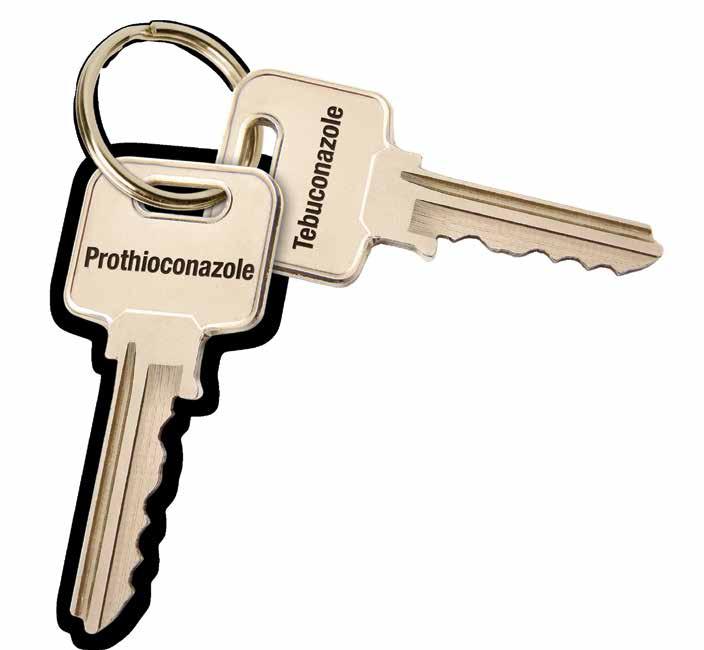

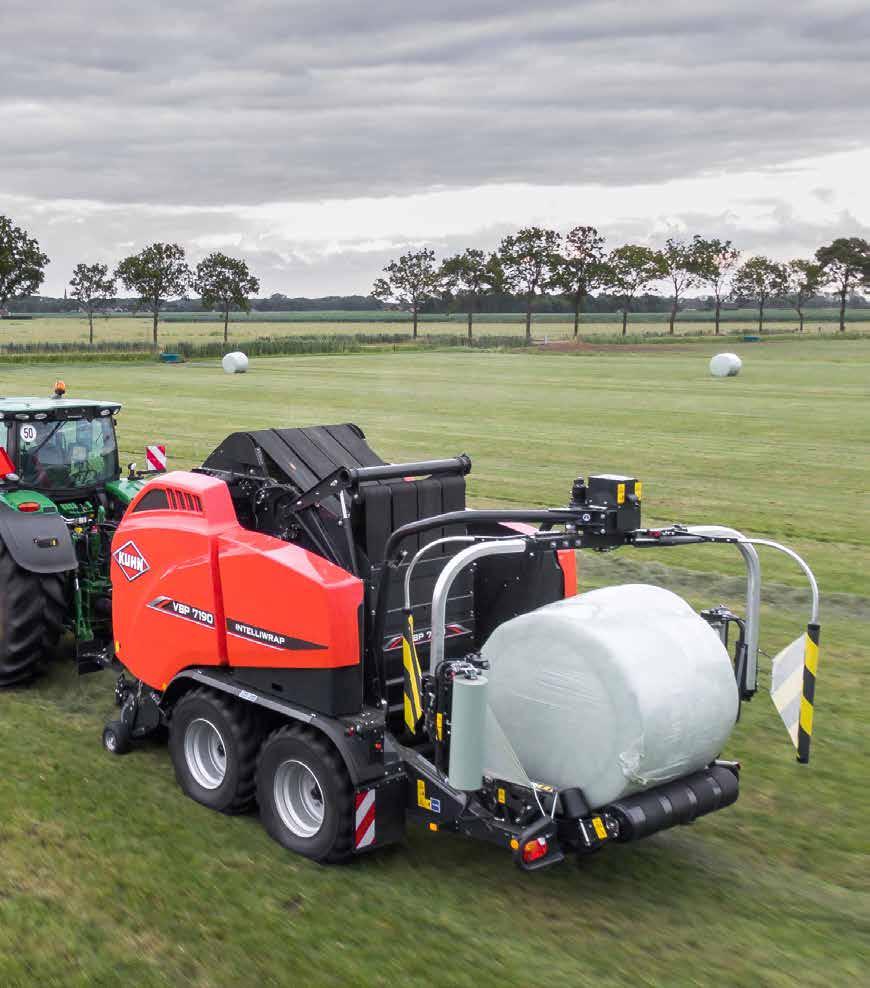
More than 140 delegates took advantage of the opportunity to get together last month for another successful Women in Seed forum hosted by the New Zealand Grain and Seed Trade Association.
Association vice president Charlotte Connoley says the event serves as an important annual networking opportunity for females within the seed industry and was also about challenging attendees around the issues of the day with the aim of resulting in personal and professional growth for those present.
A networking breakfast opened the event promoting much greater collaboration between industry professionals for the betterment of the industry before delegates heard from an outstanding line up of speakers from within the seed trade, business sector and health and wellbeing.
Covering a variety of perspectives, presenters included Foundation for Arable Research CEO Alison Stewart; special agricultural trade envoy Mel
Poulton; athlete Gemma McCaw and Gabrielle O’Brien, chief executive of Rural Women NZ.
In the afternoon session, speakers included Maury Leyland Penno, cofounder of Leaft Foods; Julia Jones, head of analytics at NZX; ANZ rural economist Susan Kilsby and psychologist Dr Lucy Hone.
“The success of the forum just continues to grow,” Charlotte says.
“It is challenging times for the primary sector at the moment as a result of the earlier weather events and ongoing legislative pressures.
“Now more than ever it is crucial our delegates are given opportunities to expand their technical and industry knowledge to support growers and farmers with the challenges ahead.
“Providing tools for better mental re-
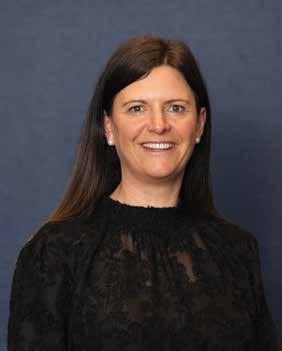
silience as we heard here today from one of our keynote speakers Dr Lucy Hone is also critical for our own health and wellbeing but also so we can provide support to the farming community.”
With attendee numbers surpassing the organisation’s annual conference it is clear there is demand for an opportunity such as this forum for females in the industry, Charlotte says.
“We were absolutely delighted with the turnout and support from our many industry members ranging from administrators, plant breeders, plant researchers, agronomists, and traders to lab and technical experts.”

The Foundation for Arable Research conducts research, development and extension on grain and seed crops for New Zealand arable farmers under three compulsory Levy Orders (Arable crops, Maize grain and silage, Cereal silage). The current Levy Orders expire in July 2024 and growers will be asked in July/August 2023 to vote in a referendum to renew these Levy Orders.
Voting papers together with an information sheet will be sent out to all levy payers on 21 July 2023 with the option to cast a postal or online vote. Only those growers who have harvested arable crops, maize or cereal silage in the period between 1 July 2022 and 30 June 2023 are entitled to vote.
Voting closes at 12 noon on Wednesday 23 August 2023, we ask (if possible) to use the online voting option.
FAR has provided valuable research to New Zealand arable growers over the last 27 years. We need your support to continue this work so please take the time to vote.
A study of one of the worst weed-control problems facing farmers worldwide – herbicide resistance – has helped a global team of scientists determine the genes behind an evolutionary plant trait.
The trait is NTSR, or non-target site herbicide resistance.
Associate professor Christopher Saski, of Clemson University in South Carolina, USA is collaborating with researchers from Rothamsted Research in the United Kingdom, the University of Copenhagen in Denmark, and Bayer Crop Science for a study to understand the origins of this trait.
The researchers believe this knowledge ultimately may help usher in new herbicides and improved crop management.
“Herbicides are designed to a specific target in plants,” says Christopher, an associate professor of systems genetics in Clemson’s Plant and Environmental Sciences Department.
“Historically, the type of resistance farmers have dealt with is called ‘targetsite’. This is where the plant incurs a mutation in the herbicide’s target, resulting in the herbicide no longer being effective so that it no longer kills the weed,” he says.
Target-site resistance typ-
ically is linked to a specific herbicide or group of herbicides and is easy to identify and manage.
The more complicated problem is ‘non-target site resistance’, also known as ‘metabolic resistance’.
NTSR involves more changes in the plant than just the target site.
“Non-target site herbicide resistance occurs when the plant is able to detoxify the herbicide or when the herbicide does not reach its intended target,” Christopher says.
“This form of resistance is much more difficult to identify and manage. This is a really bad situation because it causes the loss of multiple options for weed control.”
The study focuses on blackgrass, a grassy weed that is native to Europe and Asia and has been introduced to many other regions of the world, including North America.
Blackgrass is considered the most noxious weed of small grains in Europe.
It is difficult to control because it is resistant to many

herbicides and completes its lifecycle within the cereal crop growing season.
It is also a prolific seed producer, with each plant capable of producing thousands of seeds, allowing uncontrolled infestations to grow rapidly.
Efforts have been made to control blackgrass with chemistry but that has led to widespread multiple-resistance to herbicides, especially post-emergence herbicides.
Pre-emergence herbicides are more effective, but NTSR is beginning to threaten these actives too, reducing the available options for controlling this weed.
Rothamsted Research researchers have spent years developing the genetic study populations used, two that have independently evolved NTSR and one that was susceptible to herbicide.
To develop a foundation from which to study heritable traits in blackgrass, the researchers created a roadmap to show where the genes are located on chromosomes.
They used genetic analysis techniques to compare the two study populations that uniquely evolved NTSR, to determine genes involved in the trait.
A fundamental question the researchers asked was, ‘Do traits that evolve independently have the same genetic basis?’
Their answer is, ‘possibly’.
“While we were keen to highlight the genes involved, we also wanted to compare how similar this trait was in different populations,” says David Comont, research scientist at
Rothamsted Research.
“Understanding how variable this trait is from one population to another can help us understand how best to diagnose and manage this resistance, whilst also shedding light on the evolutionary processes involved.”
The researchers found some overlapping genes involved, as well as some unique ones.
“This suggests this resistance involves a shared ‘core’ set of genes, within a uniquely evolved profile or ‘fingerprint’ from one population to the next,” Christopher Saski says.
Since the beginning of time, plants have changed their genetic makeup in response to stresses such as heat and drought, as well as herbicides.
Weed resistance to herbicides is increasing worldwide and threatening global food security. Christopher says this study can help plan for the future.
“These findings have wide significance for understanding the potential for rapid plant adaptation under novel and changing environments.
“Knowledge of the genes (and how they are regulated) that confer NTSR can be used in the design of new monitoring and mitigation strategies as well as novel herbicides, to help combat herbicide-resistant weeds.”
Other researchers involved in the study include Lichun Cai from Clemson, Dana MacGregor and Claudia Lowe from Rothamsted Research; Roland Beffa and Bodo Peters from Bayer Crop Science and Paul Neve from the University of Copenhagen.


When ProductionWise started, few growers could have imagined how much compliance they would have to manage in today’s systems.
Launched by FAR in 2012, the unique webbased farm management system was designed first and foremost to improve on-farm decision making, financial recording and industry benchmarking.
Eleven years later, it’s still doing this.
It’s also become a chemical inventory, complete with mandatory H&S documentation; a crop rotation planner; a risk-mitigator for herbicide and pesticide resistance; and a seamless channel for shared operations with third party service providers like contractors and advisors.
Beyond these functions, however, it has become an invaluable compliance tool - cheap (free to FAR levy payers); fully customised for New Zealand arable producers; auditor-approved and capable of capturing pretty much every piece of information required to meet increasingly stringent rules and regulations.
FAR’s ProductionWise manager Melanie Bates says there was no way of knowing for sure during early days of system development that recording even ostensibly small details would one day be useful, like what personal protective equipment was worn for a particular spray job, prevailing weather and wind direction, start and finish time, or operator details.
But the ability to do so was retained nonetheless, just in case…
Fast forward to 2023, and it’s no surprise that an increasing number of the 1200-
plus users currently registered with ProductionWise are turning to it for compliance first, financials second.
That said, the financials still matter, now as much as ever, if not more.
Which makes the recent release of the updated ProductionWise app all the more useful, Melanie says.
“Being able to capture key on-farm operations and tasks on a phone or tablet, while you’re in the field, reduces admin time, improves data accuracy and makes it easier to keep track of what’s been done, when, by whom, and how much it cost.”
Devon Long, general manager, Regrow (NZ and Australia) says the new app is a complete rebuild, and should solve the operating issues that were frustrating many users for some time.
“The original ProductionWise app was built over five years ago. Since then, smartphone technology has changed and evolved significantly, resulting in the app’s underlying technical infrastructure no longer being supported by major smartphone operating systems like iOS and Android.
“That lack of support led to issues with speed and functionality of the original app. The newly built app will meet the needs of current users and is also a good foundation for any improvements over the next couple of years.”
Included in changes to ProductionWise is an extra input box to capture the price of chemicals applied to
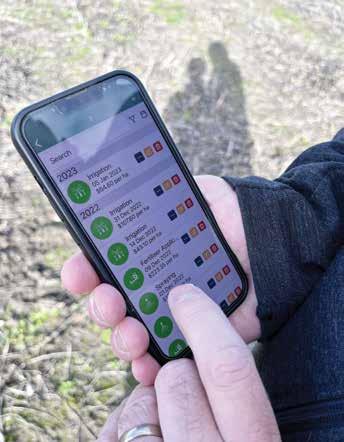
Updated app lays the foundation for future improvements.
crops, which is an essential part of calculating accurate gross margins per crop, Melanie says.
“As well as the system default, which is FAR’s basic price, we’ve now got an option that remembers the price that you’ve entered previously, either via my diary or the chemical shed function.”
Individual user benchmarking under tools has also been further developed to include graphs colour coded to show water, fertiliser and spray inputs per crop, she says.
“It’s much easier sometimes to look at a visual than at rows of numbers! You can use this to see at a glance not only what’s gone into that particular crop but also how those inputs compare to FAR regional benchmarks.”
More importantly, the user's own benchmarking reporting function summarises and compares all your farm’s gross margins for any time frame, so you can compare all your wheat crops, for example, or compare different crop types within your own system.
When the Seed Certification Information System (SCIS) comes online this sea-
son, ProductionWise users will be able to export their map straight into it, which will help growers transition to the new programme.
“There’s also a relatively new calendar function, which automatically captures paddock operations so you can easily look back on last year and see what you did at any particular time. You can use this to add a new ‘activity’ directly from it.”
Looking ahead, Melanie says FAR is always looking at ways to support potential improvements for ProductionWise, including something that plenty of users are very interested in.
“We know they want a livestock recording system built into ProductionWise, because they’ve been asking for it. Many arable farmers have livestock as part of their business, and in those situations, they have to use a livestock recording system as part of their reporting obligations. It would make things much easier for them if they could do it all through ProductionWise.”
For more details visit productionwise.co.nz or phone the FAR office, 03 345 5783.
Updated daily, super easy to check on-line and free of charge, a unique sub-seasonal prediction model released by NIWA late last year gives arable farmers the chance to further fine-tune crop management.
NIWA35 is the fruition of two years’ collaboration between institute forecasters and modellers, and the Ministry for Primary Industries.
Every day, it looks five weeks into the future and assesses the outlook for drought or rain during that time across New Zealand, and in different regions (shiny.niwa.co.nz/drought-forecast).
Billed as a drought forecasting tool, NIWA35 works for excessive rainfall too, picking out the potential for extreme rainfall from Cyclone Gabrielle over 10 days in advance.
Those behind it say it’s one of a kind, globally as well as in NZ, and they want people from all walks of the agri economy to take advantage of it.
The model provides rolling 35-day forecasts of dryness, drought and rainfall, at much higher resolution than has ever been available, giving farmers, growers, advisors, contractors and other primary professionals a ‘reasonable’ estimation of wettest and driest case scenarios over the coming five weeks.
Auckland-based data scientist Neelesh Rampal has worked with NIWA colleagues, meteorologists Ben Noll and Tristan Meyers, to develop the model.
Tristan says in an arable scenario, given the high proportion of operating expenses often associated with paying for, pumping and applying water, one way NIWA35 could be used is in making key decisions about when to turn irrigators on or off.
“It’s another tool to help support climatic resilience on-farm. Having
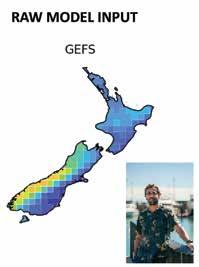
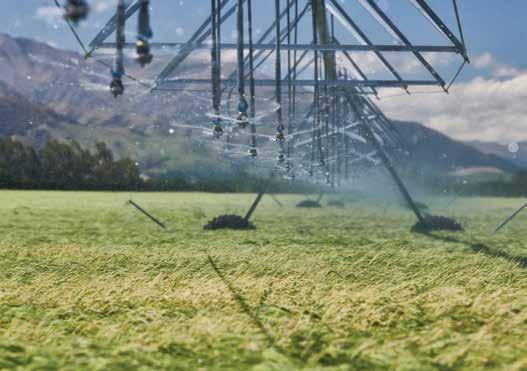
To water, or not to water? New model can help decide, NIWA says.
a heads-up on when to think about starting or stopping irrigating can save thousands of dollars, money which in turn can then be re-directed to help strengthen the climatic resiliency of your operation in other ways.”
The model uses recent advances in both atmospheric modelling and artificial intelligence, coupled with the processing power of the latest generation supercomputers, to push forecasting
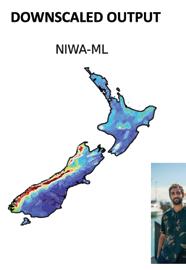

out further, with both higher certainty and resolution.
Data collection to create NIWA35 is extensive, and researchers are leveraging off a United States model established by the National Oceanic and Atmospheric Administration (NOAA).
Raw data is pulled down onto NIWA’s high-performance computer from NOAA every day. It is at a 50 km resolution and a 31-member ensemble, which means that data is drawn from 31 different instances of the model.
This supplies 31 different scenarios for the forecast. When these scenarios agree, forecast confidence is generally higher, and when they diverge you’ve got lower confidence.
Importantly, NIWA35 is able to scale the ‘coarse’, global 50 km input grid down to a 5 km radius over New Zealand. This resolves the country’s com-
Neelesh Rampal shows how NIWA35 uses artificial intelligence to create high resolution forecasting at 5km (right), from a low resolution input forecast at 50km.

Crop residue cultivation and incorporation is an important factor in conservation tillage. It incorporates all the crop residue evenly into the soil with an intensive mixing. With 600mm discs, Qualidisc has excellent penetration and soil movement for both shallow and deep cultivations.

The Kverneland Kultistrip only prepares the soil where the crop is going to grow. Depending on the intended width of the row, up to 70% of the soil surface is not worked. This not only protects the soil against erosion and drying but also reduces the tillage costs.
A special feature of this machine is the separate adjustment of the break-up share and fertiliser injector. This means that you can change the working depth whilst keeping the fertiliser placement the same, or vice versa.

plex topography far more effectively.
“It’s challenging to make decisions from something coarse, and 50 km is not representative of the wide diversity of our terrain in New Zealand,” says Neelesh Rampal.
Climate change is exacerbating extreme weather events and NIWA’s longterm climate projections point towards an increasing risk of prolonged dry spells across much of NZ in the decades
ahead, particularly in northern and eastern regions.
The implications of such projections are significant – both for individual farmers and the country at large.
Treasury figures show drought has cost NZ more than $5 billion in lost agricultural production over the past 15 years.
Tristan Meyers says one of the beauties of the NIWA35 model is on-
Drought has cost NZ more than $5 billion in lost agricultural production over the past 15 years.
going development.
“It’s not just sitting there as a static, unchanging tool. We’re working on it continuously.
“For example, a key research area we as forecasters are exploring with it, given that this is an AI-type system, is whether training the model on recent heavy rainfall events to learn from will then make a difference in our predictive abilities.”
Regardless of the outcome with this particular area of research, the accuracy and reliability of the model will continue to improve in the future, he says.
Meantime, NIWA35 is already helping people in all sorts of occupations plan ahead.
“I keep finding out people are using it in new and different ways. They like to have a heads up as to when it is likely to be wet, or likely to be dry, and they’re enjoying having a sneak preview of the month coming up vs the standard 5-6 day forecast outlook.”

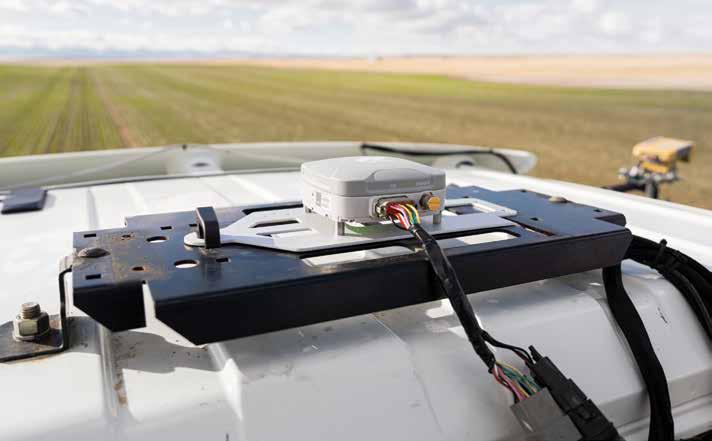

 Sean Weith.
Sean Weith.
A passion for science, and crop protection in particular, means FAR is a natural fit for new researcher Sean Weith.
Sean joined FAR at the start of the year, focusing on herbage and vegetable seed research in collaboration with Richard Chynoweth.
His appointment coincides with Phil Rolston’s departure into the role of technical advisor at SIRC.
Sean says he has always had a passion for studying plant pathogens and how to control and manage them in different agricultural crops.
His primary experience in arable comes from his 10-year involvement with Bayer Crop Science in Canterbury.
He worked as a casual field trial assistant for the first eight years while pursuing his master’s and PhD degrees and then as a full-time field agronomist for the last two years after completing his PhD.
Since joining FAR, he has been involved in a project considering white clover desiccation options, as well as the control of downy mildew in cocksfoot.
Some crossover with cereals is also possible, particularly around general agronomy and disease control.
Sean’s expertise in data collection and research reporting will help increase FAR’s research output, so results can be shared more quickly with growers.
He says it is great to be
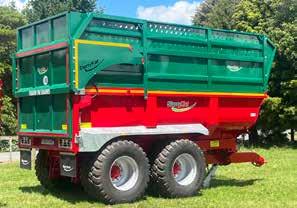
involved in extension work, where he is able to interact directly with growers.
FAR partially funded Sean’s master’s degree at Lincoln University, where he focused on investigating tan spot in wheat, marking his first involvement with the organisation.
Tan spot, caused by the fungus Pyrenophora triticirepentis , is a destructive and economically significant foliar disease of wheat which has been increasingly occurring in New Zealand.
As part of his master’s project, Sean undertook a survey of wheat growing areas around the country, collecting samples of the fungus from each site and using molecular biology approaches to characterise the genetic diversity among different populations.
He then went on to complete a PhD two years ago.
For his PhD, Sean studied the complex interactions between the legume white clover with different strains of nitrogen-fixing bacteria known as Rhizobium.
His work investigated the plant genetics in the cloverRhizobium interaction and explored how this information could be utilised to produce new white clover cultivars with enhanced interactions with Rhizobium.
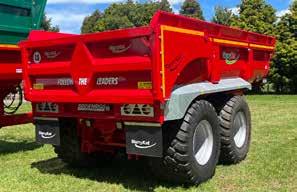



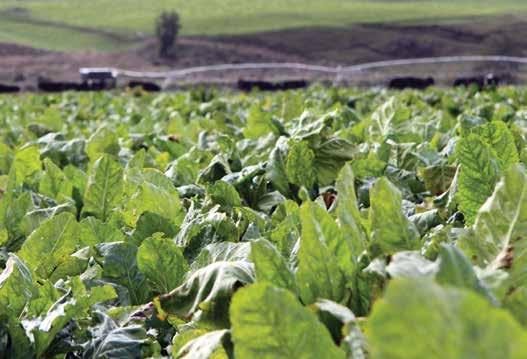
New Zealand’s most comprehensive farm nutrient management tool OverseerFM has improved the software’s crop modelling capabilities.
The extensive crop changes incorporate new information available from New Zealand cropping specialists at Plant & Food Research.
The update includes the addition of new crops, adjustments to enable a better representation of what is happening in a farm system and software updates to make it easier for growers to enter farm information.
Alastair Taylor, business development manager for OverseerFM, says the upgrade removed the ‘seasonal’ variations of crops to describe and estimate the impact of how crops are farmed more appropriately.
“Previously, one of the issues was that the growth of a crop was fixed in the model. The growth time was set at a national average value.
“If you grew a crop for only three months when the national value was six months, the model would go through a six-month process, which would limit the accuracy of the model.
“Under the new model, crops now have a farm-specific growth curve and are more representative of what is actually happening in the farm system.
“Users can now also specify product loss occurring in the field. For instance, a broccoli crop might have five to ten per cent of spoiled heads left in the paddock.
“These have grown and taken up nutrients. The model can now allow for field loss of damaged crops, which will be incorporated into the results.”
The update has also added four new crops, chickpea grain, pak choi, rape green manure and turnip green manure,
and now allows for further additional crops to be more easily added.
An issue around the modelling of fodder beet has been resolved and modelling has been reviewed for crops of broad beans, green beans, cauliflower (winter/ spring), cabbage (winter/spring), spinach, oats and rye, broccoli (summer), turnips (leafy), cabbage (summer), and radish.
Overseer and independent scientists have been assessing the tool’s reliability in a range of areas including deeper-rooting plants, the effects of different climate data sets, multi-layer soil and sensitivity and uncertainty.
Analysis of the impact of deeper-rooting plants on N-uptake below 600 mm found that N-uptake will generally occur only when there is insufficient nitrogen available above 600 mm. OverseerFM was updated to incorporate N-uptake by deeper rooting plants with a software release in late December 2022.
“The model sensitivity and uncertainty work really emphasised the importance of a farm’s geophysical characteristics – where it is, what climate it is farmed in – things which our farmers consider each and every day,” Alastair says.
“Overall, the uncertainties for the OverseerFM estimates were in the range of other environmental models and the results were comparable for dairy, beef and sheep and cropping farms.”
The work to update the crop model began in 2020 with Overseer Ltd working with Plant & Food Research.
The first outcomes of that pro-
INDUSTRY NEWS
Fodder beet is one of several crops covered by the latest update.
gramme, updating crop parameters for some existing crops and significantly extending the number of crops that could be modelled, were added to OverseerFM in late 2021.
“We knew there were some ‘quick gains’ to be made in adding new crops and some cropping changes,” he says.
“We then went on to do the longerterm work, with support from the Ministry for Primary Industries. The work took into account the findings of an independent science review of the OverseerFM model, released in August 2021.
“It has taken some time, as it was complex work and difficult to incorporate into the model. However, as a result we now have something better for farmers and growers.
“Farmers may notice their numbers change but the main difference will be that the way crops are modelled should be more representative of what is actually happening in the farming system.”
The updates also mean it is now much easier to collect data for incorporating new crops into the model.
The update of the crop co-efficients table enables easier of crop coefficients by botanical relatedness and/or similar crop end use.
The ‘end N uptake crop’ function and the end use and/or planting time crop variations (seasonal variations) have both been removed, and the data entry required for crop selection updated.
The changes do not include any update to how pasture or pasture crops are modelled.
Overseer Limited is working hard to improve the understanding of OverseerFM and the way it should be used, says Alistair.
“One way to think about OverseerFM results is to view them more like a weather forecast than a measure you might obtain from a rain gauge or thermometer. Weather forecasts provide valuable insights and are continually improving, but nobody expects them to be 100% spot on 100% of the time.
“We will continue to develop OverseerFM to improve its utility, reliability, and usability. This will include providing insights and information that enables farmers to follow and communicate their progress so their hard work and investment can be recognised and rewarded.”
Further information can be found at www.overseer.org.nz.
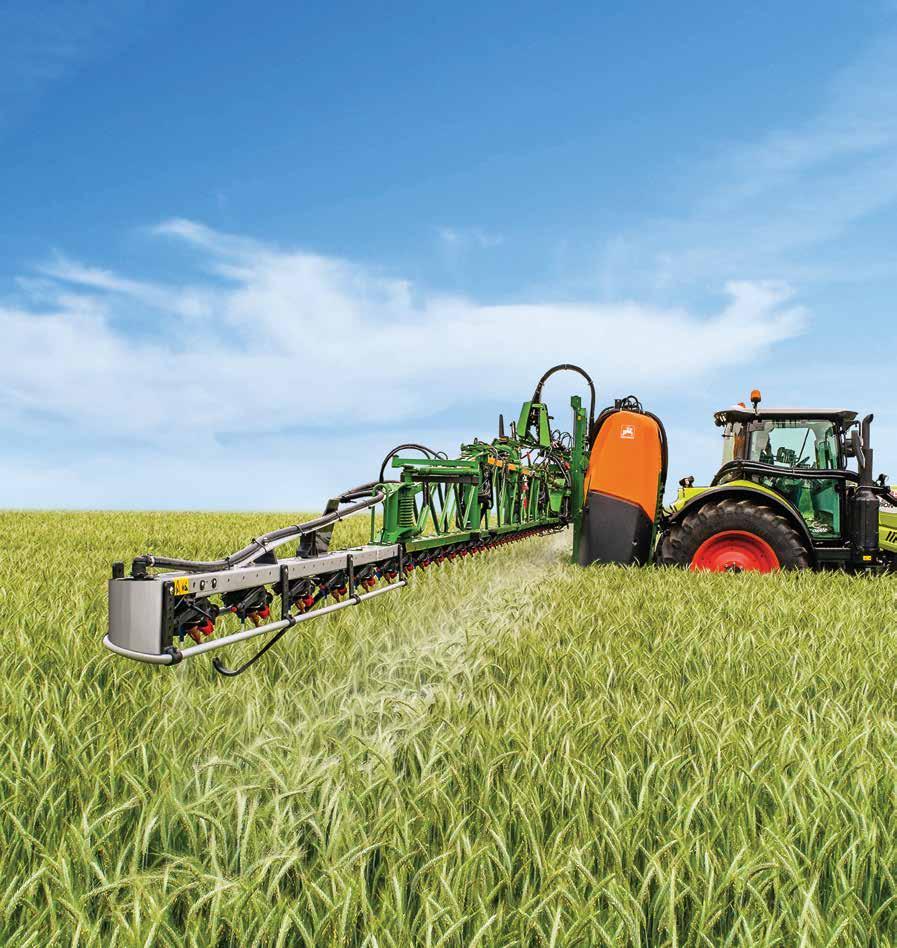
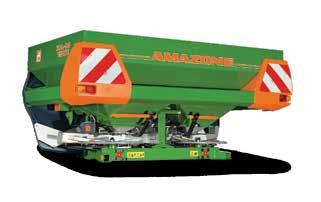
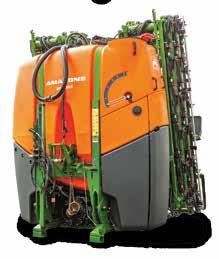
With the cost of fertiliser at a premium you need precision application. With hopper sizes up to 10000 L and working widths up to an impressive 54 m, we have a spreader to suit every farming operation.
AMAZONE is world-renowned for building of the most robust, technically advanced sprayers available. With tank volumes up to 11200 L and working widths up to a remarkable 40 m, we have a sprayer to suit every farming operation.
An introduced weed that already costs Australian grain growers more than $90 million a year is becoming an even bigger threat according to University of Queensland-led research.
Professor Bhagirath Chauhan from the Queensland Alliance for Agriculture and Food Innovation (QAAFI) has found for the first time that annual ryegrass is now germinating in summer in northern grain growing regions.
“This adaption is a potential disaster that could cost many millions of dollars across all cropping systems,” he says.
“Annual ryegrass has mainly been a winter weed in the southern and western regions of Australia, but recently we have seen it in Queensland.
“Not only is it germinating outside of the original winter window, but it is doing so in temperatures as high as 40 degrees and then growing to produce seeds in summer.”
Professor Chauhan says annual
ryegrass can spread quickly, often carried accidentally by vehicles or, in one case, by a hay bale which fell from a truck.
“Annual ryegrass can quickly spread from the roadside into a paddock and then grow alongside a crop,” he said.
“One ryegrass plant can produce more than 40,000 seeds, which can grow into 40 or 50 plants per square metre.
“Weeds like ryegrass compete for nutrients, water, sunlight and space and can harbour insect pests that will attack a food crop.”
Adding to the problem is the weed’s resistance to most herbicides.
“Farmers rely on glyphosate to control weeds in fallow areas and ryegrass has developed resistance even to that, which means it will produce seeds that
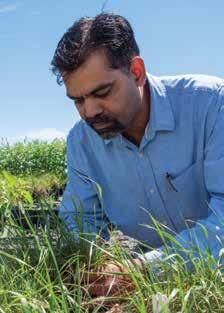
go into the soil’s seed bank and germinate over many seasons,” Professor Chauhan says.
“The plants will keep growing and costing farmers money every year which is why it is now Australia’s number one

▶ Easily grazed by stock due to the majority of the bulb sitting higher above ground
▶ Suitable for all stock types but especially suited to sheep and young stock

▶ Latest fodder beet genetics available
▶ Consistently high yielding in all on-farm trials to date
▶ Large top growth
▶ Suitable for sheep, cattle and deer for grazing in-situ

▶ Reliable even germination
▶ Large top growth with excellent green leaf retention late into season
▶ Very good bolting tolerance
▶ Suitable for sheep, cattle and deer for grazing in-situ or lifted and fed out later

▶ All seed is pelletised with world leading technology and coated with insecticide and/or fungicide-only options
▶ Available in handy 50,000 seed boxes
▶ Contact your local Cropmark representative for more information
New Zealand’s high quality seed is respected at home and abroad because of a highly capable industry applying rigorous certification standards and processes.
WORDS: NEW ZEALAND PLANT BREEDING AND RESEARCH ASSOCIATION
This has resulted in our industry enjoying significant premiums for its certified seed compared to uncertified seed in our domestic and international markets.
To keep pace with technology advances and to meet new regulatory requirements, a new online seed certification system has been designed.
Owned by the NZ Seeds Authority, a body representing farmers, seed companies and seed processors, the platform is thought to be the first in the world to utilise digital mapping technology to verify the area and location of certified seed crops.
This feature reinforces the global status NZ has as being a trusted producer of seed that is true to type.
The new Seed Certification Information System (SCIS) is being developed with significant non-financial contribution from AsureQuality and significant oversight by the Ministry for Primary Industries.
MPI oversight is to ensure SCIS is a tool that will provide the verification required by the ministry to enable it to issue credible OECD seed certification assurances to our export partners.
Crops planted this season for harvesting in 2024 will be the first ones to be entered in the new system.
The most significant change users of the new system will notice is the complete removal of paper-based application forms – all this administration will be completed online.
Growers will also find that the system has lots of smart tools to help them check the eligibility of their crop applications for certification and manage the information needed when they deliver their harvested crops into processing stores.
problematic weed in grain cropping systems.”
Professor Chauhan said more research is needed.
“We need to study why this plant is growing outside of its normal window
The new SCIS has been funded out of contributions directly from all value chain stakeholders as well as investment from the SFF Futures.
Certification assures the customer that the purchased seed retains varietal identity, genetic purity, and high-quality standards.
Seed crops, ranging from arable crops, brassicas, and herbage grasses to legumes are checked throughout the growing cycle by growers, merchants and AsureQuality field inspectors to ensure good quality control, consistency and genetic purity.
Once harvested the seed is sampled
Ryegrass is New Zealand’s top certified seed crop.
and analysed by government-accredited laboratories to assess germination and purity.
According to interim statistics issued by AsureQuality the total area of certified seed in NZ is around 44,000 hectares.
An analysis of the different varietal groups shows herbage and amenity grasses represent around 70 per cent of the total certification area. The second leading group was legumes with around 16 per cent of the hectarage, followed by brassicas at 8 per cent and arable crops with 5 per cent of the area.
The top certified seed crops are ryegrass, clover, and cocksfoot.

and why it’s happening in Queensland and northern New South Wales,” he said.
“We need to learn from the experience of the southern and western grain regions to ensure we don’t get to the
point where it’s really difficult to manage.”
The research was published in Weed Technology and enabled through Grains Research and Development Corporation investment.
In a hot dry summer, what’s the next best thing to a dewy night for cutting perennial ryegrass seed crops?
It might just be a light sprinkle of irrigation.
Depending on seed moisture content, a few millimetres, maybe as little as 5 mm, to dampen the canopy shortly before cutting could be enough to increase your yield of saleable seed by up to 200 kg/ha, with no subsequent quality issues.
It will take more trials to substantiate this. But indications from the first years of research show it is worth further investigation among other strategies to reduce ryegrass seed loss at harvest.
With memories of the 2022 nightmare wet harvest still far too vivid for some growers, FAR’s Richard Chynoweth is quick to point out this particular technique would only help when crops are already well ripened by nature, when the seed head being just that little bit too dry increases risk of shattering.
In 2023 harvest conditions, Base perennial ryegrass dampened with the equivalent of 8 mm irrigation one hour prior to cutting yielded more machinedressed seed than seed simply windrowed as normal.
This yield advantage oc-
curred at 39% (+311 kg/ha) and 45% (+219 kg/ha) seed moisture content, suggesting some seed loss occurred at cutting in the hot dry conditions experienced at the time.
No difference in yield was shown for irrigation applied at between 24% and 33%. A lack of irrigation response at 33% suggested the crop was damp enough from overnight rain, while no response at the lower SMC suggested the easier to lose seed had shed due to environmental conditions prior to windrowing.
Richard and fellow researcher Owen Gibson are repeating the trial again this season as part of an on-going Seed Industry Research Council (SIRC) project.
“We know a dewy night will give you less seed loss at cutting than if conditions are dry, reducing losses by ~100 kg/ha. That’s consistent between New Zealand and Oregon. But often of course when the nor’west is blowing we don’t get a dew,” he says.
“It’s too early to say for sure if we can simulate the same effect with irrigation when conditions are hot and

dry, but there could be 200 kg per ha in it, so we’re planning to continue collecting data.”
They’re hoping to compare windrowed ryegrass seed with disc mown for the irrigation experiment, but this has yet to be confirmed for the 2023/24 trials.
Compared with 20 years ago, when it was not unusual to record as much as 1000 kg/ha of saleable seed lost at harvest, and 500 kg/ha was common, growers’ losses today appear much reduced.
“We’re a lot better at judging the cutting window now. When FAR last did harvest loss assessments in the mid
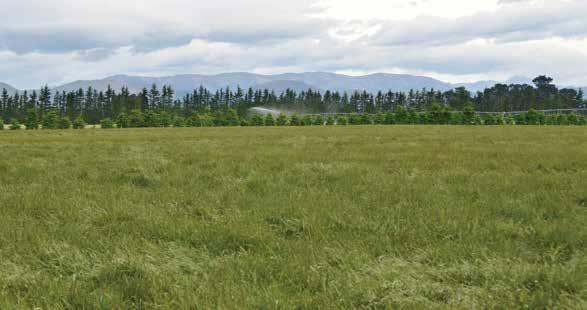
2000s, many losses were due to seed falling out before cutting.”
“The big difference now is that growers appear much more aware of the potential losses, weather forecasting is better and generally we cut before the seed is lost,” Richard says.
That said, there’s still room for gain, especially given both the wide range of heading dates now grown for commercial harvest, and the corresponding risk posed by increasingly unpredictable weather patterns.
In 2023, with the Base perennial ryegrass crop used for the SIRC trial, seed moisture was lost at 1.5% SMC per day from early January, and seed yield was maximised when cutting occurred at or above approximately 39% SMC.
Dressing losses were highest when the crop was windrowed at or above 45% SMC, indicating seed fill was incomplete at cutting.
But those results were for just one late heading date cultivar (+22 days), in one particular set of largely
warm, dry harvest conditions.
With a gap of 20 days or more in flowering between early and late heading tillers within the same crop, striking the Goldilocks zone between cutting late-maturing seed heads too soon, and early-maturing seed heads too late, is a balancing act.
Shattering at low SMC before or at cutting remains the main cause of seed being left on the ground, and losses can be deceptive because they don’t always show at the time of cutting but fall out of the row during dry down.
Richard and Owen will again investigate optimum harvest timing for perennial ryegrass seed in the coming season.
Also scheduled for a repeat is testing the use of a crop desiccant to improve harvested seed yields.
Year one work in 2022/23
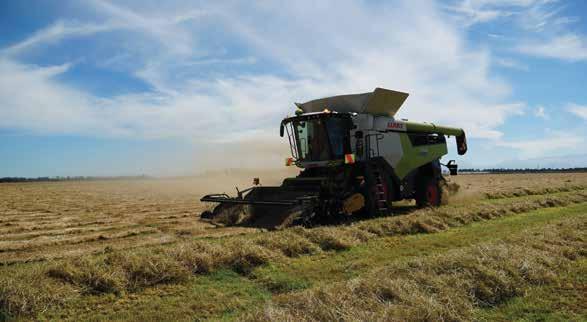
followed on from the really wet harvest in 2021/22, Richard says.
Applying a desiccant to reduce SMC prior to harvest could reduce the time from cutting to threshing, and/or reduce ryegrass re-growth following cutting.
Historical research from the United Kingdom however showed applying a preharvest desiccant resulted in a high level of abnormal seed and low germination rates.
“Re-growth after cutting was quite a bad problem for anything with a heading date
of +14 days or more in the 2022 harvest, and there was a lot of grower enquiry at the time about desiccation as a salvage tool, so we wanted to look into this particularly regarding any impact desiccant might have on seed quality.”
Glyphosate was thus applied to the Base perennial ryegrass used in last year’s trial three days before the targeted windrowing date.
This did stop plant regrowth after cutting, and seed yield results for this treatment looked similar to
those achieved with no desiccant, but germination results have yet to come back from the laboratory, Richard says.
Ryegrass seed is considered to have reached physiological maturity at approximately 37% SMC.
At physiological maturity the seed stops feeding, and as such cannot translocate chemicals into the developing seed. However, the seed may still be vulnerable to direct chemical uptake while it remains green.
For more detail contact FAR.
The all-new Continental Farm Tyre range has extra grip to help lower fuel costs and get the job done faster. There’s extra resistance, with N-Flex technology to absorb deformation and damage, for a longer lasting, more comfortable ride. All backed by 10 year manufacturer's warranty. It all adds up to a better season, every season.
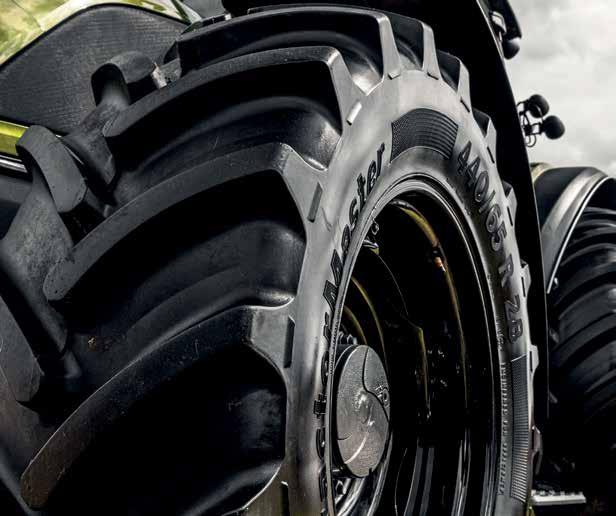
As seed crops go, plantain is far from a heavy hitter.
Only 165 ha were grown for certification last season, placing it between phacelia and meadow fescue, and measuring less than 1% of the area sown for certified perennial ryegrass seed.
But phacelia, meadow fescue and even perennial ryegrass aren’t getting half the end-user publicity plantain continues to get.
And where there’s demand for seed, there’s also demand for finding ways to grow better, higher yielding seed crops.
So it’s no surprise that Seed Industry Research Council (SIRC) trials are once again in the ground this autumn to help fine-tune recommendations about the yield effects of nitrogen and fungicide in particular.
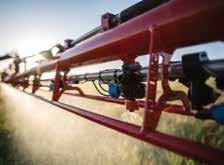
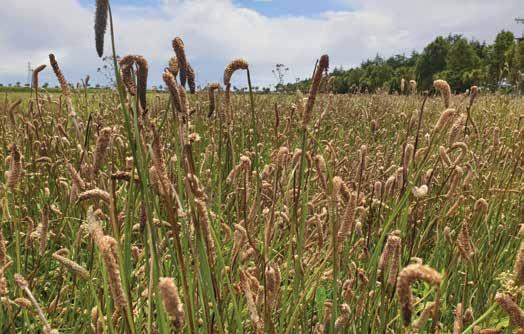
These are the latest steps in an on-going programme which began in 2018/19 to get growers closer to what Richard Chynoweth from FAR says is plantain’s commercial yield potential of 3000 kg/ha or more.
“It can produce really well. But right now we probably only achieve half of that potential at best, at 1500-1600 kg/ha, with average yields perhaps 1000-1200 kg/ha. There’s a very wide variation between crops, so it’s hard to know for sure.”
It’s not an easy crop to grow, he says.
“You can’t use much in the way of broadleaf herbicides, so there aren’t
Then there are pests to consider, like plantain moth and slugs, as well as disease.
“Plantain moth is a problem in seed production – it needs to be controlled around the time of seed head emergence and flowering – and slugs love it too. They’re not an issue once the plantain is established, but can cause massive problems for following crop.”
Phomopsis stalk disease, which results in stem collapse below the plantain seed head, is a major challenge, because affected stems commonly produce no saleable seed.

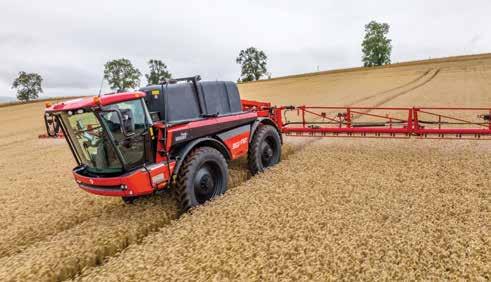
It’s also severe in second year crops, -

FARMERS GROW CROPS SUSTAINABLY
Capacity, capacity, capacity and extreme endurance with the Condor range of sprayers from 5,000-8,000 litres.
The most innovative sprayer in the world. Condor offers the most stable spraying with StabiloPlus, every drop hits the right spot and booms available up to 55 m.
Full circulation and no rest liquid with GreenFlowPlus. Optimal control and intuitive operation with EcoTronicPlus.
(topographic, soil type or pest maps) combined with boom mounted cameras to reduce chemical usage.

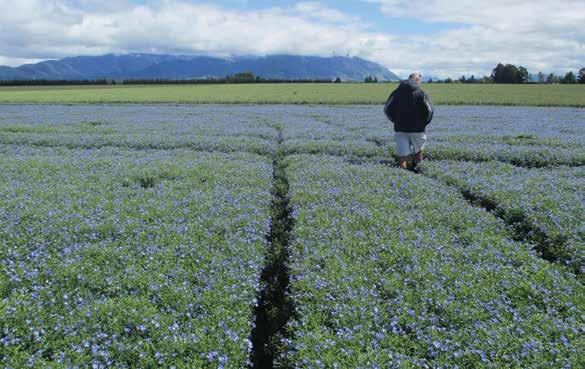
That’s the question behind a new trial and demonstration area that went into the ground in late April and early May, at the FAR Arable Research Site at Chertsey, and on commercial farmland.
FAR’s Ivan Lawrie, who is involved with new value chains, says that while there is farmer interest in growing more linseed, it has to be a viable crop.
“There’s not a lot of information on current commercial crop yields, but from what growers tell us, they can achieve over 3.5 tonnes/ ha. We want to see if we can improve that for higher returns.”
FAR is working with Bio Oils New Zealand which already contracts and manages linseed crops in Canterbury for oil extraction for export and domestic markets and is looking to identify cultivars with the right quality parameters.
Daryl Prebble, head of production and quality con-
trol for Bio Oils, says the best yield recorded by its growers so far has been 4.8 tonnes/ ha.
As well as measuring the yield difference between different sowing dates, FAR also wants to find out if some of the new linseed varieties from overseas present any advantages over the ones that are used now, Ivan says.
Up until this year all linseed has been planted in the spring because this suits growers’ rotations and the cultivars available, like Juliet, Bilton, Bilstar, and Hinau are best suited to spring sowing.
Autumn sowing linseed has the potential to make more rational use of land over winter, Ivan says, and both basic principles and overseas evidence suggest that the longer the crop is in the ground, the more biomass it accumulates and the higher its seed yield.
Four cultivars have been autumn-sown this year, comprising one commercial
standard (Bilton) and three winter breed imported lines. Their performance will also be compared to spring sowings of other suitable cultivars to understand if autumn sowings present an advantage.
Agronomic benefits of linseed for growers include providing an alternative break crop from grass-type crops, increased diversity in the rotation and the opportunity
Linseed grown in New Zealand has some of the highest alpha-linolenic acid (ALA) levels in the world.
to address soil health and hard to control weeds.
Ivan says there is a fledgling export market for high value NZ grown linseed oil for human consumption, thanks to its highly concentrated alpha-linolenic acid (ALA) levels.
NZ produces seed with some of the highest ALA levels in the world, Daryl says, and the crop is ideal for Canterbury.
“Canterbury is the best region in NZ for growing linseed due to the soils, climate, day to night temperature variations and growers’ management skills.
“Linseed is well suited to any Canterbury soil type with most lighter soils now being irrigated. Each region requires slightly different management depending on the location and season.”
The crop is ideal for Canterbury.
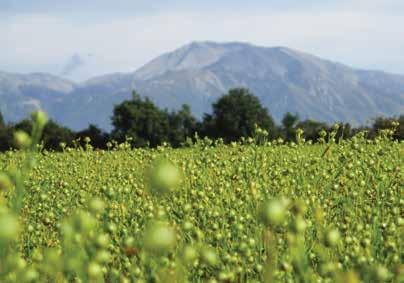
comes an annual crop.
Richard and fellow FAR researcher Owen Gibson have confirmed fungicide treatment to control phomopsis significantly increases plantain seed yield in both first and second year crops. They are now investigating different modes of action.
Growers are currently heavily reliant on prothioconazole (Group 3), so fungicide treatments for this year’s plantain trials now in the ground at the FAR Arable Research Site at Chertsey will be extended to bring in other groups.
They will also repeat trials on seed yield response to spring nitrogen, as pre-
vious research has been inconclusive, Richard says.
“We have one set of results which showed that spring nitrogen did positively influence seed yield, and one which showed that it didn’t, so we need to firm that up.”
For more detail contact FAR.
A quick way to assess the biological health of soil has been developed using molecular techniques to measure earthworm activity.
But this needs more work before it’s ready for use on New Zealand farms.
Roger Hill of Hill Laboratories imagines a day when farmers can not only test the fertility of their soil but, using the same samples, also get an assessment of their soil health based on the level of earthworm activity from traces of their DNA found in the soil.
“Currently earthworms are assessed by going out to a field and taking a spadesquare down to the depth of the spade, taking that soil, breaking it up and counting the earthworms. We realised that perhaps we could use our capability with DNA testing to develop a faster and more convenient earthworm test,” Roger says.
He also says that interest in the health of our soils, beyond the common measures of fertility, is growing both among farmers and consumers.
Earthworms are a key component of the soil biology and abundant populations are recognised as a sign of a healthy soil.
Current methods used to identify earthworm populations are labour-intensive.
Roger says that while much is known about how to test the chemical and physical properties of soil, assessing its biological properties is less well developed.
“From what I’ve read, less than 5%
of the organisms that live in the soil have been identified. But when you talk about soil biological health, one of the first things that comes to mind is earthworms, and people associate good earthworm activity with healthy soil,” he says.
This study involved three different species of common NZ pasture earthworms – Lumbricus rubellus (epigeic), Aporrectodea caliginosa (endogeic) and Aporrectodea longa (anecic) – being hand sorted from soil samples (20 × 20 × 20 cm) collected from farms in Canterbury, Waikato and King Country.
Hill Laboratories’ scientists Lisa Hsu and Sara Loeffen worked with AgResearch scientist Nicole Schon on the project, funded by Our Land and Water via its Rural Professionals Fund.
“There was published information about DNA for those three types of worms, but when we took the literature data and designed a test around those it wasn’t completely successful,” Roger says.
“So our scientist Dr Hsu got some earthworms from Dr Schon and sent samples away for the DNA to be characterised and we went right back to first principles to develop the tests.”
Next was to develop a reliable way to assess actual worm populations from
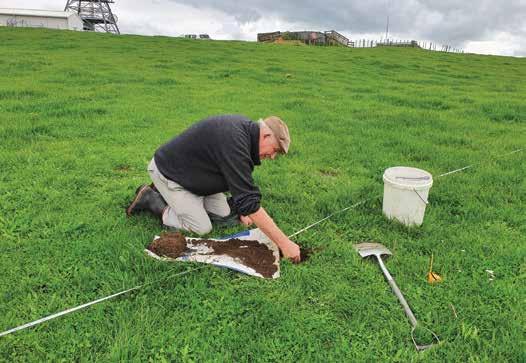
the DNA test results.
Spade-square samples were taken, the worms counted and then DNA levels in adjoining core samples measured.
The intention was to establish a correlation, and therefore derive a conversion formula that could then convert the DNA result into units that people are used to (i.e. numbers of earthworms per sq m).
Soil samples collected from five sites showed a good correlation between molecular and morphological assessment, good extraction efficiency and precision.
Further samples analysed during the validation stage of the project reduced the strength of correlation between the molecular and morphological assessment of earthworms. Investigation into the factors causing this are ongoing.
“Initially the first few samples looked promising, but then as we added more soils from different areas the correlation weakened significantly, to the point that as we finished the project we thought, ‘This isn’t good enough’,” says Roger.
Work is continuing beyond the initial trial to improve that correlation, selffunded by Hill Laboratories and with the support of AgResearch scientists.
“To work out why the correlation is not as good as we would have expected, we need to understand more about the stability of DNA residues in the soil and the behaviour of earthworms,” says Roger.
“In particular, we need to quantify the uncertainties associated with each of the two approaches (DNA sampling and physical counting).”
Factors now being studied include the stability of DNA in fresh soils, earthworm behaviour after heavy rain compared with when soil is dry, and the accuracy of taking spade-square samples in a paddock for assessing worm populations.
Several hundred samples will be taken to better understand those issues.
Roger says good progress was made in the Our Land and Water project, but not yet good enough for a reliable test that can be offered to farmers commercially, as was hoped.
“Because we do many thousands of samples a year for fertility testing, we would like to be able to do this test on the same soil sample as it has already been collected, dried and ground for the other tests. If it’s just a tick box to say, ‘I’d also
Roger Hill (Hill Laboratories) collecting worms from a spade-square sample.
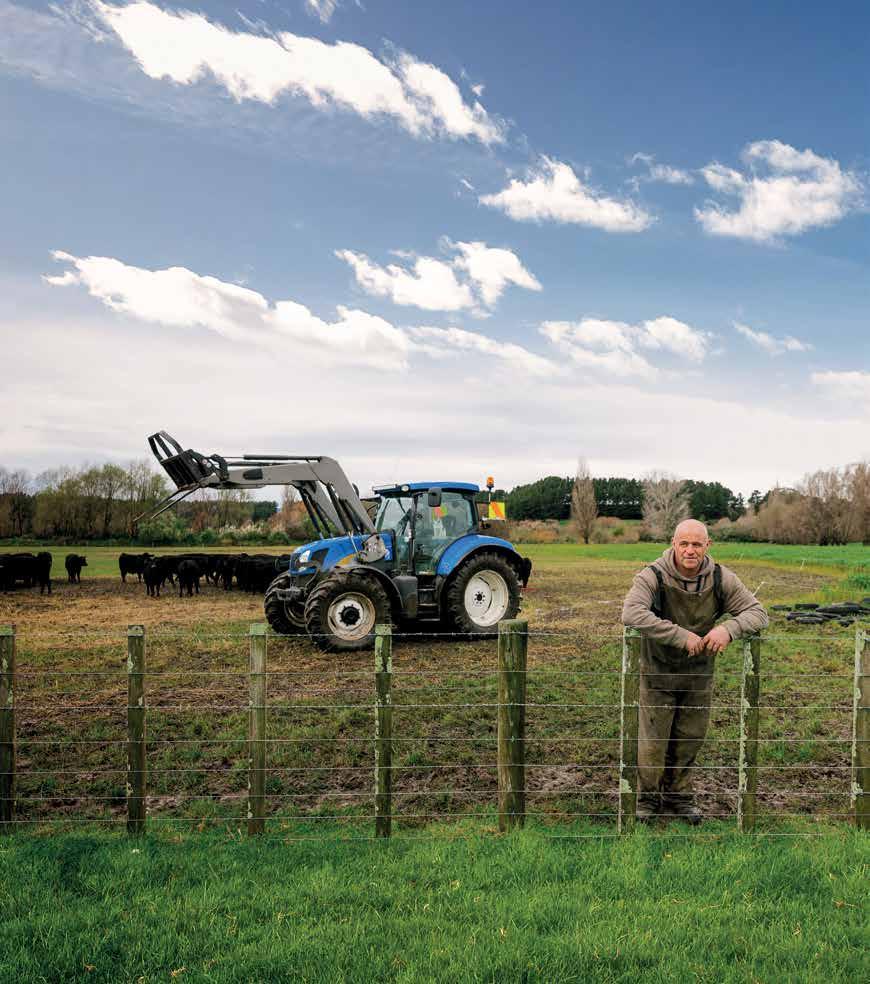

Earthworms were collected and sorted manually into three separate species.
like an earthworm assessment’, from a commercial point of view, that’s very convenient for everybody.”
What the uptake of such a test would be among farmers is difficult to estimate, Roger says, although he expects those interested in the biological health of their soils are likely to be very interested.
“With something like phosphate availability, a soil test may show it’s very
low, and if you put phosphate on you can expect a significant improvement in production.
“This new test won’t be quite like that, it’s more to provide insight about earthworm activity in the soil.”
Roger believes that with our overseas clients showing increasing interest in whether their food is produced in a sustainable manner, there could also be
• This study has shown that earthworm eDNA in the soil can be measured successfully and, in many cases, correlate well with the earthworm counts by traditional visual assessment.
• The project identified suitable primers for the most common earthworms found within each earthworm ecological group in New Zealand.
The test was sensitive to changes in earthworm abundance at individual sites. Further data needs to be collected prior to the test becoming commercially available to ensure confidence in the test developed, and the ability to predict earthworm abundance and diversity. SUSTAINABILITY
marketing advantage for Aotearoa.
“To be able to say to our overseas customers that we are monitoring the soil’s biological health with regular testing for earthworm activity, I think it could be useful as a marketing ploy, especially in terms of selling our produce at the top end of the market.”

No-one’s better placed than Arxada to formulate a slug pellet to make the most of META. That pellet is AXCELA. AXCELA slug pellets are produced using a unique wet-extruded production process.
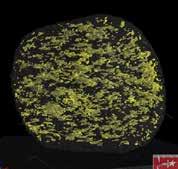
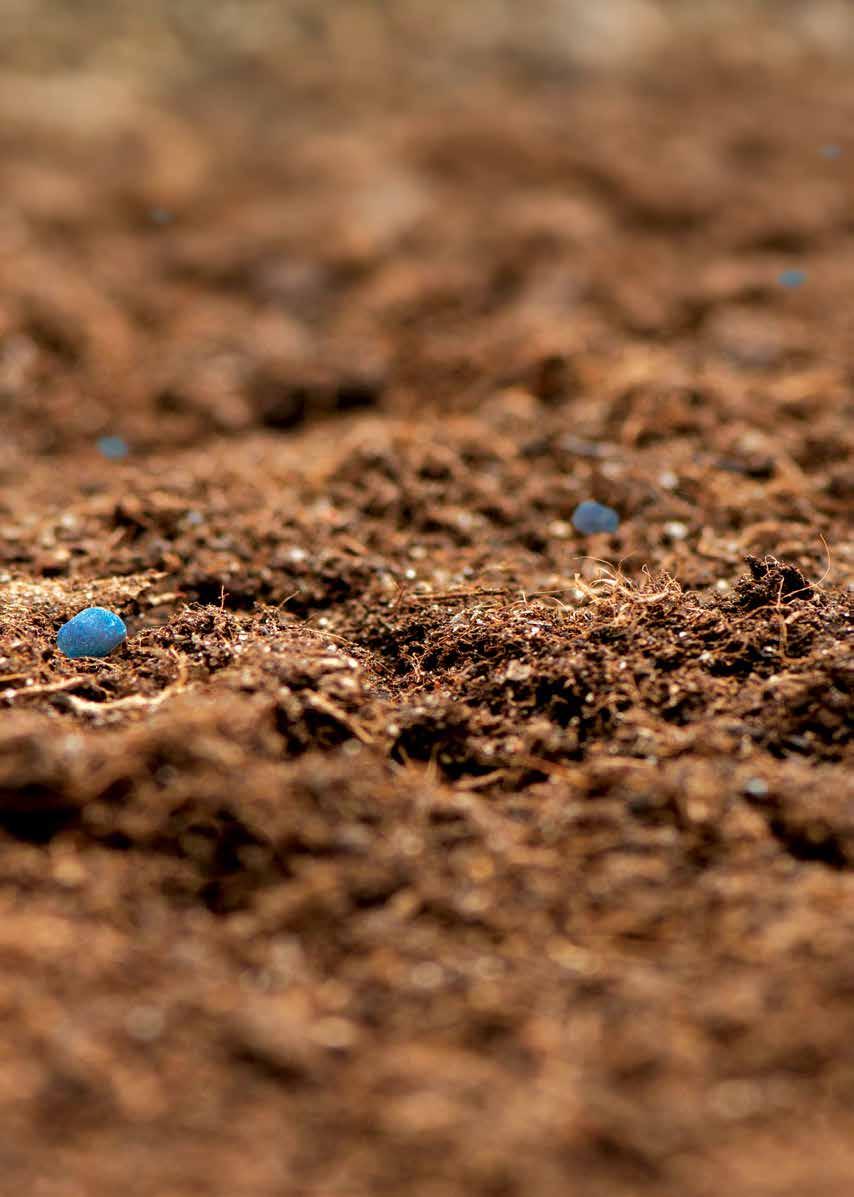
® AXCELA slug pellets are better because they have an immediate effect on a slugs ability to feed. Put simply, they kill more slugs, more quickly.

Väderstad Tempo gives your valuable crops the best possible start. Delivering unmatched precision, this high-speed planter gives exceptional performance in all conditions across no-till, min-till or conventional tillage operations.
Integration of livestock is a strength of the New Zealand arable farming system, but challenges lie ahead, a Mid Canterbury field day has been told.
The event, the first time the Foundation for Arable Research and Beef + Lamb NZ have combined resources to hold a joint field day, attracted about 150 farmers.
FAR senior environment researcher Abie Horrocks says NZ arable growers have some of the most diverse crop rotations in the world.
In comparison to arable soils overseas, the degree of livestock integration means arable soils are in better condition because rotations that include livestock can support inclusion of restorative crops, such as ryegrass, that build soil organic matter.
In addition to soil quality, nutrient cycling and cashflow, there are other reasons why arable growers have livestock.
These include weed control, natural tillering (managing height and bulk of grass seed crops), crop residue management and rotation fit.
In NZ, pastures hold 109 to 138 tonnes of carbon per hectare and cropping soils 90 t per ha (2018 Ministry for the Environment report).
This compares with 10 t per ha for some overseas cropping soils.
“This reflects the diverse rotations in the New Zealand arable system and frequent inclusion of restorative phases,” Horrocks says.
As new environmental and greenhouse gas emissions regulations come on-stream, regulators need to be wellinformed of the role livestock plays in an arable farming system.
“If soil quality declines, more fertiliser and irrigation may be required.
“Removing livestock from mixed rotations may have an unintended consequence of increasing pesticide use and if weeds become more problematic as a result it could introduce a risk to the production of weed and disease-free pure seed lines.
“Quality seed lines are the ultimate driver in an arable business,” she says.
Four Canterbury farmers outlined the importance of livestock to their arable farming operations.
Hamish Marr, who farms Longfield near Methven with family, says that animals, unlike crops, are not at risk of damage from hail, frost and wind storm.
Longfield winters 800 dairy cows as well as grazing 600 dairy heifers.
As the Marrs specialise in cocksfoot seed production, which is shut from grazing in June, compared with October for ryegrass, it was difficult to buy lambs and have them finished by then.
“Some years we made money, but a lot of years we didn’t.”
Instead, they changed their policy and now graze 4000 lambs for another farmer.
Longfield has 400 ha of arable crops, including cocksfoot, process peas, wheat, barley and red clover as well as 100 ha of pasture.
It has two separate cropping rota-
tions, one based around cocksfoot seed production and the other based on the pasture, with a five year rotation based around both.
“There is not a lot of chemical resistance in Mid Canterbury yet, but it is coming. Pasture and animal integration lengthens our rotation and the longer the cropping rotation, the greater exposure to different modes of management,” Hamish Marr says.
Westerfield farmer Darryl Oldham, who farms a 200 ha family property, says he initially grazed dairy cows in winter but for environmental reasons went back to lambs which provided a lot of flexibility around the timing of buying and selling.
FAR chairman Steven Bierema, who hosted the joint field day, says the winter grazing of livestock plays an important role on his Mitcham farm near Rakaia, which is fully cropped in summer.
The 500 hectare farm buys in 4000 lambs in March and April for finishing as well as winter grazing 400 dairy cows.
Steven farms in partnership with his son Pieter Taco Bierema. They grow ryegrass, clover, pak choi, garden peas, marrowfat peas, maize, barley and milling and feed wheat. Land is also leased to others for growing lilies and potatoes.
Finishing of lambs is closely linked with ryegrass, with the last of the lambs sold to the meat works in mid-October when the last paddock of ryegrass is closed for seed production.
On arrival, lambs are given a vaccine and after a feed transition period grazed on former clover seed paddocks
Four Canterbury farmers outlined the importance of livestock to their arable farming operations. Hamish Marr, of Methven, speaks during a farmer panel session made up of, from left, Darryl Oldham, Pieter Taco Bierema and, far right, Erica Callaghan.

until the end of May. Left to regrow after being harvested in February, these produce 3000 kg of DM/ha.
This is then sown in milling wheat, utilising the extra nitrogen in the soil from nitrogen-fixing clover.
In winter, lambs are grazed on greenfeed oats, which are drilled after either peas or cereal crops.
Dairy cows are winter grazed on kale and some short rotation Italian ryegrass after peas.
“It sounds complicated, but it is not. The cropping and the lambs in winter really complement each other,” Steven Bierema says.
“We try to maximise it as much as possible with the farm in full production all year. There is always something growing, either for crop production or livestock.”
Arable farmers need sheep farmers to breed lambs for them to graze, while sheep farmers need an outlet for store lambs they are not able to finish themselves. “We need each other.
“Lambs only work for us if we can crop the whole farm in summer and fin-
ish lambs in winter and not have ewes ourselves, especially under irrigation.”
This year, the Bieremas’ lambs were predominantly sourced from South Otago.
Tom Fraser, formerly of AgResearch, suggested forming long-term supply and grazing relationships with sheep farmers.
“A lot of hill country farmers struggle to rear their ewe hogget replacements, so like to send them to grazing in autumn and bring them back in spring.”
Hamish Marr says that in grazing relationships, farmers have to be prepared to compromise.
“You can’t go in thinking you will win every time; there has to be mutual benefit for both.
“Those people are there. Ask the agents about people wanting hogget grazing or a permanent solution to getting rid of store stock.”
North Canterbury Vets Clinics veterinarian and Wormwise facilitator Sarah Williams says drench resistance is now common and about a third of New Zealand sheep farms have worms resistant to all three drench families.
“For arable farmers, the biggest risk
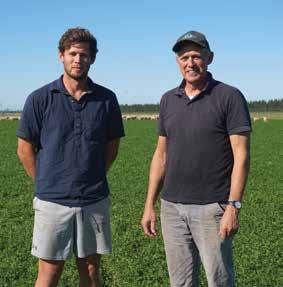
Steven Bierema and son Pieter Taco with lambs grazing a harvested clover seed crop. Winter finishing of lambs fits in well with their cropping operation.
is buying in animals with resistant worms.”
Farmers are advised to avoid unnecessary drenching and to develop an animal health plan with their vet.
No new drench families are coming and research and development spending in this area is declining, Sarah Williams says.
“Start developing systems that are not reliant on drenches.”

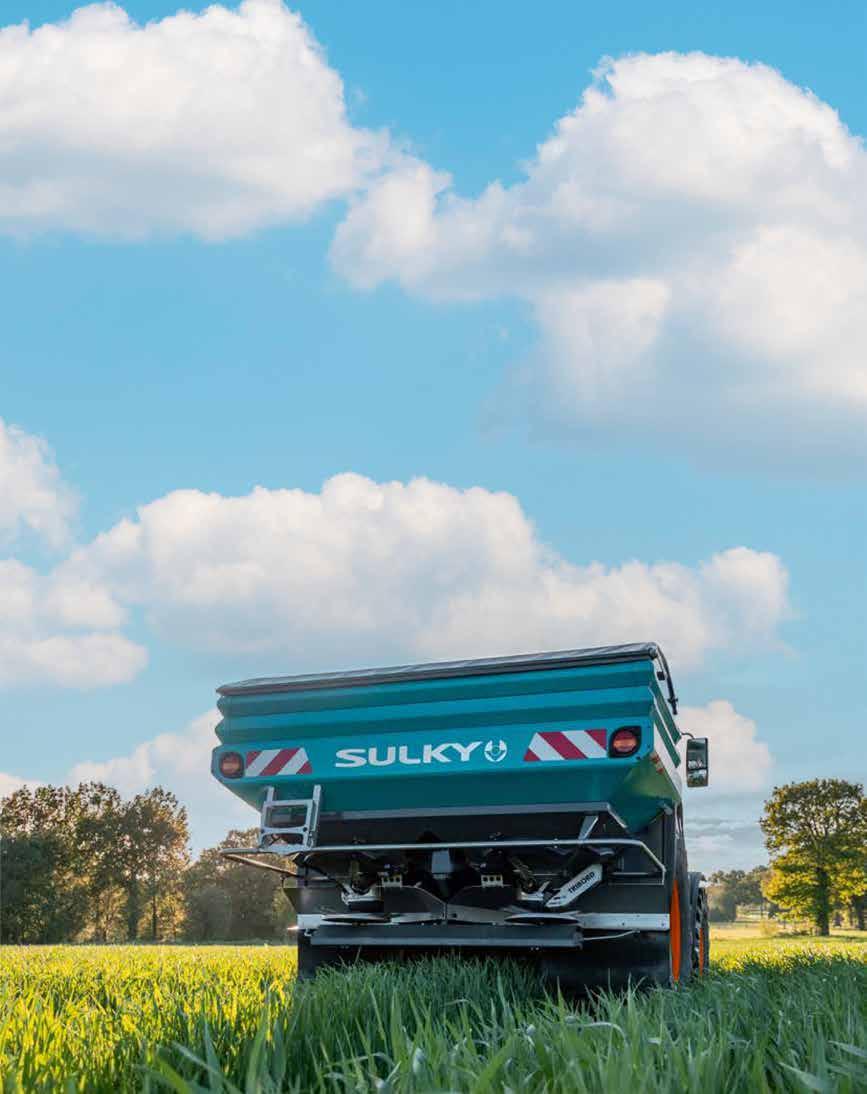
Even distribution is guaranteed with the Sulky X 40 ECONOV fertiliser spreader.
Hopper capacity ranges from 1900 to 3000 litres and working widths of between 18 to 44 metres make getting uniform coverage across the paddock a breeze.
Plus, with a seven-year paint warranty you know the ECONOV will go the distance.
There’s nothing like a real-world insect pest incursion to test theoretical computer models of how such an unwelcome visitor might spread across New Zealand.
In this instance, confirmed reports of fall armyworm (FAW) surviving the NZ winter last year largely matched the overwintering risk hotspots that had been flagged in modelling work done by the Better Border Biosecurity (B3) consortium.
In turn, says FAR biosecurity spokesperson Ivan Lawrie, actual on-farm FAW findings have now been fed back into the model to help refine it further.
It’s one example of col-
laboration between B3 and FAR, through the Seed and Grain Readiness and Response (SGRR) partnership, on multiple projects, including some PhD scholarships, which seek to model scenarios for dispersal of pests and diseases under a changing climate.
It would be nice to think such tools would not be needed.
But if 2022/23 showed anything, Ivan says, it’s that NZ arable cannot afford to drop its guard for a moment.
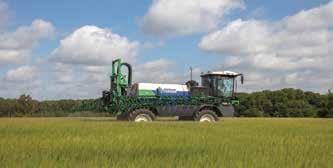
• 4000, 5000 or 6000 Litre capacity
• 24-36 metre options
• Househam TMC (Total Machine Control) with Fieldmaster GPS and autosteer
• Improved Air Ride suspension

• Option of Caterpillar or MTU Engine
• New category 4 cab with improved layout and lighting

Between new and unusual climatic patterns that are already altering the pest and disease status quo and our position as a trading nation, reliant on imported seed to maintain our multiplication and export markets, the risk of biosecurity incursions is not only with us permanently, but will be ever-changing, he says.
FAW’s spread from Kaitaia to the West Coast of the South Island, with 139 confirmed reports, was itself indicative of the mild weather conditions that prevailed throughout the 2022/23 season.
“There will be research undertaken this year to better understand its distribution, biology and control within NZ,” Ivan says.


• Specialised fertiliser spreader designed for professional users
• Perfect variable width & rate spreading
• Auto turn on and off at headland
• Isobus operated 12 section control
• Versatile Lime & Fertiliser spreader
• Two large spreading discs distribute Bredal’s signature 4 x overlap
• K45 – K165 models, trailed. Option to truck mount
• 3500 – 19,000 L capacity
• Working widths: Lime 12m. Fertiliser 12 – 36m
Crop scouting, trapping at key sites and awareness raising will continue, while research will be targeted at understanding potential green bridges, the pest’s overwintering capabilities, biological control, insecticide efficacy and management and the development of an online FAW alert tool using real-time climate data to provide growers with an indication of highrisk periods.
FAW is no longer classified as an unwanted organism now that the initial incursion response has finished and moved to long term management, so it is not mandatory to report finds.
But significant observations are important, so FAR is asking growers to record them and inform it.
Further, Ivan says, any information on new host plants will be welcomed as researchers begin to understand overwintering capabilities and green bridges.
FAW has been observed on ryegrass and clover in a harvested maize paddock, and volunteer maize should not be overlooked either.
Meantime blackgrass resurfaced on two properties in Canterbury in February, from a line of imported linseed seed from France.
Crops were subsequently destroyed on three proper-
ties deemed to be of highest risk, as was the remaining imported seed, and an ongoing surveillance plan is underway, Ivan says.
SGRR in partnership with the Government Industry Agreement (GIA) is facing the costs for this response, including compensation for growers affected.
Most recently, nine velvetleaf plants were found in a mid Canterbury paddock during routine surveillance before Easter. The paddock is associated with the 2015 velvetleaf incursion via imported fodder beet seed.
“To date, all plants have been removed and no others found. Surveillance remains active on that property.”
With FAW, blackgrass and velvet leaf, it has been a ‘particularly active’ year for SGRR, Ivan says.
And the single best thing growers can do to protect not only their crops and properties but the industry as a whole is to remain constantly vigilant for anything that looks suspicious, whether it’s a weed or an insect pest.
“There is no substitute for active monitoring of crops, and contacting us if they see something that is not quite right.”
For more information, contact Ivan Lawrie at FAR or visit www.mpi.govt.nz.
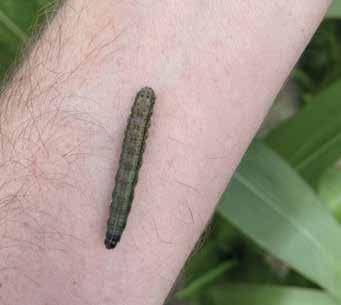
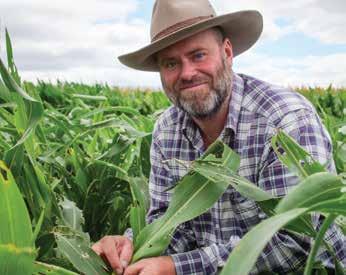
University of Queensland is working with the Queensland Department of Agriculture and Fisheries (DAF) to develop guidelines to help Australian grain growers decide when and how to treat fall armyworm (FAW) to save their crops and finances.
Dr Joe Eyre from UQ’s Queensland Alliance for Agriculture and Food Innovation (QAAFI) is working with DAF on the project, which has investment from the Grains Research and Development Corporation (GRDC) and will determine economic thresholds for the pest to give farmers certainty.
“The overseas recommendations for treating fall armyworm are vague, and we don’t know how they relate to the Australian environment,” Joe Eyre says.
“The current recommendations are to take action based on obvious damage from the caterpillars, which may not be the most economically efficient or ecologically friendly time to protect crops.”
The research project will establish the relationship between the timing of an infestation, its density and the crop’s response.
“Fall armyworm are easy to treat when small so we need to predict what the likely yield loss is going to be if the infestation is not treated, as opposed to spending money on treatments when it is too late or when FAW are unlikely to result in yield penalty.
“The development of these economic thresholds will be absolutely fundamental to the management of fall armyworm in broadacre crops.”
DAF’s Dr Melina Miles says field trials in maize and sorghum at UQ’s Gatton campus are providing important data.
“We haven’t had a severe defoliating pest before and most producers haven’t seen a shredded crop, so there’s a lot to learn.
“Australia’s grains industry is used to having economic thresholds on which to base decisions about crop management and farmers are crying out for guidance because fall armyworm is so damaging and new.”
The guidelines will be finalised by June 2024, but Dr Eyre and Dr Miles are already presenting their work at industry conferences.

either
Ivan Burrows - ivan.burrows@trelleborg.com or register online at www.trstyreandwheel.co.nz/optimisation
A decade of New Zealand wheat breeding has started to come to fruition for PGG Wrightson Grain with the pending release of not just one but three new milling cultivars in the next two seasons.
And if that isn’t enough to make growers sit up and take notice, the company is also launching a new feed wheat and a new triticale, both of which have emerged as leaders in its continual screening of new genetics from overseas breeding partners.
Grain product development manager Nick Brooks says being able to offer growers and end users multiple new cultivars which have all proven themselves to bring measurable performance gains is both exciting and fulfilling for the PGG Wrightson Grain team.
“You wouldn’t normally be in a position to release so many new options at once. But it’s been 10 years since Steve Shorter began the breeding programme here, and we’ve now reached the point where the first lines are ready to be commercialised.
“And we want growers to be able to benefit from these advances without delay.”
So is this a sign of things to come?
“Absolutely. The full breeding cycle from choosing parents to the first commercial crops is typically eight to 10 years. We’re now at full capacity in terms of the number of crosses made and subsequent lines coming through the pipeline and have a number of exciting varieties emerging at the top end.
“We wanted to increase our milling wheat offering hence the focus of the breeding programme for the first four years was solely that. We added a substantive feed wheat breeding effort six years ago.”
In milling wheat as with all new cereals PGG Wrightson Grain releases to NZ growers, cultivars must demonstrate genuine gains to even be considered for market launch, Nick says.
“Grain yield is still first, second and
Testing times – PGG Wrightson Grain screens hundreds of potential new cereal lines every year.
third priority! If a new breeding line is not competitive for yield, there’s no point continuing with it.
“After that comes quality, as determined by end use; and disease resistance.”
It would be good for growers to be able to dial back on intensive chemical inputs, he says, and recent PGG Wrightson Grain cultivars with broad disease resistance have helped contribute to this direction.
“We also have some other exciting new innovations we are working on which should bring significant benefits to NZ arable farmers.”
Every year, PGG Wrightson Grain makes over 200 crosses for potential new cereal cultivars, as well as screening 300-400 new lines a year from several European breeding partners.
Feed and milling wheat comprise about 90 per cent of its own in-house breeding effort, with triticale making up the difference.
All barley germplasm is imported which travels well to NZ and enters the company’s own evaluation programmes for the commercial release of mainly feed and malting cultivars.
“The PGW Grain programme also involves a significant effort into agronomy
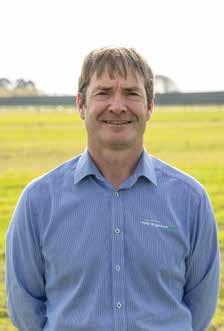
trials as we aim to provide growers with technical support and not just release cultivars into the market without support to get the best outcomes for growers and end users.”
So what’s available this season? Nick says growers will have the chance to put four new cultivars through their paces as limited releases for the coming harvest.
Still known as numbered lines, KMW2111 and KMW2206 have been bred for the premium and milling categories respectively, with KMW2111 demonstrating higher yields over current premium standards, Nick says.
KMW2206 meantime is a high yielding autumn and spring cultivar which will potentially replace PGW Grain’s Discovery, especially from an autumn planting.
KFW2102 is an autumn-sown feed wheat originally bred by PGW Grain’s overseas partner Limagrain, and subse-

quently put through rigorous NZ screening before being selected for commercial release.
A strong performer in the company’s own trial programme, it topped many of the Cultivar Performance Trial sites for autumn feed and biscuit cultivars in the 2022/23 season, and features both enhanced yield and disease resistance.
Ristretto is a grain triticale which again has been developed through the PGW Grain screening process and originated as an imported line, this time from Lantmännen Seed B.V.
It yields significantly more than Empero, which in itself is very high yielding; has excellent take-all tolerance and meets the nutritional requirements of feed end-users, Nick says.
Further out, Nick says, KMW2208 is coming up for release next season as a new quick developing spring milling wheat to replace Sensas, and PGG Wrightson Grain also has another feed wheat in the pipeline close to release, which shows potential as a dual purpose type having some milling quality.
Also in the development pipeline, Ste-
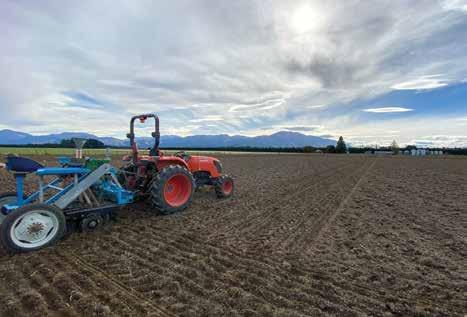
ve Shorter is leading a project to develop NZ-adapted soft wheat cultivars that will meet all of NZ’s soft milling end-use requirements – not only biscuits but other products such as sauce mixes, ice-cream wafers and noodles.
This project, now entering its 4th year, is funded by the NZ Flour Millers Association with the first selections entering multi-site yield trials this year.
For more detail contact Nick Brooks at PGG Wrightson Grain.

Features
• Leading spring barley in FAR CPT trials with great yields and consistency.
• Suited to all sowing times and conditions in both spring and autumn.
• Good all-round disease resistance profile especially powdery mildew and net blotch.
When grain prices are high, it can be tempting to spend more on sprays to push yields out as far as you can.
But imagine if you can make the same profit from autumn-sown wheat using three fungicide applications for Septoria tritici blotch instead of four or five applications.
What difference might that make to your bottom line at current operating costs and crop prices? How might you reinvest the money that you don’t spend on the fourth and/or fifth fungicide applications into other crops for a better return on those?
Similarly, what if a two-spray programme for barley provided the same level of disease control and economic return as a more intensive, expensive programme?
Both scenarios are quite feasible, recent FAR cereal research shows. Yes, there are provisos – your leaner spray programme must be well-balanced and carefully timed; disease pressure can’t be extreme and you need to stack the deck in your favour by starting with disease resistant cultivars.
Even so, in certain conditions, there’s more money to be saved here than might be imagined.
And that’s not even factoring in longterm benefits of protecting current fungicide mode of action (MOA) groups from overuse, adds FAR senior cereal researcher Jo Drummond.
When margins are tight, this is one way growers can leverage science outputs from A Lighter Touch to tangible financial benefit, she says.
“We’ve demonstrated this past season that there was no significant yield response to a GS30-31 (T0) fungicide in autumn sown Graham wheat.
“Under moderate disease pressure, a well-balanced three spray programme

provided the same level of disease control as four and five sprays for both an irrigated crop in mid Canterbury, and a dryland crop in South Canterbury.”
Financial analysis for all treatments across both the irrigated and dryland wheat crops raised some interesting questions around profitability as well as sustainability, Jo says.
As an example, the irrigated wheat crop trial showed the straight economic return from putting on more fungicide was minimal if not negative.
The costs of the trialled three-spray programmes, applied at GS32, GS39 and GS65, were $246, $259 and $336/ ha. Chemical prices were based on ProductionWise. At the then-grain price of $610/t, these programmes returned $3643, $3444 and $3549/ha. At a current grain price of $520/t, they would have re-
turned $3069, $2989 and $3014/ha.
Applying the same programmes without irrigation returned $1567, $1751 and $1458/ha at a grain price of $610/t. Returns at $520/t would have been $1300, $1448 and $1194/ha.
Jo says the price of adding a T0 fungicide to the trialled three-spray fungicides was $44/ha, without application costs.
On irrigated wheat, the difference in terms of margin over fertiliser cost for this T0 spray, at $610/t for grain, was +$5, +$231 and +$155/ha. At $520/t grain, the margin was -$2, +$190 and +$126/ha.
“So, depending on your programme, in the 2022/23 season, the T0 paid its way. This is highly seasonal, as longterm FAR data has found no yield response to this application timing in four out of five years.”
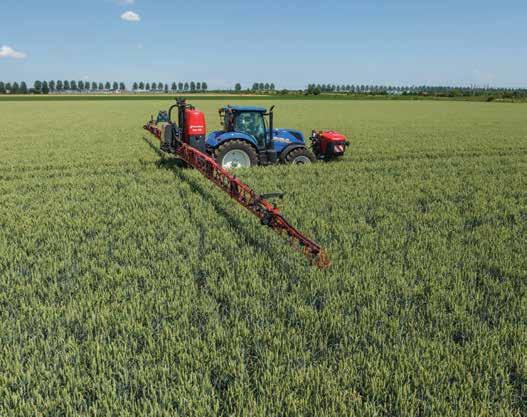
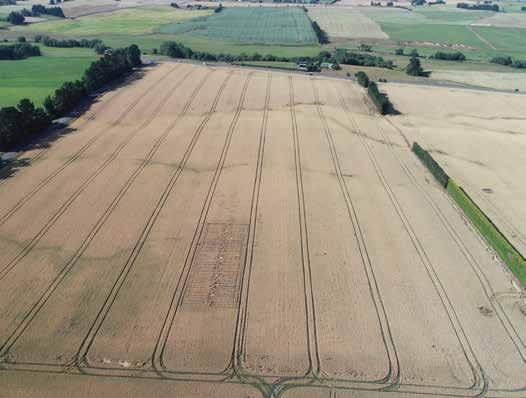
Without irrigation, that $44/ha in fungicide cost for the T0 spray returned +$58, +$28 and +$116/ha at $610/t grain. At $520/t, the return would have been +$42, +$17 and +$92/ha.
“In this instance, even without factoring in the additional costs of application, depending on your programme, the T0 starts to cost more than it returns.”
This was even more apparent later in the season. Adding a T4 fungicide to a four-spray programme on the irrigated crop cost $28/ha (without application), returning $43/ha at a grain price of $610/t and $33/ha at $520/t.
Doing the same without irrigation returned -$3/ha and $0/ha.
“The thing to remember with these late applications, is that by the time flowering has finished, there are very few options once you account for withholding periods, and these options tend to be leaf rust focused.”
None of the margins included other expenses associated with application.
Which leads to another very topical issue as on-farm inflation continues to bite, Jo says – if you’re applying four or five fungicide sprays in a moderate disease year, what are they actually costing you?
“Many farmers traditionally undervalue their own time, and often think nothing of spending an extra $40/ha for a T0 or late fungicide application to get an additional 100-200 kg/ha in yield, especially if it is tank mixed with other products. Yet that $40/ha only covers the chemical cost and doesn’t account for their own or a contractor’s time, fuel and other costs.”
Could be more
That $40/ha is also at the conservative end of the spectrum.
“Mixing fungicide mode of action groups is good for efficacy and resistance management and we know strategically mixing active ingredients from the same mode of action group that have different cross resistance pathways is also an option.
“These strategies tend to be more expensive, so that $40 soon turns into $50-60.”
On top of straight chemical costs, best estimates are that further associated costs for application can range from $25/ha to $45/ha, depending on where you farm. Canterbury is generally regarded as the lowest cost area, for a contractor spraying square paddocks on flat ground with readily available water.
In Southland and the lower North Island, this price can be north of $40 with high levels of overlap in a paddock (e.g. +10%) and longer distances to source water for filling up.
Even if you do the job yourself, there are still capital costs to factor in, plus repairs and maintenance, time spent sourcing the product(s), equipment cleaning, fuel and labour.
In either case, the $40/ha in extra fungicide quickly becomes higher once true costs of application are accounted for.
For some growers, the level of risk associated with not applying these T0 (GS30) and T4 (GS69-71) to their wheat in a moderate disease year where they are not necessarily required might be too uncomfortable.
“That’s the peace of mind factor, how
well you sleep at night, and that’s highly personal and may be aligned to your level of debt. We know applying fungicide is like buying insurance, and for those who have to achieve high yields to keep the bank happy, investing in the highest premium you can feels like the safest."
“However, if this is the case, it’s a good exercise to calculate the true cost of giving yourself that level of reassurance, and quantifying exactly how much it eats into your profit.
“You can then decide if you really need to do it, while knowing that a decision not to apply a fungicide when the crop or disease risk doesn’t warrant it, will reduce pressure on at risk MoAs, which will prolong their active life.”
This means facing a difficult decision, she says. Namely, what is more important? Short-term cash flow or being able to grow high yielding crops in 5-10 years’ time but with fewer tools?
“In some cases, the money saved on wheat fungicide could potentially be reallocated to another input or crop in your rotation that may have a higher need.”
A similar argument can be made for the risk posed by insect pests.
Monitoring for beneficial insects as well as aphids, for example, may mean less reliance on foliar insecticide, which in turns means less time spent on the sprayer and less money spent on chemical inputs while still maintaining acceptable yields.
“There’s sometimes a bit of a misconception that A Lighter Touch means doing nothing, or means taking on an unacceptable level of risk.
“Our message is that it might require a little more thought and planning in terms of monitoring and decision making, but this approach actually gives you more wiggle room to adjust your inputs to your season.
“It’s an opportunity to make the theory of reducing inputs and achieving the same level of profitability work in reality, so that you find that sweet spot between productivity and profitability while reducing your environmental and economic footprint.”
Unlike fixed operational expenses like paying staff, crop chemical inputs under A Lighter Touch approach are negotiable, depending on seasonal conditions, and that flexibility can have real value when budgets are as tight as they are at present.
Not going away
Meantime, Jo says, the underlying need for prudent chemical stewardship remains as pressing as ever.
“We can’t rely on a whole bunch of new whizz bang MOAs coming through the system. What we’ve got is what we’ve got. For the most part what we have comes with at least a moderate risk of resistance development, and in some cases, a high risk.
“We need to make some pretty careful decisions about how we use these so we can continue to use them when we need to.
“Fungicide resistance is a numbers game, and the more you expose your pathogen, the greater the selection pressure you place on your system.”
Ultimately, cultivar selection remains the foundation for disease control, both in wheat, where growing the most resistant variety that you can gives you a big head start, and in barley.
“No barley cultivars have any tolerance to Ramularia , but they do to other diseases. So picking a cultivar with tolerance across a range of diseases, or as many as possible, is also going to put you one step ahead.”
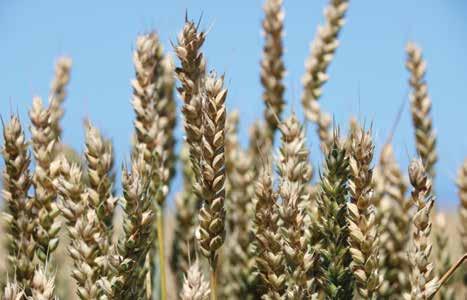
• Continuing to examine the value of fungicide applications across different regions, cultivars and disease pressure conditions including comparing products, rates and timings.
• Working with industry to provide up-to-date sensitivity testing of Zymoseptoria tritici to key fungicide mode of action groups.
• Supporting growers through FAR’s aphid and beneficial monitor paddock network.
• Identifying and investigating seed and foliar biological products that have a fit in arable crops.
Four essential functions are controlled by the Kverneland 2500 i-Plough
Ploughing: All important adjustment possibilities from the tractor cabin via the Isobus screen.
Transport: Automatic sequences ensure safe transportation.
Marking: Important function for “non-square fields” and for perfect in´s and out´s on the head-land.
Connecting: Safe and trouble free parallel setting of the cross shaft connection to the tractor lower links.


For 20 years, the Cereal Performance Trials have given arable growers confidence that the cultivars they are selecting have been tested in commercial conditions and their performance rigorously analysed.
Run on commercial arable farms throughout the cereal growing regions of New Zealand, the Cereal Performance Trials (CPT) are run independently of any commercial entities and are organised and funded through the CPT committee.
This committee is made up of representatives from the NZ Flour Millers Association Research Trust (NZFMRT), the Foundation for Arable Research (FAR), Plant & Food Research, seed companies and the NZ Plant Breeders Research Association (NZPBRA)
The NZPBRA in itself is an umbrella organisation that represents plant breeders, intellectual property owners and managers of proprietary agricultural seed.
The Association’s members are companies whose primary focus is the development and marketing of plant intellectual property through demonstrating the strength of research-proven standards of performance.
Nick Brooks from PGG Wrightson Seeds has chaired the CPT committee for over a
decade and says while breeders or seed companies manage the individual trial sites, the critical factor is that the data generated is owned and published by FAR who are independent of any commercial organisation.
Originally run under the umbrella of Arable Cultivar Evaluation, the CPT started out in 1993 at just five trial sites in Canterbury, evaluating autumn feed and milling wheats.
Today CPT is run on 29 trial sites across Southland, Canterbury and Manawatu on a mix of irrigated and dryland farms.
CPT tests the performance of feed and milling wheats and feed and malting barley.
The trials are sown in amongst commercial crops, so they are subject to the same management and climatic conditions.
Cereals being tested through CPT go through two stages.
The first, CPT1, is where advanced breeding lines are tested within a series of collaborative breeder/seed company operated and funded trials.
These are run at 15 of the CPT host farms in Canterbury.
Based on the outcomes of these trials, companies may then apply to promote promising cultivars into the next stage.
CPT2 is for close-to-market and commercial cultivars and these cultivars are subject to the most stringent quality and environmental assessments.
FAR coordinates the trials which are designed and analysed by an independent statistician.
Nick Brooks says most of the host farms have been growing CPT within their commercial crops for many years and while they do receive some compensation for the use of their land, many benefit from seeing how plant varieties perform in their growing environment.
PGG Wrightson Seeds’ cereal breeder Steve Shorter has had a long involvement with CPT and says farm management must be at a robust level that allows the new varieties to express their genetic yield potential as well as post-harvest grain and end-use qual-

ity. Specialist nurseries are carried out within the CPT system to determine other important traits such as disease resistance and pre-harvest sprouting resistance.
Cultivars targeting the milling and baking industries are extensively evaluated using industry-standard quality control rheological tests funded by the NZFMRT.
Nick says as a company, they tend to promote their varieties using data from CPT because of their independence and rigour, only adding relevant additional data if required.
“Farmers should feel confident that the varieties they are looking to grow have been subject to a rigorous testing process and analysis.”
Matthew Hicks from Cropmark says CPT widens their net by giving the company the opportunity to trial varieties in a wide range of farm environments.
Cropmark evaluates the performance of UK-bred cultivars in NZ conditions and while Matthew says they obviously run their own trials, CPT gives them access to sites they couldn’t necessarily access on their own.
“This means that when we release new varieties, we have great confidence that they will perform in most if not all environments.”
The results of the CPT are presented in FAR’s spring and autumn cultivar booklets, although early yield results are
Cultivars in the CPT are grown amongst commercial crops and subject to the same management.
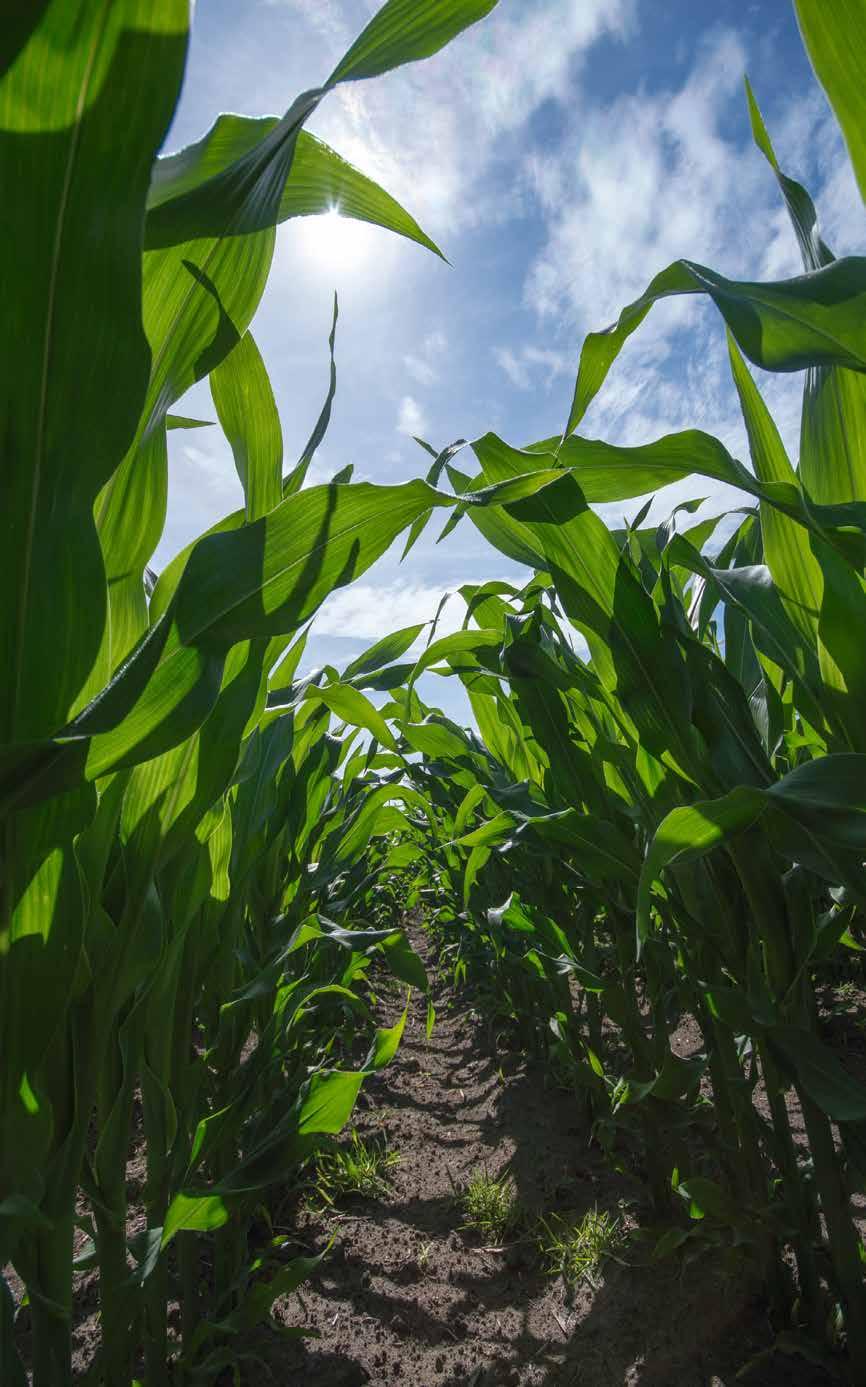
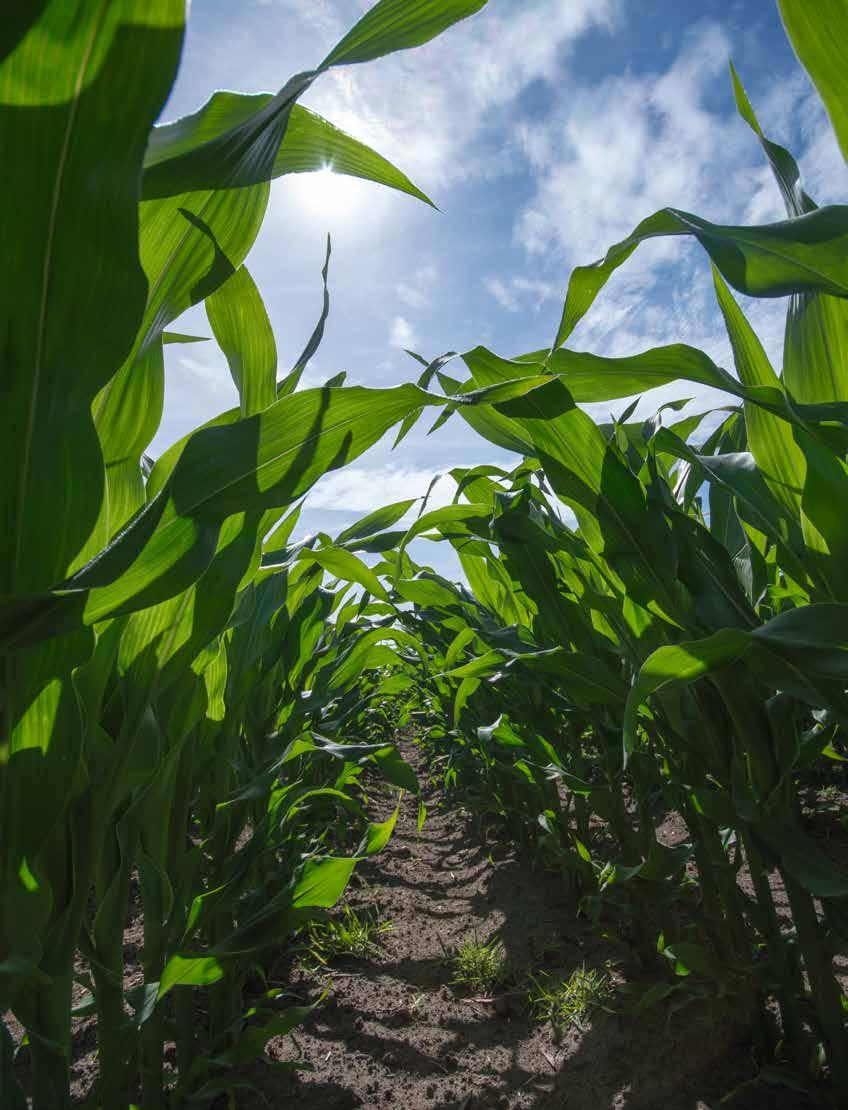
Farmlands scale, combined with the Agronomy team’s technical ability, is a powerful offering.
The Farmlands Agronomy team provides a vast offering across seed, crop protection and fertiliser, backed up by a dedication to environmental sustainability and access to industry experts. Provincial teams throughout New Zealand are available right now to help you with your planning.
• 10 Provincial Agronomists responsible for providing technical support
• 118 Technical Field Officers providing advice for new and existing customers
• A dedicated team of Grain Traders
• Farmlands-owned seed stores to produce mixes suited to your growing needs
• 81 retail stores nationwide
Our close relationship with Ballance Agri-Nutrients means we can provide you with a full range of broad acre fertilisers for all pastoral, cropping and horticultural requirements at competitive rates. Ballance’s Farm Sustainability team can also assist with the creation of Farm Environmental plans and nutrient budgeting services.
Our relationships with key crop protection suppliers means Farmlands can offer you best in class innovation and sector-wide solutions wherever you are in New Zealand.
Our experienced team can offer you a comprehensive forage and pastoral renewal and management service, backed by industry-leading suppliers.
Farmlands Agronomy offering extends far beyond the paddock, bringing you the benefit of more economical trading and best practise through Card Partners like Landpro, PF Olsen, RDA Consulting and CropX.




Visit our Card Directory to see our other Agronomy services by location.
Visit your local Farmlands store and talk to the Agronomy team or call 0800 200 600 for more information.
Visit your local Farmlands store and talk to the Agronomy team or call 0800 200 600 for more information.
WE RE OUT , here too.
WE RE OUT , here too.
The past two unusually wet growing seasons have tested the mettle of arable growers while shining a light on the cereal cultivars that continued to perform irrespective of the climate.
Luisetti Seeds says its autumn-sown feed/milling wheat Whopper was one of those cultivars and in the independently run Cereal Performance Trials, it proved to be consistently high yielding across all trial sites with high protein levels and low screenings.
In the four-year adjusted mean, Whopper exceeded the yield average in nine out of 11 feed wheat trial sites which were a mix of dryland and irrigated sites stretching from Southland to Manawatu.
In the Fitzgerald family’s mixed-cropping operation near Methven, Whopper has delivered on both protein levels and yields over the past two years and has become a valuable part of their crop rotation.
The family farms 220 ha, growing
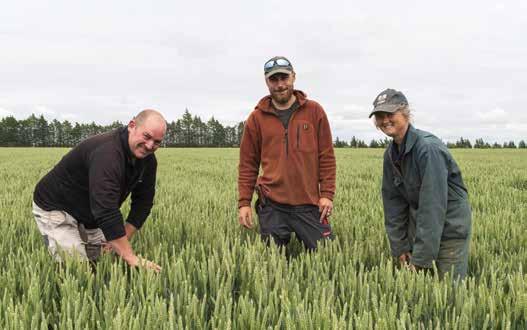
Luisetti Seeds agronomist Simon Fleetwood (left) in a crop of Whopper wheat with Dylan and Ruth Fitzgerald.
a range of crops including cereals and specialist seeds. Ruth Fitzgerald and her son-in-law Dylan say their autumn-sown Whopper crops fits their rotation nicely, typically coming in behind late-harvested brassica seed crops such as fodder radish.
Ruth says they aim to get the wheat in the ground in mid to late April as weather permits.
Working with their Luisetti Seeds agronomist Simon Fleetwood, they support the crop with what Dylan describes as a robust spraying programme to help optimise performance.
“We want to give it its best chance to perform at its peak,” says Dylan.
Despite the damp conditions over the past two years, Whopper has pulled through without any late disease.
“We’re really happy with how it’s performed in some challenging seasons,” says Dylan
They have found that Whopper heads nicely, and being a later maturing wheat, it offers them a wider harvest window, so they are not trying to get all
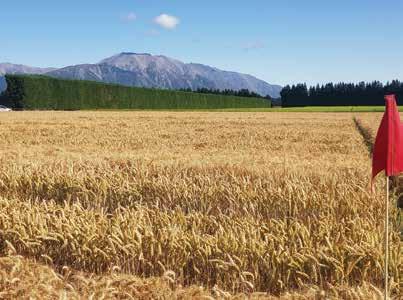
Cereal Performance Trials are run on 29 trial sites across the cereal growing regions of New Zealand.
their cereals in at once.
Over the three years the Fitzgeralds have grown Whopper, Dylan estimates the average yield to be around 12 t/ha with good protein levels. This has allowed them to hit premium milling grades.
The wheat is sold on contract to Champion Mills.
Agronomically, Whopper is a medium height, stiff straw variety. It is late maturing cultivar with moderate sprouting risk.
It is known to perform well in dryland conditions as well as under irrigation and has good resistance to most diseases.
Vincent Luisetti from Luisetti Seeds says Whopper has struck a chord with cereal growers and is in high demand.
He encourages growers wanting to include Whopper in their sowing plan to contact their Luisetti Seeds’ agronomist early as seed is in limited supply.
“Whopper really is something special. It is the first time we have been able to breed a milling wheat that yields better than a feed wheat.”
presented every week over the harvest period in FAR’s weekly Harvest Snippets newsletter.
Nick Brooks says this gives growers in regions that need to establish crops in early autumn an indication of cultivar performance.
The results in the cultivar booklets are far more detailed and include an assessment of a cultivar’s susceptibility to a range of diseases, straw strength, crop height, maturity and sprouting sus-
ceptibility as well as yields and grain quality data such as test weight, protein levels and screenings.
Detailed information is provided about each trial site including soil types, previous crops, sowing and harvest dates and inputs.
To remove seasonal variations, the yield results are also presented in a fouryear adjusted mean and this ranks the cultivars based on the relative yield of that site over four years.
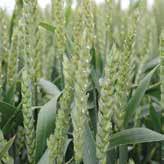


Scan for more information, phone 0800 333 338 or visit www.syngenta.co.nz
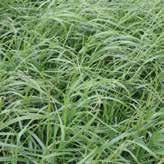
Long-lasting disease control in wheat crops.
Proven rust control in ryegrass seed crops, with a short 14 day withholding period.
Solo SDHI formulation for tank mix flexibility. Ryegrass endophyte safety confirmed.
Qualify for FREE Syngenta nozzles.
Sometimes, doing good research is all about discovering what doesn’t work, as well as what does, especially when you’re pursuing a new approach to a well-worn topic.
With year two results from the five year FAR project investigating ways to improve maize silage profitability in the South Island, it’s been a case of both.
Researchers Owen Gibson and David Densley say that while it was disappointing forage quality was not able to be assessed at the Chertsey site this past season, it was interesting to see from the second year of data the potential influence row spacing, and row spacing by population, can have on yield.
Year three trials scheduled for spring planting aim to firm up these findings as well as generating more robust data on forage quality by eliminating mechanical variables experienced last season.
“We’ve got some interesting results from 2022/23 suggesting a potential silage yield advantage to narrow row spacing,” Owen says.
“We didn’t have a signifi-
cant result in yield last year (2021/22 season) between row spacings, or plant populations, but this year is different. It has been great to see last year’s trend in yield increase due to narrow row spacing producing a significant result.”
Of the four row spacings investigated in 2022/23, namely 30, 40, 50 and 70 cm, the 30 cm treatment was highly significant in terms of yield.
At the FAR research site at Chertsey there was a 21% increase in yield between the 30 cm row spacing compared to the 70 cm row spacing (25.46 tonne dry matter/ha and 21.12 t DM/ha respectively).
However, further analysis of this data set and ongoing research work needs to be undertaken to be confident in row spacing having such an influence on drymatter yield production.
Average plant popula-

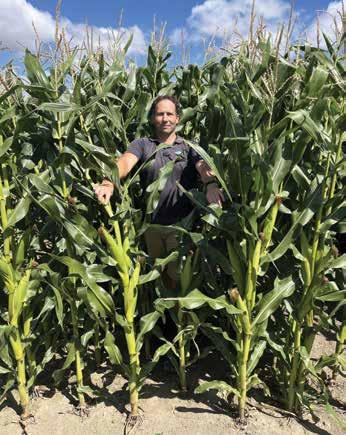
Owen Gibson says of the four row spacings investigated last season, 30 cm was highly significant in terms of yield.
tion was 14% lower in the 70 cm row spacing treatment (105,000 plants/ha) compared to the 30 cm row spacing treatment (122,400 plants/ha) which could account for the lower yield in this treatment.
The 2022/23 trial differed in several ways from initial work done in 2021/22.
For a start, it was in small plot format, vs large scale, with all plots planted by a single row hand planter.
That gave much more flexibility to experiment with row spacings than could be achieved by using a commercial planter as in year one, which only offered standard 76 and 38 cm rows.
Planting was two weeks later for 2022/23, and a shorter maturity cultivar was used (Pioneer P7124, CRM 71
(comparative relative maturity)).
“Using the single row hand planter does have its own considerations; it means that we are unable to place starter fertiliser at the optimal position next to and below the maize seed, and this equipment requires a very fine seed bed for uniform seed placement, which means we need to be planting into optimum conditions.
“However, the upside with a single row hand planter is that soil compaction is avoided which would likely occur when undertaking small plot research with currently commercial maize planters, particularly with the very narrow row research plots.”
Maize forage harvest underway in 50 cm narrow row strip-till demonstration trial at the Foundation for Arable Research, Chertsey research site by Wayne Copland.
The single row planter will again be deployed for year three, with the addition of starter fertiliser manually placed next to each row to better simulate a commercial maize planter.
In year two, along with row width research, Owen and David repeated their work on the influence plant population and population by row
width could have on yield potential, looking for any differences between populations of 90,000, 100,000 and 130,000 plants per ha.
“In Canterbury, depending on hybrid maturity, maize silage crop would normally be planted at around 115,000 to 120,000 seeds/ha.
“We need to understand if there is an advantage in increasing populations further particularly as we narrow up row width, even with the higher cost of seed.
“We were expecting to see higher yields as plant populations increased but that was again not the case, although there was a gain in individual plant dry matter percentage.”
Harvesting the small plots in April 2023 was quite different from the commercial harvest carried out the previous year, and much more intensive.
Each plot was hand cut at two locations of 1.25 metres x two rows per plot, with these
bulk samples wet-weighed before being sub-sampled for five plants which were then weighed again for individual plant wet weight.
The two cuts were processed individually with cut one processed at the FAR lab for dry matter percentage and cut two sent to Hill Laboratories for forage quality and dry matter.
Cobs were removed from the stover and weighed separately, and then the stover and the cobs for each five plant sub-sample were put through a commercial wood chip mulcher to simulate a maize forage chopper.
It was from this point that the team experienced wide variability in sample consistency, Owen says, because the mulcher didn’t chop or mix the maize plant material like a forage chopper would, and thus no detailed quality analysis could be done on starch,
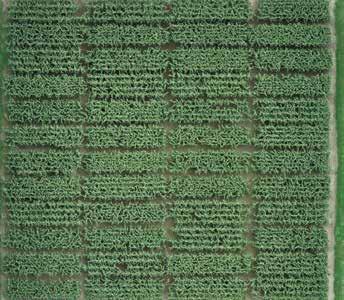
or metabolisable energy.
“So, we’re repeating that work this year, with new equipment, to hopefully achieve much more robust data and eliminate that variability. The South Island team used the best option available at the time, and it wasn’t good enough, but we’ve learned a lot about how to refine that process.”
Not ideal, in terms of advancing the data, but also not unusual in applied research, particularly with a new research project, he says.
If anything, the highly erratic weather patterns experienced for the whole of New Zealand in year two of the trial reinforce the importance of continuing to research ‘new’ crop options for South
EV E RY SEE D D E SERVE S TH E P E RF EC T STA RT SEED DRILL COMBINATION
The U-drill gives a one pass uniform seedbed over the entire working width, providing perfect preparation, levelling and seedbed reconsolidation.
All of the U-drill’s important settings can be changed from a central point with the push

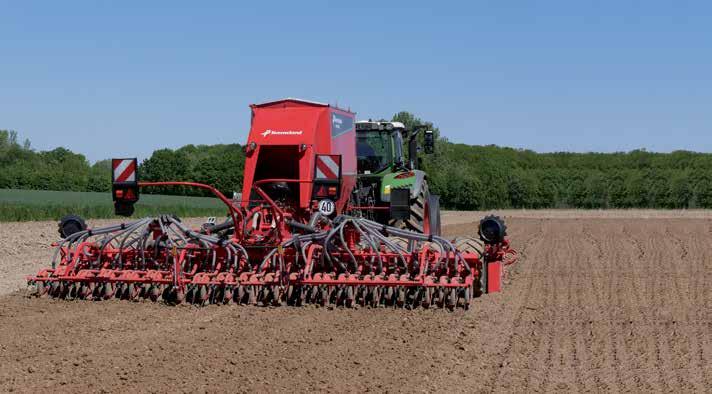
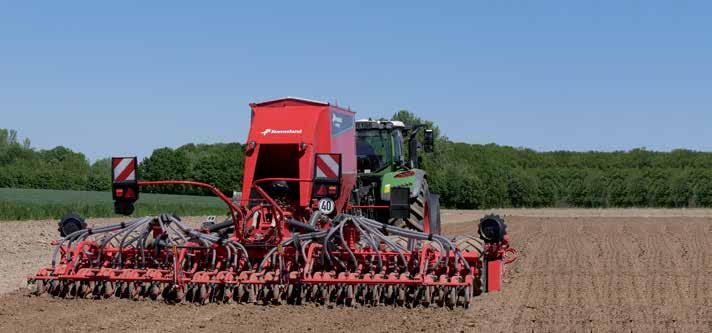
of a button making it extremely operatorfriendly. Coulter depth can be adjusted conveniently from the cab, calibration is started by pushing a button directly at the metering device and the hopper can easily be filled using bags, a front loader, telehandler or auger.
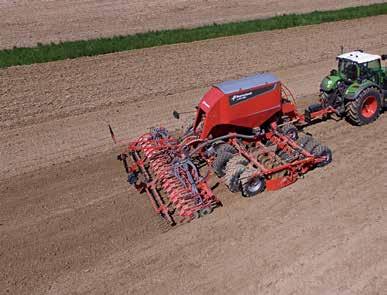
Gisborne-based maize business Corson Grain has had a challenging start to 2023 with first the impact of cyclone Gabrielle and then the fire at its Gisborne maize gritting mill.
Grain procurement manager Richard Hyland notes that in his 30+ years with the business he has known no year like this.
Nonetheless, the East Coast is known for its resilience and Corson is aiming to be back gritting maize in Gisborne before the end of 2024.
This means that Corson will still be
Island growers to enhance both climatic and systemic resilience.
Because of climate change, ambient temperatures are continuing to increase throughout the maize production months of October to April.
“These actual and predicted temperature increases have an implication on maize production throughout NZ, with more heat and drought stress likely to occur in the northern parts of the North Island, and opportunities for increased maize production in the South Island.”
For arable farmers, maize can provide an alternative income as well as agronomic benefits. These include the opportunity to use different herbicide chemistry and utilisation of nutrients that may not have been accessible to shallower rooting crops (reducing the risk of nutrient leaching).
Maize silage demand from the dairy sector is also increasing, as its use can complement pasture-based systems both nutritionally and economically.
But if maize silage is to compete with PKE as a suit-
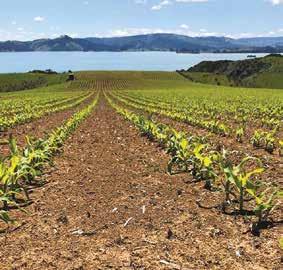
ent in a wide range of foods.
looking to contract gritting maize, some quantities of feed maize and popping corn for this year’s planting season.
CEO Brett Thompson notes that demand from customers remains unabated and as living costs have lifted, consumer staples such as corn flakes continue to sell well domestically, as does maize flour as a gluten free ingredi-
able pasture supplement for South Island dairy farmers, economic yields and consistent forage quality are required.
Currently, South Island growers are roughly estimated to spend about $2500/ ha to produce a maize silage crop, Owen says.
Average yields can range anywhere from 17 to 25 t DM/ha, with a current selling price of between $300 to $310/t DM, and that provides a gross profit of around $2,700 to $5,100/ha.
Most of the South Island maize currently grown is on dairy farms, for home consumption, as opposed to being grown by arable farms and sold to dairy farmers.
David and Owen say while it’s still early days for their maize agronomy research project, growers are definitely becoming more interested in maize silage as a possible option for South Island arable rotations.
The amount of southern land sown in maize in 2022/23 is estimated to be around 15% of the total NZ maize area planted.
For more detail contact FAR or Owen Gibson, owen.gibson@far.org.nz, 0277332257.
Enquiry from export customers is strong from South-East Asia and provides a compelling reason for Corson to reinvest in the region.
“As a result, we are keen to be talking to growers around the opportunities ahead.”
For further detail please contact Richard Hyland on 021 243 6325.
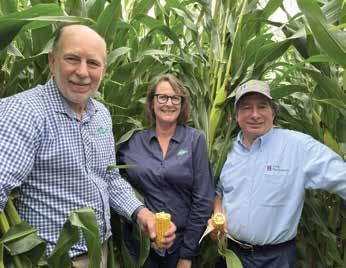
FAR’s David Densley and Anna Heslop, with Professor Fred Below, at the Premier Maize Event.
At the FAR Premier Maize field day event held in February, special guest presenter Professor Fred Below from the University of Illinois shared some of his latest findings on narrow row maize research.
Senior maize researcher David Densley says his intensive study showed that as populations increased within a standard 76 cm row width, the roots got smaller.
This in turn impacted nutrient and water uptake by the root system.
When they switched to narrower rows, root size increased.
“There are many potential advantages to narrow row maize particularly in the South Island, which is what this research project, and other complementary maize research being undertaken in the North Island, aims to identify,” he says.
For over 150 years GASCON have built gear that lasts.

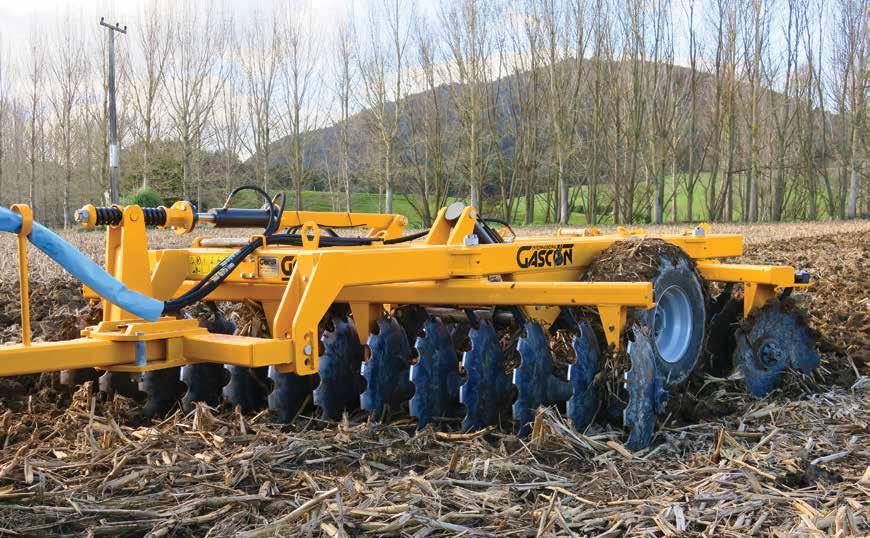

SERIES
2.8-5.6m working widths
Suits 80-170HP
Fixed or folding hydraulic models
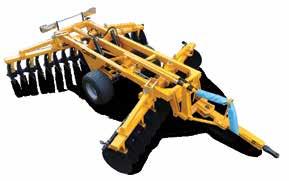
GEA SERIES EOS SERIES
3.05-5.88m working widths
Suits 100-340HP
Fixed or folding hydraulic models

KAITAIA Kaitaia Tractors 09 408 0670
WHANGAREI Piako Tractors Northland 09 438 1319
SILVERDALE Brandt NZ 09 427 9137
PUKEKOHE Brandt NZ 09 237 0043
MORRINSVILLE Piako Tractors 07 889 7055
MATAMATA Matamata Tractors & Machinery (07) 888 6292
HAMILTON Brandt NZ 07 847 0425
CAMBRIDGE Brandt NZ 07 827 5184
ROTORUA Piako Tractors Ltd 07 345 8560
STRATFORD FieldTorque Taranaki 06 765 8643
GISBORNE Stevenson and Taylor 06 863 2612
WAIPUKURAU Stevenson and Taylor 06 858 6041
DANNEVIRKE Lancaster Tractors 06 374 7731
PALMERSTON NORTH Transag Centre 06 354 7164
MASTERTON Wairarapa Machinery Services 06 377 3009
NELSON Drummond & Etheridge 03 543 8041
BLENHEIM Drummond & Etheridge 03 579 1111
KAIKOURA Drummond & Etheridge 03 319 7119
GREYMOUTH Drummond & Etheridge 03 768 5116
CHRISTCHURCH Drummond & Etheridge 03 349 4883
ASHBURTON Drummond & Etheridge 03 307 9911
TIMARU Drummond & Etheridge 03 687 4005
OAMARU Drummond & Etheridge 03 437 1111
MOSGIEL JJ Limited 03 489 8199
GORE JJ Limited 03 208 9370
INVERCARGILL JJ Limited 03 211 0013
FAST DISC CULTIVATOR
1.55 – 2.0m Working Widths
Suits Horticultural applications OTHO SERIES
The South Island is witnessing a notable surge in maize silage production, fuelled by a combination of factors that are transforming the region into a prominent maize-growing centre.
WORDS: MATT
DALLEY, FARMS SYSTEMS MANAGER, PIONEER BRAND PRODUCTSTraditionally, maize in the South Island has largely been grown by arable farmers supplying dairy systems.
Whilst this market remains constant, environmental regulation changes, improved hybrid genetics, and more favourable growing seasons have converged to make maize more apparent on South Island dairy farms.
Yields
Maize has been grown in the South Island for over 30 years, however success has been varied and it is only in recent years that consistent crop yields mean it is being acknowledged as viable supplementary feed option.
Murmurings of large yields have shattered across the Canterbury plains and mid 20’s tonnes of dry matter per hectare (t DM/ha) crops are now considered standard.
In fact, in the 2022/23 growing season, a maze hybrid trial just south of Timaru topped the country averaging 30.14 t DM/ha with the top hybrid achieving 36.01 t DM/ha.
Yield drives the profitability of cropping systems so high yields combined with the environmental tailwinds means maize is delivering success.
Improved genetics
Advancements in maize genetics have sparked a revolution in crop productivity.
Researchers and breeders have developed new maize hybrids with enhanced traits, such as increased yield, improved disease resistance, and superior nutritional value.
Commercial crops have been realising the 300 kg DM/ha per year silage yield increase which has been achieved in Pioneer® brand seeds maize hybrid advancement trials over the past three or more decades.
Performance of shorter Comparative Relative Maturity (CRM) hybrids is bringing maize on to dairy platforms providing farmers with the ability to resow, with oats, annual ryegrass or even perennial pastures after silage harvest.
Currently there is the perfect storm of push and pull factors for maize to be grown to assist farm systems into the future.
With recent amendments to environmental regulations particularly in relation to reducing intensive winter grazing, South Island wintering systems have been reshaped.
Maize silage has emerged as a sustainable alternative to intensive grazing, helping to address water quality and soil health concerns.
Restrictions on the area available for winter cropping has increased the demand for a complementary feed that offers better characteristics for winter feeding.
The utilisation of off paddock feeding facilities has enabled dairy farms
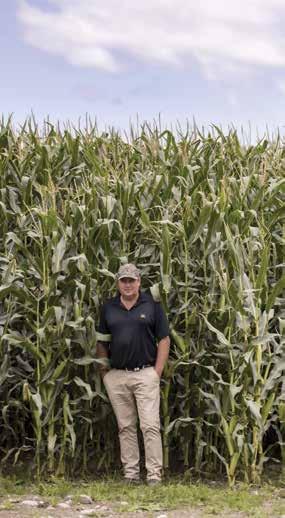
to successful integrate maize silage as a large proportion of the winter diet as an alternative to winter crop thus, protecting soils and increasing animal welfare.
Maize silage grown according to best management practices can minimise N loss and enhance environmental sustainability.
Pioneer brand seeds conducted a series of experiments to measure nitrogen (N) loss to water.
These showed that a maize crop followed by a winter catch crop resulted in minimal nitrate-N loss, while losses were higher with winter fallow (no crop) systems.
The research emphasised the importance of having something actively growing over the winter months.
Urinary nitrogen is a major source of N leaching on livestock farms.

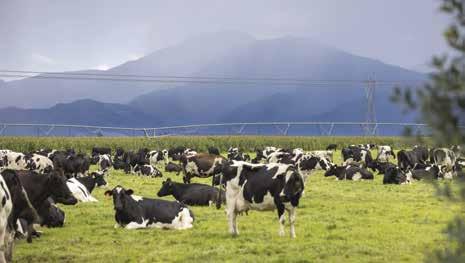
Feeding maize silage, a low crude protein feedstuff, can dilute dietary nitrogen levels and subsequently reduce the nitrogen content of livestock urine.
Reducing animal numbers and growing maize silage on-farm instead of buying in feed is a proven means to reduce greenhouse gas emissions.
Pioneer brand seeds and the Foun-
dation for Arable Research (FAR) used OverseerFM to model annual GHG emissions for 12 maize silage production systems.
Maize silage systems without livestock (n=3) recorded an average modelled GHG emission of 1.85 tonnes CO2e/ha while maize silage systems that included livestock (n=9) produced 3.5 tonnes CO2-e/ha.
Systems without livestock primarily
attributed emissions to N fertiliser use, while systems with livestock experienced higher methane emissions from animal wintering.
The warming climate in New Zealand, characterised by a reduction in frost occurrences and the commercial release of new, short maturity maize hybrids, has opened up new opportunities for maize in the South Island.
We have seen a number of successful maize silage crops grown throughout south Otago and into Southland.
Maize grain has also become a viable option in Canterbury and north. It produces reliable yields of high value grain and is more disease resistant than most cereals.
In summary, maize grown for silage or grain can deliver significant benefits to South Island arable and livestock farmers.
Selecting the right hybrid genetics is a key element of success.
For area specific advice, contact your local Pioneer Area Manager at pioneer. co.nz.
1 Pioneer® Brand Products, 2023

The new GASPARDO GIGANTE pressure has been redesigned with a re-engineered frame, improved seeding coulters, updated electronics and metering the new GIGANTE is the ultimate direct drill.
• Available in 4 and 6m options
• 6-inch row spacing, single disc with sowing coulter
• In-line seed and fertiliser tank configuration with 60/40 split
• E-Drive and ISOBUS standard
• Low centre of gravity for stability in hilly country
• Individual unit depth control for accurate seed placement




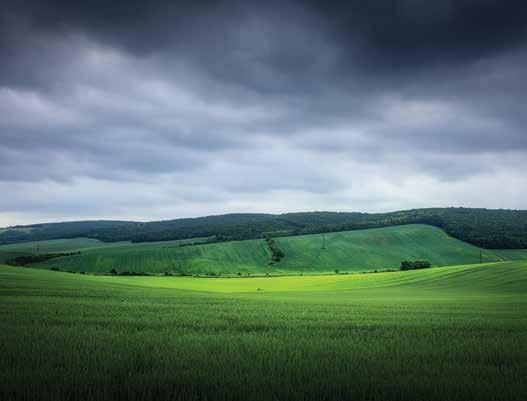
Both recent trial work and the word of mouth after its first use in commercial crops have confirmed that Revylution® fungicide is a genuine breakthrough that provides superior and more robust control of speckled leaf blotch (SLB or Septoria tritici blotch) and leaf rust in wheat than the previous industry standards.
Revylution also provides effective control of stripe rust.
At a time when global demand for wheat is so high, that extra level of protection against yield loss to fungal blights is a very valuable benefit.
The challenge for growers is to make the most strategic use of it.
BASF’s technical development manager Grant Hagerty says making the most efficient use of Revylution is all about appreciating the strengths and vulnerabilities of the various Group 3 fungicides – more commonly known as DMIs or triazoles – now available and using each of them to best advantage.
Revylution is powered by a groundbreaking Group 3 active ingredient, mefentrifluconazole, that BASF launched in New Zealand in 2020 as part of the coformulation Revystar®.
Mefentrifluconazole has a unique ‘isopropanol-azole’ molecule with a flexible triazole head that can mould its shape to fit the ‘pocket’ of the target fungal enzyme.
That flexibility allows it to adapt to mutations in the target pathogens and control strains of the target diseases that are less susceptible to other DMIs.
Revystar has multiple registrations in both wheat and barley and quickly established itself as the preferred solution for Ramularia in barley – a very welcome big step forward in the control of a notoriously challenging disease.
Now Revylution means farmers have a more targeted tool for controlling some of the most damaging diseases in
wheat and managing the broader challenge of fungicide resistance.
Grant thinks many growers are probably not aware how much efficacy some of the older DMIs have lost in recent years because they apply them in tankmixes that may paper over the cracks to a certain degree.
He has conducted trials where the various active ingredients have been used as solo sprays to get a clear picture of their standalone performance.
He says there’s now substantial evidence that both prothioconazole and epoxiconazole have lost, to varying degrees, a lot of their potency as the target diseases have mutated in response to repeated use.
The graph shows that prothiocona-
zole and Revylution were providing equally good control in 2017/18, but – in these trials at least – prothioconazole had become 25% less effective just five years later.
Not that Grant is advocating a wholesale shift to Revylution.
He believes a single application per crop can deliver the greatest value in each season and the longer term.
The older DMIs still have a fit in supporting roles.
“Revylution is now the best choice for targeting SLB and leaf rust at the ‘kinghit’ T2 application timing – from when the flag leaf is fully emerged (GS 39) through to booting (GS 45).
“We’d rather see it used once a year at the optimal timing than used twice and have it stop working four or five years from now.”
Grant says the ideal disease-control programme for wheat is now Revylution at T2, potentially in a tank-mix with SDHIs like Elatus® Plus or Vimoy Iblon® and surrounding that with robust tankmixes at T1 and T3 of prothioconazole and/or epoxiconazole-based solutions, thus extending the disease coverage, ensuring there is rotation within the triazole group, and targeting the diseases with the appropriate tools.
“Growers have to keep their ‘insurance policy’ against disease up to date,” he explains.
“Failing to control a disease like SLB could cost you four or five tonnes a hectare in lost yield.
“So even with the most premium fungicide programme, you’re only investing a few hundred dollars to save thousands. If we don’t look after Revylution and the other chemistry and it breaks, it will be very expensive.”
Figure 1: The fall in prothioconazole efficacy on SLB compared to Revylution from 2017/18 to 2022/23. The results shown are the mean disease control on the top 3–4 leaves across 3 sites in each period.
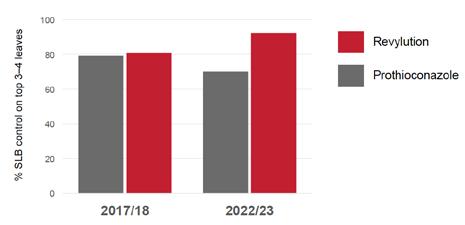
Farmers and contractors visiting Mystery Creek Fieldays this year got a sneak peek at the next generation of Giltrap Ag’s Duncan Enviro triple disc drills.
Over the past two years Duncan engineers have been consulting with dealers and end users to develop a larger direct drill.
The result is two versions of the Air Triple Disc drill, the 6 m ATD 60 and the 4.2 m ATD 42.
Both are folding models that give the ability to sow a full complement of crops in a wide range of soil types and conditions.
Giltrap Ag New Zealand national sales manager Matt Moodie says discussions with Duncan dealers and customers showed that there was a gap in the market for triple disc drills with wider working widths than the 3m Duncan ATD30.
“To determine what larger farmers and contractors wanted in a direct drill we got groups of customers and
dealers around the table at meetings around the country. Once we had their input, our design team got to work,” Matt says.
“Over the next year, they went from the ground up to develop a completely new drill. We developed the 6 m version first, and it has now had its first full season of testing in Canterbury and Otago. We handed it over to contractors and farmers and then we got feedback from them.
“It was well-received and we made changes to address the shortfalls they identified when we built the 4.2 m version. That version has now been tested in the South Island and it has gone up to the North Island for further trials.”
Matt says the ATD drills have performed well every-
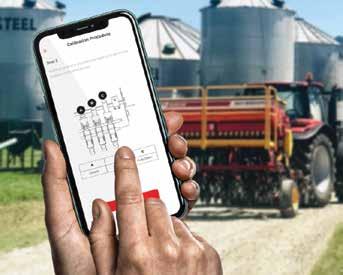
where – from flat, irrigated paddocks on the Canterbury Plains to steep, hard, stony ground in the Hakataramea Valley and Central Otago.
In the North Island it performed effectively in maize stubble.
Calibration for the Air Triple Disc drills under development, as well as other Giltrap Duncan electric drive and mechanical drive drills, has just got easier.
A new free smartphone-based app has easy-to-follow, step-by-step guides to calibrate and make mechanical adjustments to your drill.
Giltrap Ag national sales manager Matt Moodie says it can all be done without fumbling through manuals or using the tractor's in-cab controller.
“Once you have downloaded the app from the Apple App Store or Google Play, you can link your phone to your Smart Ag Wi-Fi enabled monitor in the tractor cab. You can then use your phone to do all the steps necessary to calibrate the drill.
“This eliminates the need to jump out of the cab to take samples, weigh them and then jump back in the cab to punch in the results on the monitor. With the app you do the sampling and enter the results on your phone while standing next to the drill, outside the cab.”
Matt says the app provides drop down menus that allow you to select the type of crop you are about to sow and at what rate.
When using it with a mechanical ground-drive drill with seed or fertiliser, it then tells you what all the settings should be for the gearbox, flaps and shutters. It also tells you how
User-friendliness was a priority for Duncan engineers when they designed the folding ATDs. As a result, they are easy to calibrate, operate and service.
“All parts of the drill had to be accessible and it has
many turns of the handle to make in order to take a sample.
Once you have weighed the sample and entered it into the app, it tells you what to adjust to get the right rate. You then take another sample and make any further adjustments required.
When using it with a Smart Ag Wi-Fi enabled electric drive drill, once you have selected the type of crop and sowing rate using the dropdown menu, the app tells the drill to release a sample. You enter the weight of the sample into the app and if this is the correct amount, you are ready to go. All the details are automatically sent back to the drill monitor in the tractor cab.
“The app also has diagrams that show each part of the calibration process and how to set up the drill.
“This is great if you have a new operator on the drill. Or if you have a 15-year-old Renovator sitting in the shed, you can go to the app store, download the app, set up the drill and calibrate it with ease.”
Matt says you can calibrate multiple machine models with the app.
“Another advantage is that once you have downloaded the app to your phone along with the corresponding drill model, it is not necessary to have a cellular connection to use it.”
For more information call 07 873 4199.
to be easy to adjust,” Matt says. “Altering the angle of the front discs and changing the seeding depth are all hydraulically controlled from the monitor in the cab.
“Access to the metering unit is very easy. You don’t have to crawl under anything to get in and change a metering cartridge or collect a seed sample. Everything is laid out right in front of you with lots of room.”
ATD drills can sow all types of crops – from small seeds at rates less than 1 kg/ ha to peas at upwards of 350 kg/ha.
The ATD drills’ seeding units are on 125-mm row spacings and the seeding depth is controlled by the press wheels. The folding wings lock down and the individual disc units follow the contour of the ground.
Both the ATD 60 and ATD 42 have two hoppers –a 1500-litre hopper in front
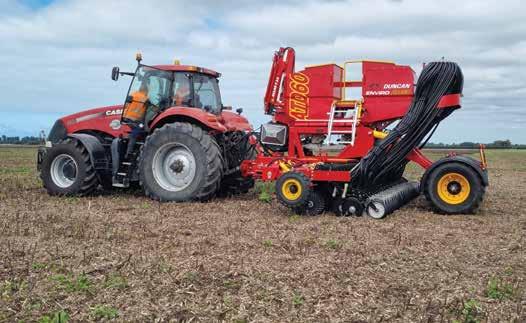
and a 1200-litre hopper in the rear. Both hoppers can be used for either seed or fertiliser.
“Cost effectiveness was another of the priorities we had when designing the new drills. They are built to be
more cost effective in the long run with low on-going maintenance costs,” Matt says.
“To achieve this we have retained some elements from our earlier drills, including the press wheels
and our recently introduced Amazone seed metering unit and electronic components.” Giltrap Ag will carry out further testing of the two ATDs in the spring and will begin commercial production in 2024.

Now in their tenth year, UPL NZ’s scholarships for students at Lincoln University reward emerging talentstudents who demonstrate passion for the industry, work ethic, and potential to contribute, the company says.
This year’s winners are Caleb Dudin and Kate Sheehy.
Scott Hanson, country head of the UPL NZ, explains that two students are awarded scholarships annually.
He says interest has always been strong with 242 applicants over the last decade.
The total award is worth $10,000.
This year, the six candidates who made it into the final round were out-

standing: “They were all very impressive individuals with a lot to offer our industry.”
A former Lincoln University alumni himself, Scott says today agriculture is facing real challenges in attracting and retaining the best people.
“Through the scholarships we hope we can help support promising students early in their journey and reinforce their choice of direction in their studies and, ultimately, their careers.”
UPL NZ has several staff who have come through either Lincoln University,
or comparable tertiary providers globally.
“We appreciate daily the real value that those educational organisations bring. We believe knowledge will continue to be key to finding better ways to feed our planet’s growing population.”
Scott says the scholarships are one way that UPL NZ can reinvest in the industry.
“We have strong ties with many organisations and businesses in agriculture, horticulture and viticulture and we’re committed to using our chemis-
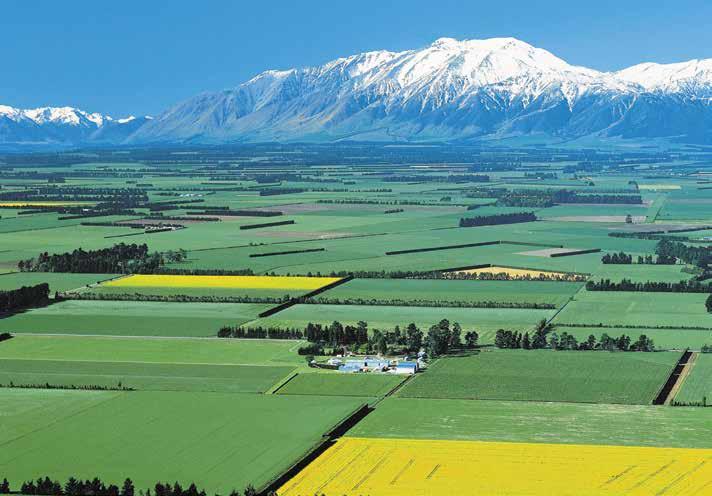
Shortcuts aren’t always a good thing when it comes to producing profitable, high yielding crops. But what if there was a shortcut that actually helped you do a better job?
Use the right glyphosate for paddock preparation this season, and you’ll enjoy a shortcut that fast tracks your other tasks, adds flexibility to your programme and/or gives you a few more opportunities with grazing.
That’s because paddocks sprayed with CRUCIAL (Group 9) can be grazed, cultivated or drilled just one day after treatment for annual weeds, and three days for perennial weeds.
That’s two to four days sooner than some other glyphosate formulations, meaning you can get crops established quicker with less downtime, and move onto other jobs sooner, knowing that if for some reason your plans change, you have extra leeway.
You can also use that time to put more feed into trading stock, like grazing lambs on a ryegrass paddock that is destined for spring sown crop for example.
Nufarm arable specialists Jeff Hurst and Mike Cox say now more than ever, time is money for cropping farmers, and getting the fastest possible turn-around between crops is a great way to farm smarter, not harder, on a
tight schedule.
CRUCIAL helps achieve this in another important way – when applied as recommended with Pulse Penetrant, it carries a commercial performance guarantee of 15 minute rainfastness.
That sets a new benchmark in terms of flexibility and knowing the job is done properly even when conditions are unpredictable and challenging.
“A fast, reliable kill at the outset makes the rest of the process run much more efficiently, and helps ensure a good outcome,” Jeff and Mike say.
This is especially the case if you use minimum tillage or direct drilling to reduce soil disturbance: “In these situations, it’s imperative you use the best option - you need your glyphosate formulation to do the job right the first time.”
CRUCIAL is the only formulation in the world which combines three glyphosate salts - potassium, monomethylamine and ammonium. It has a high load of active ingredient (600 g/litre), meaning more weed killing power per litre, using less product per ha.
Triple surfactant technol-
tries and knowledge to support them. These scholarships are a logical extension of that.
“There’s no escaping the fact that NZ is an agriculturally based nation and we need to continue to nurture the ideas and people who will drive it forward.”
The ten-year UPL scholarship milestone was celebrated by an event at Lincoln University with close to 50 students
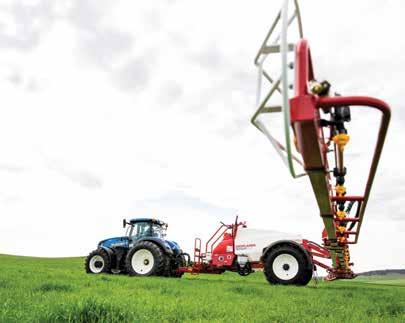

ogy ensures this high load of active ingredient equals or exceeds best in class standards of performance every time.
The result? Good adhesion, rapid uptake and excellent translocation through the plant tissue.
As Jeff and Mike explain, adhesion, uptake and translocation work together to overcome the plant’s natural survival response to shut down its transport system in the presence of a threat like herbicide.
“If the plant goes into defensive mode, and shuts down before the herbicide
attending, hosted by the UPL team together with the Lincoln Alumni and Development Office and Careers Centre.
Scott says the aim was to enable students to network, to highlight employment possibilities and to broaden their horizons. “We hoped they might gain something from those already in the industry.”
Guest speakers included Stephen
is translocated through its tissue, it can survive being sprayed. Without a lethal dose being quickly delivered to the roots, the root system will survive, and grow new shoots.
“CRUCIAL’s fast uptake and translocation prevent this from happening.”
CRUCIAL pours easily, won’t foam and tank mixes superbly with other products. It comes in a range of pack sizes, from the OHS-friendly 15 litre pack, all the way up to the larger 1000 L pod options.
For further details talk to your rural retailer or agronomist.
Guerin, CEO of PGG Wrightson, and Rakaia cropping farmer Simon Lochhead along with presentations from previous UPL scholarship winners; Kate Higgins, now a senior agri manager, at Ravensdown, Christchurch; Genevieve Steven, agriculture analyst, Rabobank, Christchurch; and Andrew Bateup, graduate John Deere, Brisbane, who shared their experiences.
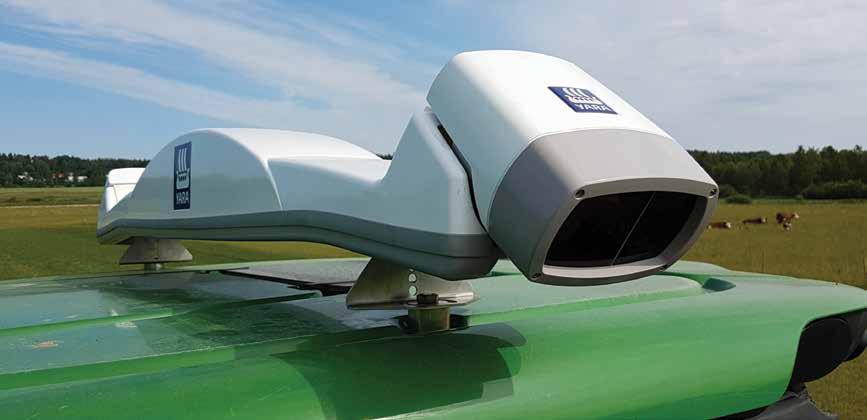

The Yara N-Sensor ALS-2 enables real-time variable rate application of fertilisers by measuring a crop’s nitrogen status in a precise, easy-to-use, and cost-efficient system.
With the sensor fitted you can:
• Measure crop nitrogen requirement as the fertiliser spreader passes across the field.
• Automatically adjust the fertiliser application rate in real-time.
Which means you can:
• Apply nitrogen variably in exact amounts, only where it’s needed.
• Improve yields and reduce costs.
• Improve harvest performance and machine efficiency.
To find out more about the N-Sensor, see how it works and how it can help you, scan below


With the price of urea going up close to 70% in the past 12 months (April 21-April 22), now is the time for farmers and contractors to look at what precision tools are available to help them make better decisions about and use of the nitrogen they are applying to their crops.
WORDS: YARA FERTILIZERS NZ
To this end Yara NZ has appointed Drummond & Etheridge as the New Zealand distributor for the Yara N Sensors.
"It's a proud moment to offer another layer of precision ag, and we're excited to partner with Yara NZ to bring the N Sensor to NZ," says Paul Galletly, research and development manager for Drummond & Etheridge.
Hayward Agriculture was one of the early user’s of the new technology.
A mixed cropping and sheep breeding and finishing operation run over 1600 ha just west of Timaru, the business grows 600-700 ha of arable crops every year, predominantly cereals, grass seed and pak choy.
It also grows 250-300 ha of annual summer and winter forage crops to support 5000 breeding ewes and annual finishing of 14,000 lambs.
Hayward’s Hamish Dunbar used the Yara ALS-2 N sensor last season, and here’s what he has to say about the technology.
“We took delivery of the ALS 2 late winter 2022, and have covered approximately
2000 ha with it since. In total we have harvested about 600 ha of arable crops grown with variable N application using the N sensor.
"The Yara ALS 2 N sensor has proved a versatile nutrient management tool across pasture, forage, and arable crops in our system.
“Real-time variable rate application has improved the evenness of our arable crops, while applying less N than the ‘traditional’ flat rate program without any sacrifice in yield.
“We have seen strong responses to the N sensor on forage brassicas, and we have also successfully used the Nsensor for real time application of plant growth regulators on cereals.”
The Yara N-Sensor ALS-2 offers farmers a solution to real-time variable rate nitrogen applications by adjusting rates according to crop growth while travelling across a field.
As a result, it delivers precise levels of nitrogen input according to the crop’s requirements, helping to both
leaves (dew) that affects all sensors and the reflectance accuracy achieved. Research was targeted to overcome this issue, culminating in the requirement to capture extra waveband data during sensing.
This ‘dew suppression’ is unique amongst sensors and is a feature in the ALS 2 N Sensor.
A new modular design and improved connectivity gives the ALS 2 more flexibility and easier mounting options.
The N-Sensor determines the nitrogen demand by measuring the crop’s light reflectance covering a total area of approximately 50m 2 / sec.
reduce environmental effects and maximise potential profit.
A dedicated group of scientists at Yara’s R&D base at Hanninghof, Germany carry out trial work annually to improve calibrations that exist currently and increase the range of options for use.
As such the N-Sensor truly is backed by science, and results in improved gross margins and greater nitrogen efficiency.
The Yara N-Sensor ALS2 is the culmination of well over 20 years of development work by Yara R&D.
Originating from the firstgeneration Passive N-Sensor in 2005, the Active Light Source (ALS) was introduced as a solution to restricted working hours due to low or no ambient light.
As the name suggests the ALS contains its own light source to continue operating irrespective of ambient light conditions.
In 2018 the ALS 2 was launched. During research and development, Yara had recognised the issue of damp
Measurements are taken every second with the system designed to operate at normal working speeds and across all bout widths.
Most sensing technology applied to agriculture is based on the typical light reflectance curve for vegetation (NDVI).
N-Sensor measures light reflectance at specific wavebands related to the crop’s chlorophyll content and biomass.
It calculates the actual Nuptake of the crop. Optimum application rates are derived from the N-uptake data and sent to the controller of the variable rate spreader or sprayer, which will adjust fertiliser rates accordingly.
The whole process of determining the crop’s nitrogen requirement and application of the correct fertiliser rate happens instantaneously, with no time delay. This enables ‘real-time agronomy and application’ to be possible.
The single biggest benefit from using the N-Sensor is also the hardest to measure.
However Yara has conducted a large number of trials over the years looking
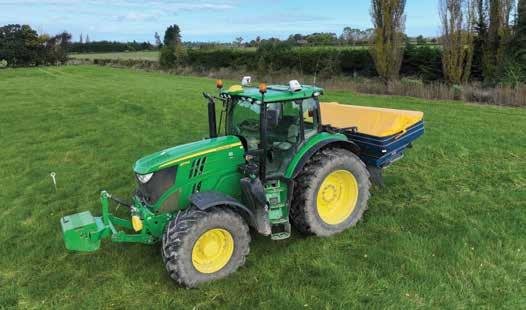
at the yields of uniform compared to variably applied nitrogen in the UK and throughout Europe.
The average yield increase compared to uniform application was 3.2% with a maximum of 12% on some trials.
Analysis has shown that where fields contain higher levels of variability due to changing soil types, manure application or topography, the benefit obtained from variable N application using the N Sensor was its greatest.
One of the most common benefits seen by customers is the reduction in lodging from using the N-Sensor.
Over application of N can result in crop lodging, which can have dramatic effects on profitability through reduced yield, quality and increased harvest time and drying costs. Lodging in OSR in particular as a result of too dense a canopy can have a severe impact on yield with losses of up to 30% possible.
Greater crop evenness achieved by using the N-Sensor also results in more
consistent ripening, which in turn leads to faster harvesting and shorter drying times.
In trials from 2002 to 2004, improvements in combine output showed output increase of 10% to26% across the trials
with an average of 18.5%, reducing the number of harvest days required.
By applying the crop’s optimum N requirement in all areas of the field, the NSensor has the effect of helping to reduce variability in yield and grain quality.
A trial carried out in 2002 looking into the application of late nitrogen in winter wheat showed that the variability in protein was reduced by over 60% were the NSensor was used, compared to uniform.
If you are wanting more information on N Sensors and what they can do for you on your property visit www.dne. co.nz/yara, or phone Yara NZ on 06 877 6600.
• Unique agronomically based, crop (wheat, oilseed, barley, maize, grass) specific algorithms.
• Unique spectral indices to accurately ‘sense’ variable nitrogen supply throughout the main growing season.
• Clean, accurate ‘sensing’ with no clouds, trees, landscape features to corrupt the data.
• Unlimited scanning, day or night, no waiting for satellites.
• Large ‘scanning footprint’ – up to 4.2m width each side of the sensor.
• Four wavelengths measured giving enhanced accuracy, suppressing the effects of damp leaves (e.g. dew).
• Apply optimal nitrogen fertiliser rate to every part of the field.
• Maximise crop potential across the whole field.
• Increase nitrogen use efficiency, reduce the risk of nitrogen losses to the environment.
• Decrease nitrogen residues in soils post-harvest.
• Reduce carbon footprints.
• Variable nitrogen applications from simple ‘switch on and go’, to more complex precision mapping and data management.
• Lightweight for easier, safer fitting.
• Modular design for more flexibility in fitting.
• LAN connections enable greater distances between sensor heads when mounting.
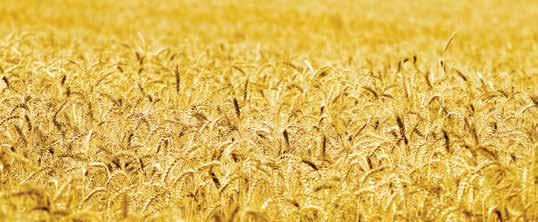




Two new label extensions from one of New Zealand’s leading crop protection suppliers are poised to make life easier for those growing forage brassica this season, including raphanobrassica.
Your crops will be better off, too! Corteva AgriScience has spent the past four years gathering data in support of the new extensions.
The first is for Milestone herbicide, which is now registered for broad spectrum weed control in raphanobrassica.
And the second is for Korvetto tank mixed with T-MAX, which is now registered for control of amaranthus (redroot) in all forage brassicas except raphanobrassica.
Marketing manager Glen Surgenor says both label extensions will be a shot in the arm for growers’ weed control programmes, because in each case they deliver clear improvement over previous existing options.
“Up until now raphanobrassica has been excluded from the Milestone label, because it’s a relatively new variety in the market, and we didn’t have the necessary crop safety data.
“But we’ve now done the work to show when applied according to label instructions, it doesn’t cause any long term effect on raphanobrassica crops.”
Better yet, it significantly broadens the weed spectrum for control in these
crops, because it catches the likes of thistle and willow weed which are more suppressed than controlled by Radiate as an existing option.
“Radiate is good for fathen and nightshade, but with Milestone you get those others that can be a problem, including spurrey.”
Trials to establish recommended Milestone rates and timing were carried out in Waikato, Hawke’s Bay and Canterbury, three regions where raphanobrassica has taken off, not least for its performance under dry conditions.
“We basically started working on the new label extension about the time Milestone was launched, because we could see that growers would need better weed control options for what was going to be a very popular crop.”
If you’ve used Milestone before in other forage brassicas, however, Glen says it’s really important not to assume the use rate is the same for raphanobrassica.
“It’s lower, and we need to be really clear about that – 500 mL to 750 mL/ha for raphno, vs up to 1 L/ha for other varieties.”
One of the trials done to support the new claim for Korvetto. To the front and right of the image are plants treated with the Korvetto + T-MAX tank mix, compared with untreated and other treatment plots from left of the white peg.
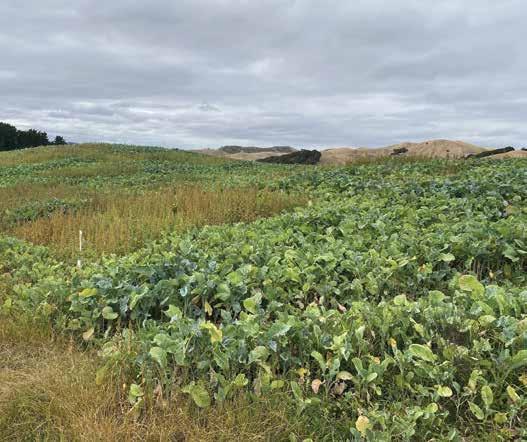
Turning to Korvetto, Glen says the prompt for pursuing this new label extension was recognition of how difficult it can be to get rid of amaranthus in forage brassicas.
Tall, and fast growing, this widely distributed C4 weed can form large, aggressive plants and seriously compete with crops if it is not well-controlled.
“Korvetto has some activity against it, but not enough that we could have guaranteed it so up until now amaranthus has not been on the label.”
So what’s made the difference now?
Adding 500 mL/ha of T-MAX to 1 L/ ha of Korvetto.
“We’ve been looking at the T-MAX tank mix for a while, just to make absolutely certain that it would provide the level of control we felt comfortable with. Then when we tested it against the standards, such as Milestone, it turns out the Korvetto + T-MAX mix is even better at removing amaranthus than the options we already had available.”
In comparative trials throughout the North Island, this new combination consistently gave the best results, every time, Glen says.
“It’s great to be able to come up with a solution like this.”
Again, growers looking to take advantage of this need to be aware that the clover plantback period for the combination is different to the plantback for Korvetto alone, he stresses.
“It’s three months for Korvetto, and six months for Korvetto and T-MAX combined. We’re currently working on making that period shorter.”
For more detail talk to your agronomist or arable rep.
• Milestone labelled for use on raphanobrassica, maximum rate 750 mL/ha.
• Korvetto (1 L/ha) tank mixed with T-MAX (500 mL/ha) labelled for amaranthus control in forage brassicas, excluding raphanobrassica .

















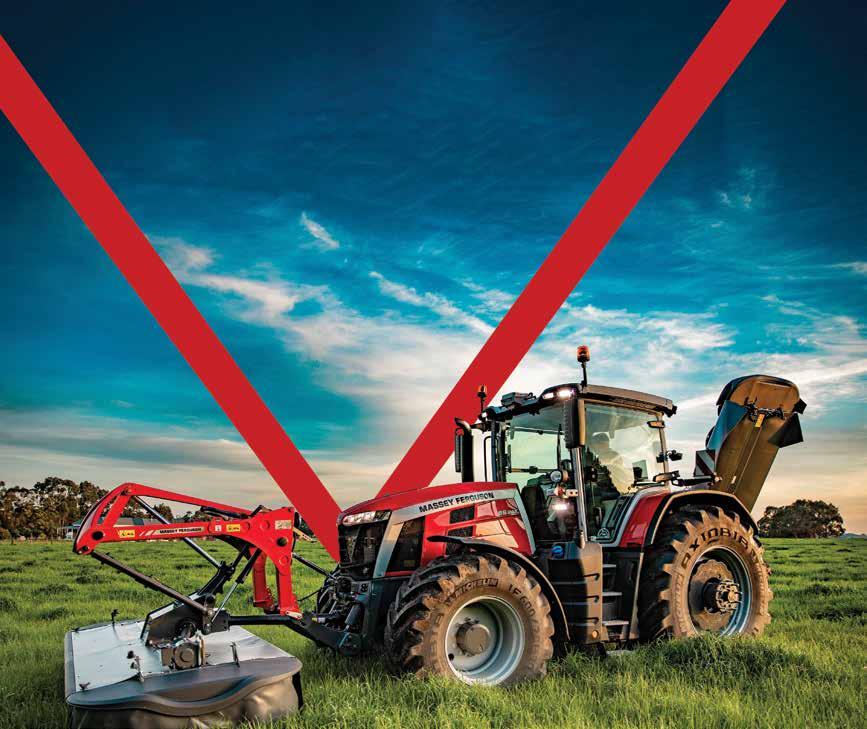
DESIGNED BY FARMERS FOR FARMERS
The Massey Ferguson 8S Series was born from 8 years of interviews with hundreds of farmers all over the world to understand what they wanted.
THE EFFICIENCY OF DYNA-7 AND DYNA E-POWER TRANSMISSIONS
Power to the ground where you need it most. Plus 25% increased efficiency and 5% better fuel economy.
100% CONNECTED
Free 5 year MF Telemetry Connect and optional precision farming suite for maximum uptime.
MULTI AWARD WINNER
The MF 8S has won awards all over the world, including the prestigious 2022 AE50 Award and the Farm Machine 22 Award for tractors in the 180hp to 400hp category.
THE ULTIMATE CAB ENVIRONMENT
Insulated from noise heat and vibration the MF 8S cab is one of the quietest on the market with just 68dB noise rating.
OUTSTANDING VISIBILITY
With 6.3m3 of glass area in cab and the slopping bonnet design further enhances the forward view.
Check out the MF 8S and you will quickly realise why these tractors are rated a 10 out of 10.

With a huge 9,000L per minute output, up to 36m wide Vogelsang Dribble Bar and accelerated filling technology, the Veenhius Premium Line Slurry Tanker from FarmChief saves you time and gives you more.
Our fully-automatic dosage and proof of placement system speeds up application, reducing the time taken to adjust application rates, keeping the operator moving and the customer happy.
Accountability with precision application technology FarmChief offers the latest Veenhuis precision application technology; the Nutriflow Near-Infrared analyser.
Give customers certainty by measuring and reporting on the nutritional content of their effluent with real-time visualization of performance and precise documentation for environmental compliance, whilst saving time and money by reducing sampling expenses.
Give your application an edge over the competition.

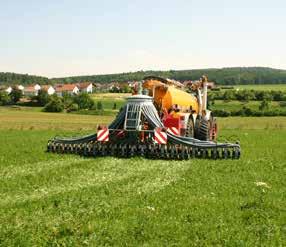
Tailored finance packages available to get you into the field faster. Talk to us today!
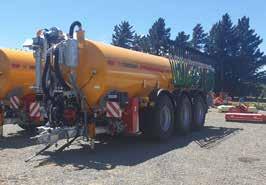



Enviro Collective has been working with Mid Canterbury irrigation schemes to develop a novel approach to nutrient management, called Advanced Mitigation. This focuses on real actions which reduce farm expenses while also meeting regulatory outcomes.
Barrhill Chertsey Irrigation Limited (BCI) is a farmer-owned collective which delivers water to its shareholder, and those of Acton Farmers Irrigation Co-operative (AFIC).
Our irrigators farm over 60,000 ha across Mid Canterbury, of which over 30,000 ha is used for arable and horticulture.
Mid-Canterbury has elevated groundwater nitrate levels and farms are regulated to improve groundwater quality over the next 10-15 years.
In Canterbury, on-farm nutrient discharges are usually managed through individually modelled nitrogen loss limits.
For schemes like ours, managing farms as individuals was expensive, time consuming and led to inequitable outcomes between our diverse shareholders without incentivising on-farm changes needed to improve water quality.
Our farmers challenged us to do better.
They told us they wanted to be accountable for their actions, not a modelled number, and to spend their money where it would make a difference. They also wanted fair and equitable expectations between shareholders and to reward better practice.
The solution we came up with was Advanced Mitigation, a set of auditable targets that go beyond Good Management Practice which could be modelled in our catchment nitrogen load calculator tool called The Matrix.
Advanced Mitigation identifies cost-neutral or beneficial practices that achieve regulated reductions in N loss to groundwater.
The five outcome-based targets strive for further improvements in irrigation, nutrients and point source management and expect more from higher risk activities compared to lower risk activities.
Our best performing farmers were already using Advanced Mitigation practices so we knew these were achievable and provided tangible benefits to those using them.
Advanced Nutrient Mitigation for an arable farm encourages continuous improvement where the farmer collects quality information to feed into their fertiliser and cropping plans; monitors performance over the season, adjusts as needed and collects information to review and update plans for the following year.
By understanding how
variability arises in their crop yields, fertiliser regimes can be adjusted to maximise yields per kg of fertiliser applied.
Advanced Irrigation Mitigation aims to optimise the capture of rainfall during the fringes of the season and match water applications to crop demand.
Ensuring optimal soil moisture levels throughout the season for each crop reduces the risk of excess water draining nutrients to groundwater. Flexible irrigation systems which can target irrigation applications by crop are essential for achieving Advanced Mitigation.
Advanced Point Source Mitigation aims to tighten up potential direct sources of contamination into groundwater. Farmers need to make sure the basics are sorted, such as secure wellheads, soakholes that drain clean
water and use of offal and rubbish holes are minimised.
Hewson Farm (Penlyn) case study
Ross and Rochelle Hewson bought the 388 ha Penlyn Farm near Chertsey in 1999. Originally a dryland mixed livestock and cropping farm, irrigation from groundwater was added in 2000 and the Hewsons shifted their focus to higher value mixed crops with sheep, removing fencing in the process.
Crops include exportquality potatoes, onions and smalls seeds as well as cereals, grass and clover seed.
They have always seen early adoption of technology as key to delivering economic and environmental goals for their businesses. Hewson Farm’s business objectives include:
1. Keep it simple.
2. Maximise return on capital.
Over the past 30 years, they have steadily made small improvements to improve fertiliser and irrigation use efficiency, reducing costs and improving the quality and consistency of their product.
By integrating new cul-


tivars as they became available, close monitoring of soil fertility and accurate measurement of yield, Ross has been able to produce four times more ryegrass seed and over twice as much wheat per kg of N applied.
Ross and Rochelle noticed variance in crop yields on Penlyn Farm aligned with historic paddock layout, prompting use of precision fertiliser to optimise yields and grow more consistent crops.
To balance pH and optimise N uptake, grid sampling and variable fertiliser has
been in place since 2016.
Every paddock is soil tested every year and key crops are tested for available N. Crop progress is monitored using satellite imagery and drones, with herbage tested if issues are identified.
At harvest, paddock yields are measured using yield maps, which helps identify parts of the paddock which are producing well or poorly, giving them the information they need to adjust their programme for the following crop.
The high cost of pumping deep groundwater and
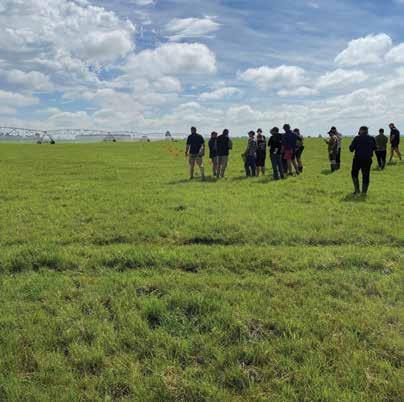
improved crop quality from accurate irrigation decisions saw the Hewsons invest early in irrigation systems and soil moisture monitoring tools.
All irrigation systems on Penlyn Farm are designed to apply the amount of water needed to top up soil moisture without causing drainage.
Irrigation systems are remotely controlled using FieldNet, enabling the team to programme and manage irrigation as needed.
Calibrated soil moisture sensors are used to monitor soil moisture status for a
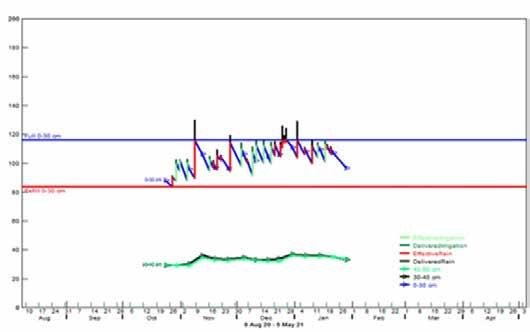
range of crops both at the surface and below the root zone, identifying any rainfall or irrigation draining to groundwater.
Lower irrigation trigger levels in the spring mean less water is applied when potential evapotranspiration (PET) rates are low and capacity to capture rainfall is high.
The Enviro Collective team has been working with Mid-Canterbury irrigation schemes for nearly a decade developing and implementing environmental programmes.
Our services include wrap-around environmental advice for scheme shareholders to address groundwater nitrate challenges in our catchments.
In 2022, Barrhill Chertsey Irrigation Limited, Acton Farmers Irrigation Cooperative, Rangitata South Irrigation Limited (RSIL) and senior staff created Enviro Collective to share our experience beyond the schemes and support all farmers, communities, and catchments with sustainable environmental solutions.
We particularly thank Ross and Rochelle Hewson and their management team for opening their gates and sharing their story.
For more detail visit envirocollective.co.nz.
If there’s one thing aphids like, apart from feasting on your young wheat and barley seedlings, it’s warm weather.
Temperature makes all the difference to the life-cycle of this tiny, potentially costly insect pest.
In general, the warmer the weather, the faster it develops, reproduces, survives and migrates, taking as little as 5-7 days to complete a generation.
In favourable conditions, adult aphids produce 3-5 nymphs per day for up to several weeks, creating rapid population build-up. The nymphs pass through several generations before moulting into adults, and go on to rapidly produce more wingless offspring of their own.
Most aphids in a colony will be wingless, but when things get crowded or food gets scarce, some will develop wings, and fly away to a different part of
the crop, or a different paddock, to start a new colony.
Why does this matter?
“Autumn was warm!” points out Nufarm territory manager and arable specialist Jeff Hurst. “And that means higher risk of winged aphid flights.”
Which in turn means higher risk of infestation, and subsequent disease.
Aphids are the main vector for Barley Yellow Dwarf Virus (BYDV), in particular the cereal aphid (Rhopalosiphum padi ) and the rose grain aphid (Metopilophium dirhodum).
In either case it doesn’t take many of them to cause an infection.
“That’s why monitoring crops for any sign of aphids is so important,” Jeff says.
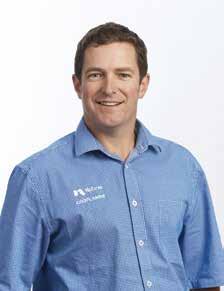
“There are aphid suction traps in some regions, which give an indication of the number of winged aphids present during the risk period, but they don’t represent secondary spread of BYDV in a crop.
“Nothing is better than getting out into your paddocks and looking for yourself to find exactly what is present.”
Wheat and barley crops are most susceptible to BYDV infection from emergence until the start of stem elongation.
If aphid control is required, Kaiso 50WG from Nufarm is a synthetic pyrethroid insecticide that contains 50 g
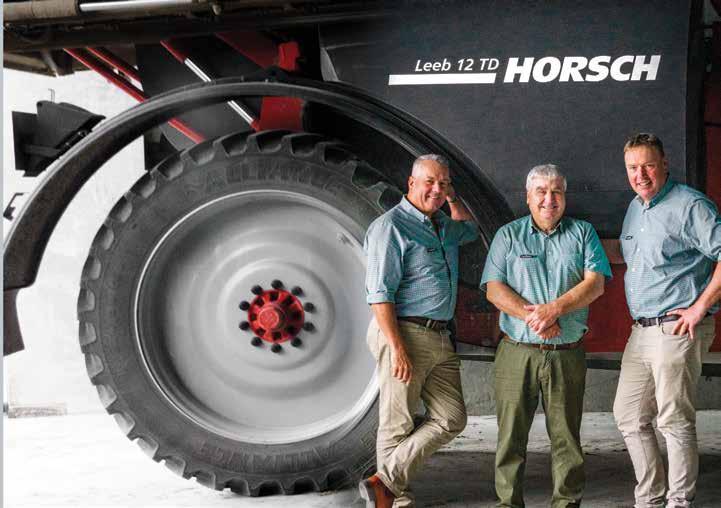

As New Zealand’s only remaining commercial oat miller, Harraway and Sons Limited is very skilled at creating great tasting, healthy breakfast foods with Southland farmed, premium rolled oats at the core.
WORDS: PETER COX, MARKETING AND NEW PRODUCT DEVELOPMENT, HARRAWAYS
St ill privately owned and operating from the original mill created in 1867 in Green Island, Dunedin, Harraways is the clear market leader in the burgeoning $26.4 million retail sales value, traditional oats market in NZ.
A consumer segment within this traditional market, and experiencing strong growth and interest is convenient, flavoured/fortified, value added oat mixes.
To continue to offer exciting, convenient breakfast alternatives in this space, Harraways is launching to consumers tasty, great priced, value-added oat mixes (e.g. flavoured and/or health fortified) for breakfast.
A good example here is the immunity boost, fortified, blackcurrant spiced apple rolled oat mix, launched in 2022. Available at Countdown and participating New World and PNS stores nationwide, shoppers can pick up an 850g bag for around $6.50, or 36 cents per 45 g serving!
Terrific value in these times of high
inflation and household cost pressures. Immunity continues to be at the top of everyone’s mind in these times of winter ills and chills, and engineering a product that fortifies immune health with a great tasting fruit and oat recipe continues to create a lot of interest at the supermarket shelf!
So let’s learn a bit more about immu nity and how this product works.
The NZ Adult nutrition survey (2008/09) reported that one in four Kiwis aged 15 years and over had an inadequate intake of zinc.

Iron deficiency is associated with increased susceptibility to infection.
Zinc is an essential nutrient, which means we need to get more of this from our diet. Amongst other important functional things, zinc assists adequate function of the immune cells in the body. This new product is fortified with zinc.
Low iron is another deficiency, with child-bearing women, children and teenagers most likely being affected.
In NZ, one in 14 women is low in iron. Like zinc, iron is a very important nutri-
Iron has many important roles for the body, including it being a fundamental element for normal immune system development.
This new product is also fortified with iron.
This featured oat mix can be enjoyed as a warming porridge over winter, or it is great for incorporating into tasty baked oat dishes.
For more detail, visit www.harraways.co.nz, or connect with us via Facebook, Instagram or Tik Tok.
per kg of the active ingredient lambdacyhalothrin, with some key formulation benefits.
Developed and patented by Nufarm, the Sorbie Technology found in Kaiso 50WG combines the benefits of emulsifiable concentrate (EC) and water dispersible granule (WG) formulations.
It looks like a water dispersible granule, but once added to water, behaves like an emulsifiable concentrate, meaning easy measuring and mixing, with no dust to worry about and no rinsing of measuring jugs or containers required.
This is different to other products available in the market with the same active, which are either EC or suspension concentrate (SC) formulations.
Farmers and contractors appreciate Kaiso 50WG’s unique combination of ease of use and efficacy, Jeff says.
“It has all the user friendly handling and mixing attributes of a WG, including stability, volumetric measuring and enhanced operator safety e.g. no splash, non flammable and easy clean up if spilt, but it functions with the same efficacy parameters as an EC formulation when it is mixed with water.”
Kaiso should be applied at the first sign of aphids. Use the lower rate when aphid pressure is low, and shorter residual activity is required.
A second application may be needed if aphids continue to migrate into the crop. Ensure sufficient water volume is used to give thorough crop penetration and coverage.
Kaiso 50WG is a Group 3A insecticide, and qualifies for Agrecovery.
For more advice on using Kaiso 50WG to protect cereal crops from the effects of

BYDV this season, talk to your rural retailer or agronomist.
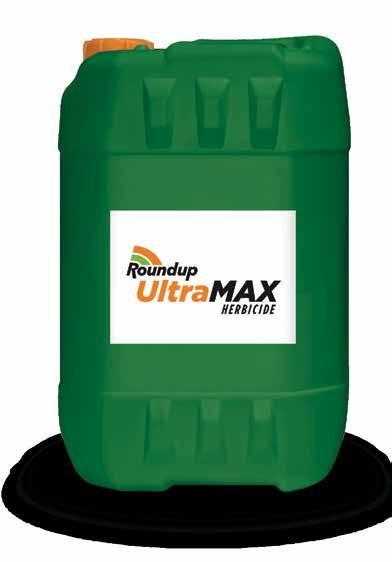
When it comes to glyphosates, for generations Roundup has been the standard by which all others are measured.
The latest generation Roundup Ultra®MAX with the superior surfactant TRANSORB II® is no exception.
⊲ Every drum of Roundup Ultra®MAX is manufactured to the highest standards.
⊲ The powerful surfactant system in Roundup Ultra®MAX ensures rapid penetration into the plant, delivering fast brownout and quicker translocation to the roots.
⊲ Roundup Ultra®MAX sprayed paddocks can be grazed (except where ragwort is present), cultivated or drilled just one day after spraying for annual weeds, and three days for perennial weeds.
⊲ High load, low viscosity and low foam formulation.
⊲ Available in a range of pack sizes.
GET THE SPRAYOUT RIGHT FIRST TIME, EVERY TIME
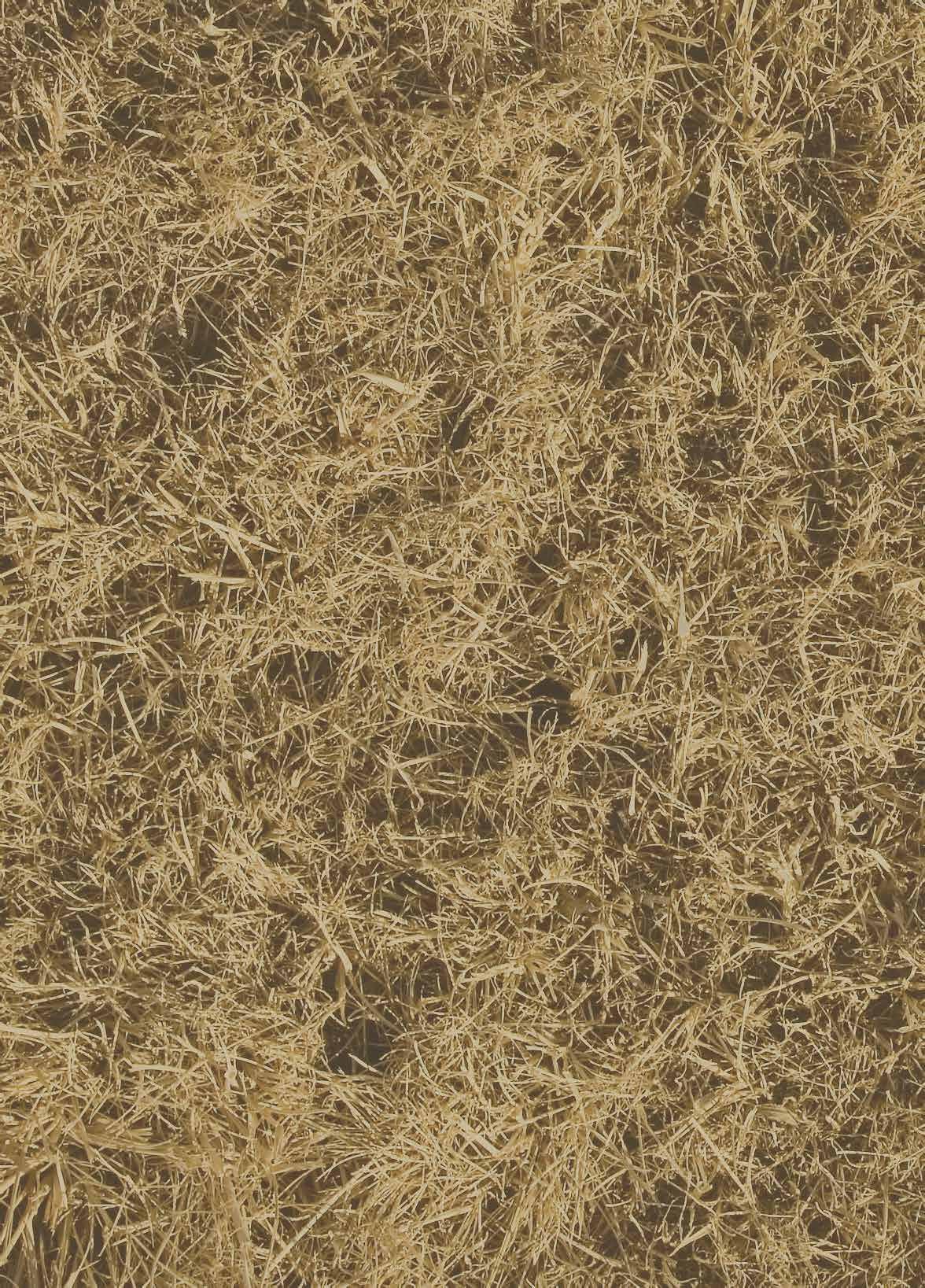



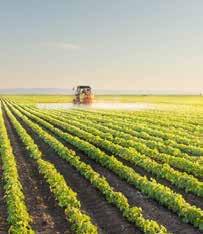
Aerial and ground spray applicators can help protect bees:
Avoid spraying in windy conditions to prevent drift. Take into account wind direction and atmospheric stability.
1 2 3 4 5 6 7 8
Implement an integrated pest management plan to apply pesticides only when necessary.
Coordinate with local beekeepers before spraying so nearby hives can be moved or otherwise protected.
Follow the instructions on the label to ensure you use only the recommended dose.
Use drift-reduction application equipment that is well maintained and calibrated.
Avoid spraying pesticides when bees are foraging.
Avoid contamination from spray liquids when mixing and properly dispose of waste and other used materials.
Use genuine products and alert authorities of counterfeit or illegal pesticides as they have unknown impacts on wildlife.
Wind damage is the largest cause of claims for irrigators, says FMG’s manager of advice services Angela Taylor.
“In spring the frequency and severity of foehn winds rise, which increases the risk of irrigators blowing over. The total cost of 2021’s spring windstorms was around $3.5 million in settled irrigator claims.”
FMG wants to support farmers and growers to limit the disruption irrigator damage can have on their business.
“We’ve worked with the team at Irrigation NZ to provide resources to help farmers and growers reduce the risk of wind damage. Using our claims insights, together we’ve developed an irrigator advice guide. The guide provides practical advice on how you can limit the risk of irrigator damage.”
Included in the guide is how to ‘Point, Park, and Anchor’.
“This is the most important part of our advice, but farmers and growers also need to have a plan so that when high winds are forecast, owners and their staff know exactly what to do.
“Also, parking irrigators up against hedges in windstorms does put the irrigator at risk of having trees or branches falling on the irrigator.”
Pointing your irrigator either into or away from the wind (if possible) remains an effective way to reduce damage to your irrigator in high winds. This reduces the surface area exposed to the wind.
Once it’s pointing into the prevailing wind, park it there until the winds dissipate. Liner/lateral irrigators should be installed so that it’s pointed down the dominate wind direction. Pivot irrigators should have one or two established parking spaces that are facing downwind.
Anchor
Look at the guide to find advice on how to anchor your irrigator effectively.

Irrigation NZ suggests having movable anchors to secure your irrigator which will allow your team to mobilise a lot quicker to secure the irrigator. Examples of these are concrete blocks (minimum weight of 500kg) or pegs/pins which can be lodged into the ground using a kanga hammer. Head to fmg.co.nz/irrigators for more information, including access to the free Irrigation Guide to help protect your irrigators.
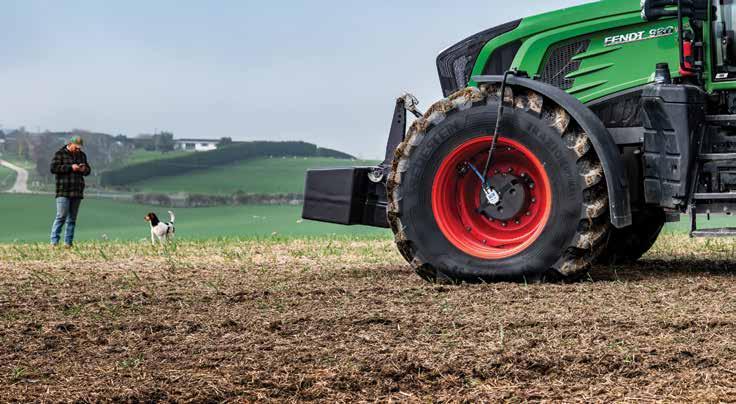
There’s been more than a few breakthroughs in that time. Like the original Traxion tyres that we introduced 25 years ago – and every pattern since that has seen improved operating efficiency, soil protection and operator comfort. Now we’re pleased to wrap all of that development into the Traxion Optimall VF. Welcome to a future of higher loads, lower pressures and groundbreaking efficiency.
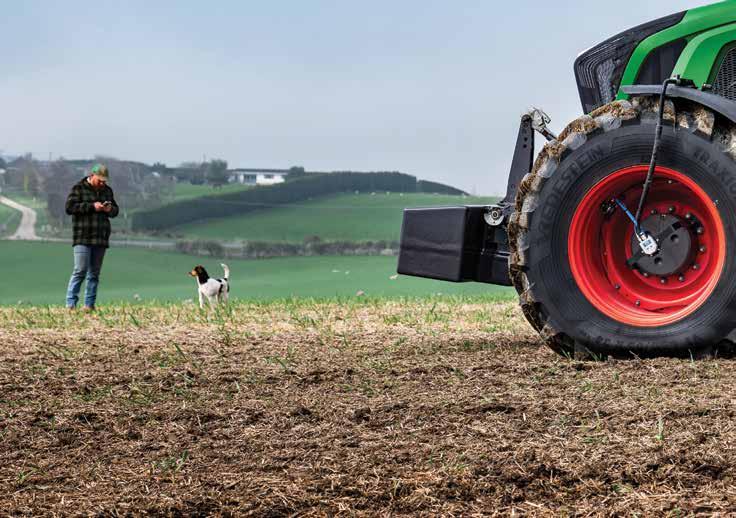
All eyes are on the European Commission as it deliberates over a decision to ban one of the most important agricultural innovations of our time.
WORDS: MARK ROSS
The use of glyphosate in European countries reaches a crossroads as the re-authorisation of glyphosate expires this year.
As the decision looms, farmers fear that a ban on glyphosate would see their crops taken over by deep-rooted weeds and suffer quality losses, alongside a reduction in farm productivity and food security.
Environmentalists are concerned about increased carbon emissions and a detriment to soil health and erosion.
The European Food Safety Authority (EFSA) - which issues advice on existing and emerging food risks, to inform European laws, rules and policymaking – postponed making a final scientific opinion on the re-evaluation of glyphosate until July 2023.
At the centre of the decision is whether the weedkiller is carcinogenic.
The European Chemicals Agency Risk Assessment Committee concluded, in May 2022, that classifying glyphosate as a carcinogen was not justified.
The committee found that the available scientific evidence did not meet the criteria to classify glyphosate for specific target organ toxicity or as a mutagenic or reprotoxic substance.
This finding will feed into a risk assessment by the EFSA, which will as-
sess all possible risks that exposure to glyphosate might pose to humans, animals and the environment.
The European Commission will then analyse the conclusions, before issuing a renewal report and a draft regulation on whether glyphosate can be approved for use.
Further discussions will take place ahead of a vote by the Member States on the Commission’s proposal.
In New Zealand, the Environmental Protection Authority is also deciding whether to reassess glyphosate, following a report it released last year in response to its call for information on the world’s most widely used herbicide.
Keeping farming on tenterhooks, it is likely waiting on the European decision before making its own decision on a reassessment.
Any changes to the regulation of agricultural chemicals in Europe will result in critical crop protection tools and associated import tolerances being unnecessarily withdrawn from the European market, severely impacting trade.
If such a precedent is followed in NZ, farmers would be forced to switch to less effective techniques and resort to old destructive, labour-intensive, and counterintuitive practices like tillage.
Tillage fractures the soil, disrupting



Mark Ross is chief executive of Animal and Plant Health NZ, the industry association for companies that manufacture and distribute crop protection and animal health products. The association was previously called Agcarm.
soil structure, leading to soil erosion, and releasing greenhouse gases into the atmosphere. It also reduces crop residue, which helps cushion the force of pounding raindrops.
Without soil residue, particles become more easily dislodged and can be moved or 'splashed' away, allowing run off into nearby streams, gullies and rivers.
Sediment turns the water brown and is eventually released into the sea, affecting sea life.
Contradicting current environmental goals is the contribution that tillage makes to climate change.
Plants absorb carbon dioxide from the atmosphere through photosynthesis and pass carbon to the ground when dead roots and leaves decompose.
Tillage releases this carbon from the soil to the atmosphere, contributing to global warming.
The dramatic dichotomy between global scientific consensus and public policy and regulation has sparked global apprehension about what comes next for global food security and the possible return to a bygone era.
While there will be a scientific discussion, the ultimate decision on whether to re-authorise glyphosate - and for how long - will likely be a political one.
Delivering a complete suite of crop protection solutions for today’s forage brassica growers.
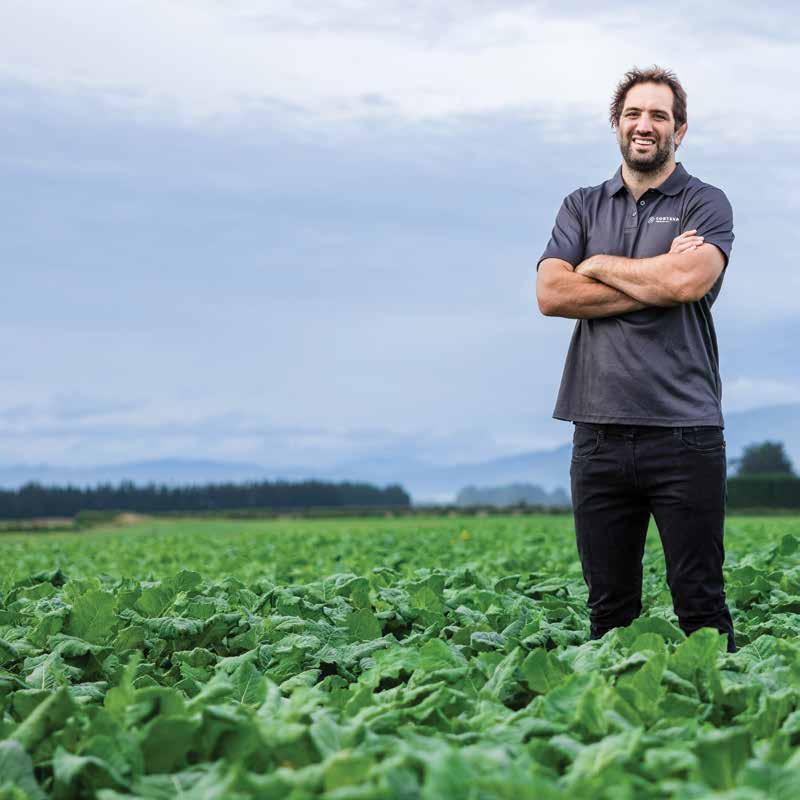
Our portfolio of powerful, proven products has helped farmers from one end of the country to the other create and maintain thriving businesses, and has earned us a reputation as New Zealand’s brassica protection specialists.
With every product suitable for ground or aerial application, our suite of herbicides and insecticides provides local farmers with everything they need to win the war on pests and weeds. Visit corteva.co.nz to view our range of online brassica resources.
ADAMA NZ portfolio manager Hamish Mulcock says the stacked chemistry of DMIs provide the extra-level robustness that cereal protection toolboxes need in the era of increasing fungicide resistance.
DMI stacking (also known as triazole stacking) is where two DMI fungicides (Group 3) with different cross resistance profiles are applied together.
These are used to control fungal diseases including Septoria ( Zymoseptoria tritici or speckled leaf blotch) in wheat, Ramularia (Ramularia collo-cygni) in barley, and Eyespot (Pseudocercosporella herpotrichoides) in a variety of cereals.
Hamish says for the stacked fungicides to provide a real benefit it is important that they have different cross resistance pathways.
Bolide® features an innovative combination of stacked epoxiconazole and prochloraz – complementary DMI actives.
Hamish explains that, in the DMI fungicide ‘Group 3’, epoxiconazole is categorised as part of the triazole chemical family, while prochloraz is in the imidazole chemical family.
He says that within a disease population such as Septoria there are a range of isolates with varying sensitivity to DMI fungicides.
“The benefit of ‘stacking’ DMIs with different cross resistance pathways, is that isolates insensitive to one DMI may be controlled by the second.
“New Zealand trials results have demonstrated that the Bolide co-formulation
provides increased efficacy and yields when you compare it with applying similar DMIs solo.
“Bolide® has proved an excellent solution to control Septoria, Ramularia and Eyespot, all serious threats to cereal crop yield.”
The all-rounder DMI fungicide is taken up via the stem and foliage and translocated upwards and outwards, providing protection for new growth.
DMIs should be considered the backbone of Septoria fungicide programs in wheat, Hamish says.
“Bolide provides an excellent, and flexible option providing early season disease control at either the T0 or T1 timings.”
At T0 timing, in wheat, Bolide gives early season preventative Septoria control in susceptible varieties and during wet seasons.
“Bolide also has an excellent fit at the T1 timing with critical protection of leaf 3 as it emerges. Tank mixing Bolide with Phoenix at T1 timing is encouraged to further boost efficacy and enhance resistance management.”
As Bolide combines protectant, curative, and eradicative properties it is also an option for later season diseases including rust, powdery mildew and ear disease complex.
“Stacking DMIs is vital for further reducing the risk of fungicide resistance. To
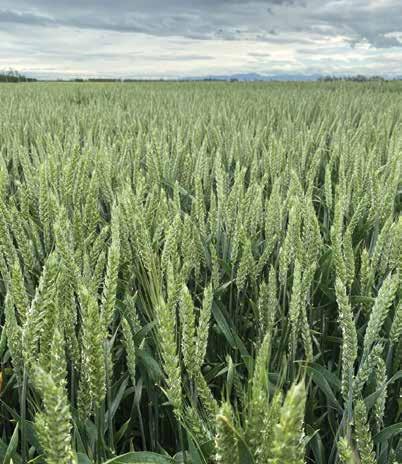
complement this, we’d also recommend growers have an integrated disease management approach to fungicide resistance including selecting cultivars with high disease resistance ratings, cultural control measures including crop rotations, sowing dates, irrigation and general crop hygiene, mixing with multisite fungicides such as Phoenix (folpet) and rotating strategic use of at risk chemical groups like SDHIs.”
Phoenix® (phthalimide – Group M4) is a multi-site protectant, which works against Septoria at a cellular level on three sites.
Currently there is no known resistance to folpet anywhere in the world.
Hamish says Phoenix also enhances DMI uptake, increasing their speed of action and efficacy.
“In terms of cereals and combatting resistance, Bolide and Phoenix are ideal partners in a tank mix.”
Phoenix works against Septoria and Ramularia at a cellular level, inhibiting spore germination and cell division, and reducing energy production in the mitochondria.
Wetter seasons have increased Septoria pressure in wheat through late winter
and early spring.
“Uncontrolled Septoria is still a real risk to yields, especially in the more susceptible varieties. What’s important here, is to think about how we protect both new and existing chemistries and to learn from our own and overseas experience.”
Hamish says the speed and complexity of mutations in Septoria and Ramularia have challenged cereal growers globally for over a decade.
Plant breeding for increased disease resistance is key but this still needs to be complemented with diligent stewardship of new and existing chemistries.
And Septoria and Ramularia aren’t the only cereal diseases where Bolide has a lot to offer.
“Bolide is also an excellent fit for controlling eyespot, where required, at T0 timing.”
Eyespot is a common disease affecting wheat, barley, oats, rye, and triticale.
Effective control is particularly important in susceptible cultivars and where there is elevated disease pressure - for example - in second year wheat paddocks.
For more information contact your local rural supplier or your ADAMA commercial manager.

There are goodies and baddies lurking everywhere in your fodder beet crop. Fortunately, MAVRIK® AQUAFLO can tell the difference.
MAVRIK AQUAFLO offers powerful control of Nysius and cutworm in your fodder beet and NOW forage brassica crop. This unique SP insecticide is IPM friendly and crop-safe, yet highly effective against pests.
MAVRIK AQUAFLO is far more user-friendly than existing OPs, but no less effective. Combined with our other fodder beet specific products, like GOLTIX® GOLD, TOREROTM, ETHOSAT® and RIFLE®, it will help maximise the return from your crop.
Contact your local merchant or ADAMA Commerical Manager for more details. Visit www.adama.com

German technology that’s already made crop drying easier and more efficient for an increasing number of arable farmers is now better yet, says New Zealand’s only Schmelzer distributor.
REL Group started distributing Schmelzer equipment five years ago, concentrating on its concrete trench, drive-over aeration floors for flat storage drying sheds.
This year, says Hayden Kuyf, there’s a new Schmelzer floor option, and it’s quite possibly the most flexible in-floor drying system available.
“The real benefit is its ability to be retrofitted into an existing shed, and for this to be done in a way that minimises height loss.
“Existing shed height is always an issue with a retrofit, but this system uses one metre square perforated panels laid over I-beam support on existing concrete floors. Because of this, we can get the height of the new floor down to 125 mm vs the 300 mm you’re looking at with other systems.”
There’s no concrete cutting either, so there are no dead spots in the finished floor, and that means more even crop
drying. Also newly available through REL from Schmelzer this season is a robust stirring system for flat storage drying sheds, Hayden says.
This is notable for its eight-inch mixing screw, significantly larger than the more commonly available three to fourinch size screw.
“Stirring systems of this type haven’t been super common on farms in NZ, mostly because historically they haven’t been very reliable. But this one is different – much stronger, with a bigger auger and fewer moving parts.”
So what would be the benefit of using such a system?
“It’s all about efficiency,” Hayden says. “Stirrers increase your drying capacity by allowing you to increase the depth of the product. The maximum depth on a concrete/metal drying floor without a stirring system is two metres; add one of these and you can go to three metres, plus you get a more even dry
Bigger, stronger grain stirring system increases drying capacity.
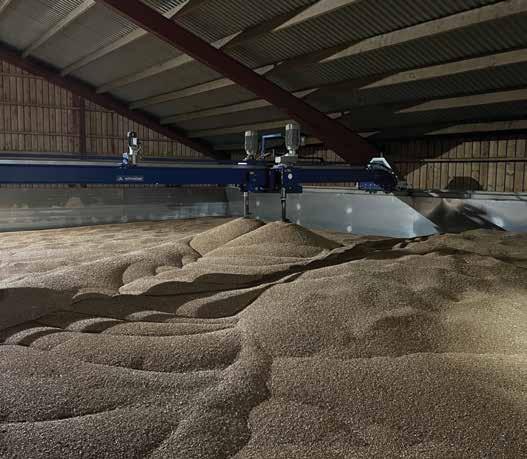
throughout the whole volume.”
And for commercial grain handlers, or people with continuous flow grain dryers, Schmelzer has a new lined drop tube pipe which Hayden says can increase drop tube life span by eight to 18 years, depending on the model chosen.
“We have those available now. They’re made of polyurethane lined galvinised pipe, which reduces wear on existing drop tubes so you don’t have to keep checking and rotating them so often.”
Hayden says NZ growers investing in drying infrastructure are prompted both by increasingly erratic weather patterns as well as associated systemic benefits.
“There’s a lot at stake when you’re growing specialist crops these days. They’re high value; they require high inputs and the specifications are becoming tighter.
“So yes, some form of drying system will in the first instance allow you to get your crop off the paddock in case of bad weather at harvest, like we’ve just had.
“But it also allows you to get the product off the paddock when the grain or seed is fit; when it’s ripe, but when moisture is still high.”
Grass seed is a good example, he says. It can be perfectly ripe, but still have 15% moisture.
Without a drying system, growers then have to rely on ‘the big hairdryer in the sky’ to get that moisture down to the 11% specified in their contracts before they can get the header in.
That then delays re-planting if the weather doesn’t co-operate, and compromises establishment and growth of the following crop, which is often winter feed.
“Having those arable crops in the ground for an extra week or two in summer, while you wait for them to get down to the right moisture level for harvest, can cost a month’s worth of winter feed yield, simply because you’ve missed those optimal autumn sowing conditions.”
Based at Rakaia in mid Canterbury, with offices throughout NZ, REL Group is a privately owned company founded in 1987 to fill a void in the New Zealand market for steel sheet fabricated silos.
Today it has over 40 team members involved in production, sales, service, installation and delivery of a wide range of grain storage and handling systems; meal feeding systems; dairy sheds and wintering barns; effluent and water tanks; and machinery.
For more detail visit www.relgroup. co.nz or call 03 3027 305.
South Canterbury growers Peter and Nicole Hewson installed New Zealand’s first new retrofit Schmelzer drying floor last season.
And even though the 2023 harvest meant their crops didn’t need any serious drying, they were able to contract dry 55 tonnes of peas for a neighbour with no problem, as well as using the system to take the heat of the day out of their own grass seed crops.
“We had grass at 1.7 m deep over the floor and had huge air flow even with the fan on low -we were very impressed.”
Located in Esk Valley south of Timaru, the Hewsons have been on the family farm since 2016.
Their 485 ha of flat to rolling country can all be cropped, and they sow about 360 ha a year into wheat, barley, ryegrass, fescue, cocksfoot, forage seed rape and turnips, plus maize silage contract grown for local dairy farmers.
The balance of their land is in permanent pasture rotating within cropping round for three to four years, and used for finishing 100 kg Friesian bull calves to 570-600 kg and also for wintering store lambs.
Peter’s father David invested in Shiv-
vers grain drying system in the late 1970s which still works, and works well for grain, Peter says, but is time-consuming when it comes to grass and brassica seeds.
“Using it for these crops involved shovelling out the entire silo once dried, which took a couple of hours on a summer morning when we should have been getting ready for the day’s harvest. Which made me think – there must be an easier way to do this!”
Hayden Kuyf at REL told them about the new Schmelzer retrofit panel floor system, and the Hewsons were quick to find an existing shed for the upgrade, which they were able to do themselves
“There was no modifying the shed floor – we bolted down I-beams and put the panels on top. The floor area is four metres wide by nine metres deep with a 25hp fan delivering the air in conjunction with a REL diesel burner,” Peter explains.
“This system allows us to tip off straight out of the trailer, and once the crop is dried it can be scooped out with a telehandler by a single person. That’s probably saving us 1.5 hours per trailer load compared with our other system.”

I-beams in place to support the Hewson’s new retrofit drying floor.
Plenty of room for the neighbour’s peas.
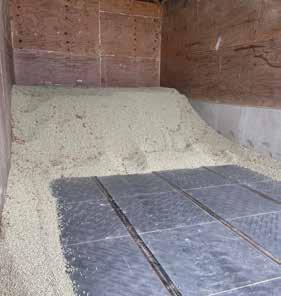
With up to four hoppers the Sky EasyDrill sows a t two dif fer ent depths simultaneously, making it ideal for establishing a multitude of seeds
Ther e is minimal disturbance to soil while also of fering cover and diversity to the far ming system through crop rotations
• Computer controlled row shut of f for accuracy and to suit a variety of row spacings.
• E-Drive Pr emium option (ISOBUS SectionControl
• Working widths between 3m - 8m.



Contact your local Case IH dealer today. KEEP MOVING FORWARD
Since our humble beginnings with some good parts, solid vision, and plenty of red paint, Case IH has to grown to serve all who work the land. We’ve crossed continents, from the arctic to the arid, and everywhere in between, always striving to break new ground. Innovating over 180 years has seen us bring productivity, autonomy, and confidence in even the most hard-bitten conditions. That’s why our staying power’s about more than just our horsepower (although there’s plenty of that). Case IH and farmers go way back. And we’ll keep you moving forward. It’s what we do.

Most regions of New Zealand experienced an unusually wet winter and spring in 2022. For many arable and mixed livestock/arable farmers these conditions highlighted soil drainage issues.
WORDS: BILL RITCHIE, CARRFIELDS REGENERATIVE FARMING PRODUCT SPECIALIST
When planning to deal with drainage problems, it is important to clearly identify whether you have micro or macro drainage issues.
To determine this, the first step involves a very simple and often neglected tool – the spade. Dig some holes and look at your soil composition.
From a micro-drainage perspective, soil structure is the key.
Look for a nice crumb structure throughout the profile. Ideally, employ the Visual Soil Assessment (VSA) from Landcare Research-Manaaki Whenua guide to help provide an objective measure of the state of your soils.
Also useful is the very good FAR publication Good Soil is Good Business.
Generally, the more a paddock has been disturbed by cultivation or stock pugging, the more likely its soil structure will be degraded.
Don’t assume that continuous cropping will necessarily be the same as continuous cultivation.
Image 1 shows soil samples taken from two adjacent fields in Wairarapa. One field is close to farm sheds and was put into permanent pasture about 50 years ago.
It has only been grazed since.
The adjacent field has grown combinable crops continuously using no-till for at least 20 years. See if you can tell which is which.
From a soil structure perspective there is little difference.
The micro-drainage of these soils is in a good state and in a ‘normal’ year both would effectively absorb a reasonable amount of rain without becoming waterlogged.
But spring 2022 was not normal (we hope!).
Even well-structured, long-term notill fields struggled to cope with rainfall events up to 70 mm in just an hour or two on top of significant previous rainfall.
Therefore our attention must turn to macro (field scale) drainage.
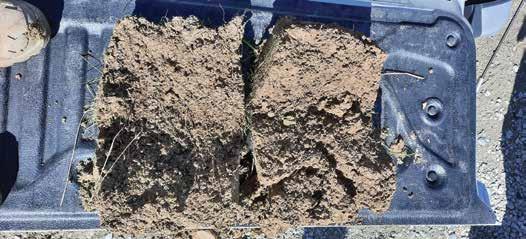
Macro-drainage combines two elements: 1) Letting water infiltrate into the lower soil profile, and 2) Moving water away from the lower soil profile.
If the upper soil profile is well structured but infiltration to the lower profile is hindered by a compacted layer, then ponding will occur.
Sub-soiling may alleviate the problem, but first the spade (or penetrometer) must be used to identify if there is, in fact, a compaction layer and, if so, at what depth.
Don’t be tempted to run the subsoiler too deep.
In some heavy soils this may make the problem worse by causing upward compaction if the ground is too wet.
Sub-soiling will only be effective if the sub-soil is porous (e.g., with gravel or sand).
If the upper soil profile is well structured and there is no compaction layer, but the sub-soil is not porous (e.g. clay), then sub-soiling will only ‘increase the size of the sponge’.
The result might be a short-term im-
Even if the upper soil profile is well structured, ponding can occur if infiltration to the lower profile is hindered by a compacted layer.

Feeding the world is a seemingly lofty ideal that’s closely linked to a very basic necessity.
For many countries, food security is a very serious concern, and food poverty a daily reality.
ADAMA NZ’s marketing manager Sarah Robertson says that the company provides the knowledge and products farmers and growers need to continue to work towards meeting these pressing needs.
It’s estimated that New Zealand farmers and growers alone feed 40 million global consumers a year, but they can’t do it without effective crop protection support, Sarah says.
“ADAMA’s commitment is ‘Listen, learn, deliver’. And our expertise and chemistry is among the best in the world.”
ADAMA is a member of the Syngenta Group, the world’s largest agricultural inputs company with over 55,000 employees across more than 100 countries.
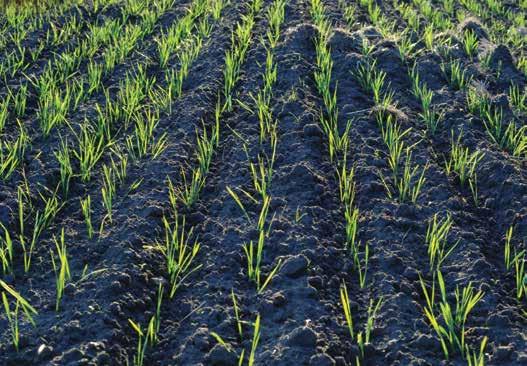
Sarah says, at a local level, the company focuses on needs region by region.
“On the ground in NZ, we are committed to meeting this country’s unique challenges, and also to the exciting emerging opportunities around new crops.
“Our one-of-a-kind portfolio of active ingredients gives us the flexibility to create solutions that meet local farmers’ and growers’ needs. We bring a lot to the table.
“ADAMA’s solutions to combatting weeds, insects and diseases contribute significantly to food security and the viability of crops.”
It’s much more than just a job, as Sarah explains.
She says stakes are high when lives along with livelihoods are on the line.
“We are passionate about agricul-
ture. Our straightforward, get-it-done attitude helps us stay focused on what we care about most; helping our customers create more sustainable, profitable businesses.”
Sarah says ADAMA proactively seeks opportunities to better understand customers, resellers and industry advisors.
“We take on board feedback and learn from their experience.”
Those insights are combined with ADAMA’s scientists’ expertise; with the company responding with new products, solutions, services, tailored commercial policies, and information and advice that is relevant to the market.
“Collaborating with distributors and their clients is fundamental to our work. Our team possesses an extensive knowledge of chemistry, which makes discussing our products effortless.
provement in the amount of water the soil will absorb but it will still become waterlogged with high rainfall events.
In this case you can move excess soil moisture away with macro-drainage, either sub-surface (mole drains, tile/pipe) or surface drainage.
Timing is crucial
Sub-soiling and mole ploughing should be done when the upper surface layers are dry enough to create cracks radiating out from the leg of the subsoiler or mole-plough.
Ideally, mole ploughing should also have damp sub-soil clay that then gets baked to a long-term mole channel in following dry conditions.
Late spring will normally provide
the best conditions for mole ploughing whereas there is more time flexibility with sub-soiling.
Speaking with long-term arable notill farmers where all paddocks have a history of no cultivation and have good soil structure, spring 2022 showed very clearly which fields had macro-drainage programmes done in the last decade or two.
These fields coped much better with the wet spring.
In their words, the difference was ‘chalk and cheese’.
Of course, the efficacy of sub-soil macro-drainage relies on micro-drainage (good soil structure) to work. Both must go hand-in-hand.
If our future weather patterns are go-
ing to be more variable, then managing our soils to retain moisture more effectively in dry conditions and remove it in wet conditions will have a major impact on the resilience of our farming systems.
Establishing arable or forage crops and new pasture with a dependable notillage system will have a big impact on soil structure and consequential resilience.
Novag no-till technology is sciencebased and farmer-proven to provide the adaptability and reliability needed to confidently manage a long-term no-till system.
It is an ideal tool for the ‘top-end’ of the drainage story but must be supported by good macro-drainage infrastructure to fully reap the rewards.
“However, finding the optimal solution may not always be a straightforward process. Therefore, we continuously seek opportunities to listen and stay informed to better serve our customers.”
ADAMA is a global company present in over 100 countries which provides NZ farmers and growers access to information and options, should a risk previously identified overseas make its way here.
“We’re well-networked with other ADAMA countries and continually looking at what’s happening elsewhere around the globe, to see what we can learn from others’ experiences.”
Sarah says, in the future, products and services will increasingly be influenced by issues beyond efficacy.
These include environmental sustainability, digital control of precision application, disease identification and crop monitoring.
“There’s also an increasing emphasis on a regenerative mind set - producing more sustainably.”
A recent example of enhanced environmental protection has been Injecta 400® and Di-Bak G®.
This combination tackles wilding
pines in a more targeted and efficient way, while reducing the chemical load on the environment.
Described as an ‘environmental disaster’, wilding pines have overwhelmed our landscapes, killing native bush and the native species living there, and creating fire hazards.
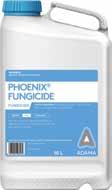
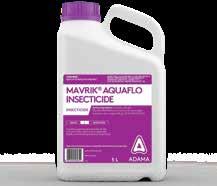
Sarah says the Injecta 400’s new technology directly inserts capsules containing glyphosate into the trunk, killing the tree from the inside.
Importantly, it also keeps the glyphosate contained. This prevents glyphosate leaking out - optimising efficacy and reducing waste and unintended consequences.
“With conventional ‘drill and fill’, the chemical can leak out and escape into waterways. Sealing the Di-Bak G capsules into the tree trunk makes the system suitable for even sensitive areas including those adjacent to riparian zones, pastures and parks.
“It is quick and clean. And in two to
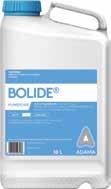
three months the tree will die.”
Another more sustainable example is the ‘softer’ chemistry of Mavrik® Aquaflo Insecticide (Mavrik), which ADAMA launched into the beet market in 2021.
Mavrik offers effective control of major beet pests Nysius and cutworm while having low toxicity to beneficial insects foraging in beets and surrounding crops.
Crucially, it is also safer for those using it, something Sarah says companies and growers are increasingly aware of.
“Standards and expectations are lifting all the time and our goal is to stay ahead of them. We want to be the gold standard in efficacy and safety.”
For more information contact your rural retailer.

C-D SERIES
KEY FEATURES:
- 3m - 6m wide, hydraulic folding to 3m transport width
- 5” or 6” row spacings
- Various bin options: fertiliser, small seed, and slug bait
- Proven Triple disc system with NO greasing!
- Option of touchscreen rate controller or Isobus integration through tractor terminal
- 2 point linkage tractor hitch
- Hydraulic accumulator downforce on folding wings
- Easy sowing depth adjustment: 2-3 adjusters total on machine
Tough Custom Air Seeder Drills That Maximise The Growth On Your Land
E-D SERIES
ERGONOMIC DRILL
Entry Level Triple Disc Drill that is suitable for both Farmers and Contractors
C-D SERIES
CONTOUR DRILL
Top pick Triple Disc Drill for Contractors and Large-Scale Operations
T-D SERIES
TYNE DRILL
Entry Level Tyne Direct Drill
P-D SERIES
PACKER DRILL
Min-till, Arable Drilling
H-D SERIES
HEAVY DUTY DRILL
Flat Ground, Heavy Duty Direct Drill

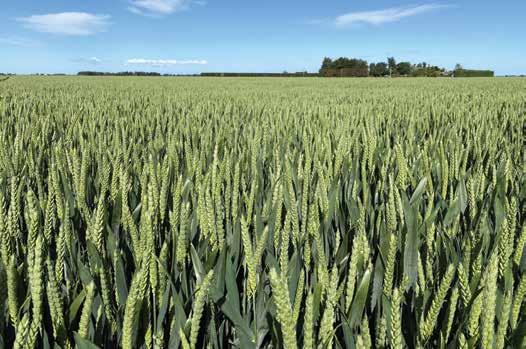
What a difference a year makes.
WORDS: NEIL WADDINGHAM, CUSTOMER MARKETING MANAGER, BAYER CROP SCIENCE
Last year commodity prices were riding high, and as this was enough to offset higher input prices, there was a feeling of optimism about the profitability of arable crops.
Now, as we approach spring it is a different story. Commodity prices are under pressure for several reasons and input prices continue to increase, albeit at a slower pace than last year.
But one thing that hasn’t changed is that yield is a very important driver for growing arable crops profitably and disease is one of the key factors leading to yield loss.
So, this spring while options are being considered to keep a lid on input costs, remember to think very carefully before reducing fungicide use.
Historically commodity prices are still high and not controlling disease effectively will lead to major financial losses.
Bayer trials carried out in the past few years have consistently shown applying a comprehensive fungicide programme has led to impressive yield increases and higher profits.
In wheat trials carried out by Bayer in recent years, yield increases have ranged from 2.0 t/ha to 9.0 t/ha.
While a yield increase of 9.0 t/ha per hectare is extreme, and doesn’t happen often, yield increases of 2-4 t/ha are commonplace in Bayer trials and these result in very profitable returns.
To achieve these types of responses in wheat Bayer would recommend applying a GS32, GS39 and GS65 fungicide programme based on the DMI fungicide Prosaro® and the SDHI fungicide VIMOY® iblon®.
Both provide every effective control of the three key wheat diseases, namely speckled leaf blotch, leaf rust and stripe rust.
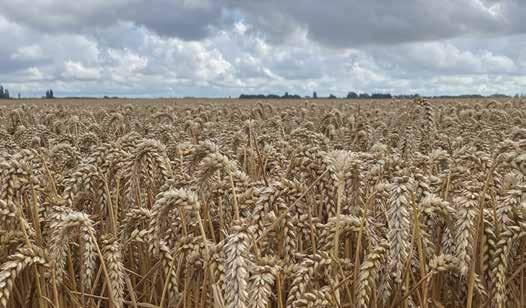
A robust fungicide programme is essential for effective disease control.
However, in recent years the key yield delivering applications in Bayer’s fungicide trials have been flag leaf emergence (GS39) and ear fully emerged (GS60-65).
Therefore, the recommendation is to apply Prosaro + VIMOY iblon at GS39 and to follow this with an application of Prosaro + strobilurin fungicide at GS6065.
Thinking about barley, in recent years the trend has been for growers to switch from growing autumn planted barley crops to late winter/spring planted barley crops to improve crop profitability.
But regardless of sowing date, disease control remains important and with either autumn or spring barley this can often be achieved with a two spray GS32 + GS39 fungicide application.
Bayer would recommend applying Delaro® + Folpet® at GS32 and then Prosaro + VIMOY iblon + Folpet at GS39. This programme will deliver broad spectrum disease control and will keep the plant healthy through the growing season.
Prosaro plays a very important role in effective disease control.
Containing both prothioconazole and tebuconazole, Prosaro is the only fungicide to offer ready formulated DMI stacking.
DMI stacking is a term that has been recently adopted to describe the application of two differently performing DMI fungicides at the same time, the aim being to deliver enhanced disease control and to delay the development of disease resistance to DMI fungicides.
While there are different types of DMI fungicides, DMI stacking is thought of in Europe and New Zealand to describe the mixing of two specific groups of DMI fungicides – the triazoles (e.g. tebuconazole) and triazolinthiones (e.g. prothioconazole).
By applying two DMI fungicides in mixture, prothioconazole (from the triazolinthiones group) plus one from the triazole group, both of which control the target fungus, you hit the fungus hard.
So, when making your choice of DMI fungicide, always consider Prosaro. Why settle for one DMI fungicide when you can have two?
For more details talk to your agronomist or visit www.cropscience.bayer. co.nz.
Due out August 2023 PRE ORDER NOW!

DON’T GET CAUGHT OUT - Make sure you are up-to-date!
• Over 140 new listings
• 160 deleted products
• 100 existing labels updated (new weed, pest & disease claims) Plus the latest regulatory amendments
The definitive guide to agrichemicals registered for use in New Zealand.
A comprehensive alphabetical listing of products, active ingredients, crop & weed tables, weed & pest identification and much, much more all in one single publication. It really is the definitive agrichemical guide and the only one you’ll ever need.
Purchase a manual to receive a FREE 12-month subscription to our subscriber only website.
The website is continually updated and contains product listings, a fully searchable online product manual, a powerful search engine of weeds, diseases & pests, including photo galleries with all the agrichemical options to use on individual crops as well as up-to-date SDS’s, Haznotes and product labels, plus posts about industry news and information.





ORDER NOW to receive your FREE pair of SureShield Coveralls

ORDER BY 31st October 2023 to go in the draw to WIN 1 OF 5 STS Shigematsu Respirators

SureShield Coveralls supplied by pH7, provides both protection and comfort with exceptional liquid and particulate protection. Ideal for a wide range of industrial applications. One size fits all. Shigematsu Respirators supplied by pH7.
* Available to those who order directly from www.novachem.co.nz - while stocks last.
Storing Chemicals?
Print up-to-date SDS’s & Haznotes from novachem.co.nz to ensure you are compliant.
A vibrant and profitable arable sector producing healthy, value added food, feed and seed
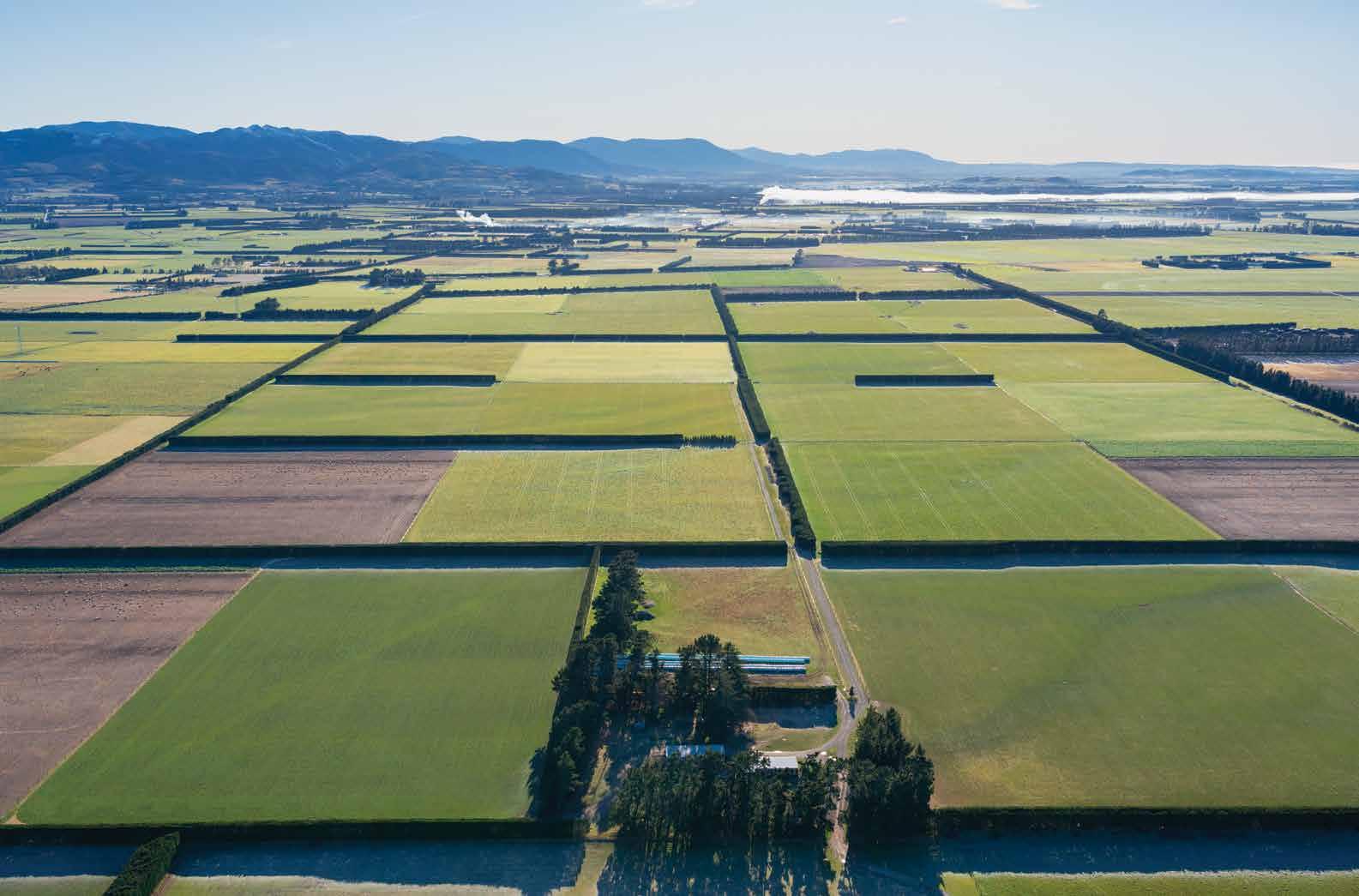
Adding value to the business of cropping
Supporting New Zealand’s arable farmers by creating new knowledge, tools and technologies to support responsible and profitable farming.
What’s worse than weeds like speedwell, stagger weed, doves foot and young field pansy making themselves at home in your cereal or grass seed crops?
Spraying the same weeds with the same crop protection molecule every time.
Change it up with different modes of action this season, and take confidence knowing not only will your crops perform better, but you’ve helped mitigate the risk of herbicide resistance on your farm.
That’s the advice from seasoned arable specialist Mike Cox, Nufarm, who says continued use of Group 12 herbicides in particular should be reviewed carefully.
“We need to start rotating our molecules for some of these tough weeds in cereal and grass seed crops. Diflufenican gives good control, which is why people use it, but it’s not the only option, and we know what can happen when we keep doing a few molecules to death…”
Cue Nufarm Image herbicide, the premium triple mix known for offering the highest possible standard of control where large populations of hard to kill weeds are present in wheat, barley, oats, ryecorn and triticale as
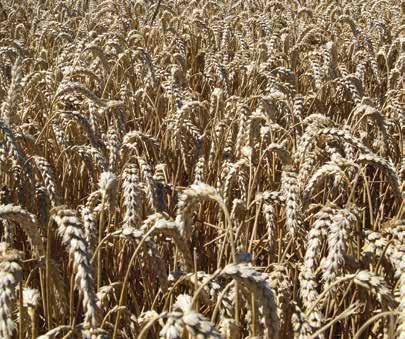
Keep yields up and hard to kill weeds down.
well as grass seed.
Comprising two actives from the Group 6 mode of action (bromoxynil and ioxynil) with one from Group 4 (mecoprop-p), Image brings a valuable rotation option to the programme for growers who have relied heavily on diflufenican, Mike says.
That’s on top of the other attributes which have made it a heavy hitter for more
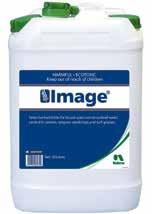
than 20 years.
Image is a mix of both contact and systemic herbicides.
“It has a massive weed spectrum,” Mike says, “including henbit, staggerweed, chamomiles, and all the fumitories. So that’s one thing that has always made it popular.”
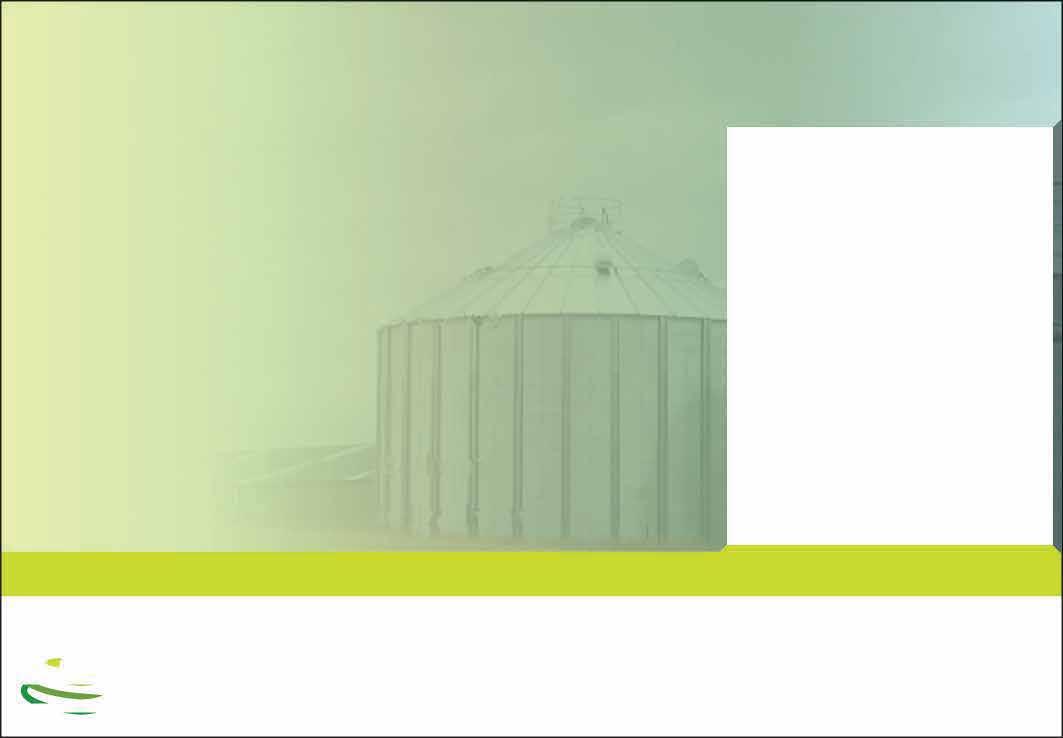

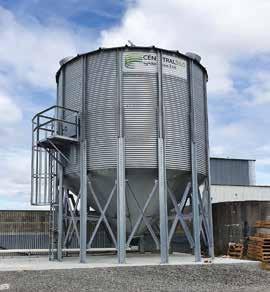
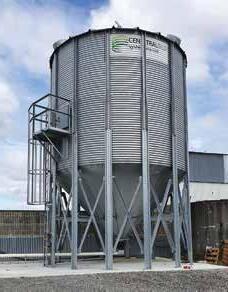
Ryegrass seed growers have welcomed use of Elatus Plus fungicide to control stem and crown rust in their crops after a label extension was approved in 2021.
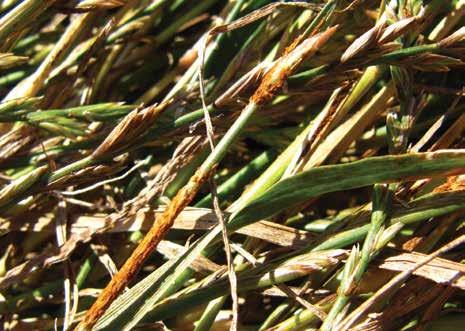
Syngenta says the registration was an important step for arable farmers, offering a powerful management tool for two key yield limiting diseases in ryegrass seed crops, with the added benefit of a short, 14-day withholding period.
Feedback on field performance has all been extremely positive, according to Paul Hassan, Syngenta technical services lead.
Every year Syngenta gives away up to 10,000 spray nozzles free to growers and contractors. While this might sound like a selfless gesture, in reality it is just good business.
Syngenta customer lead Raeleen Watherston says the company has worked with a nozzle supplier, Pentair/Hypro, to develop a range of nozzles that improve coverage, with less spray drift.
By supplying a set of 50 nozzles free to customers who purchase $10,000 worth of its products (herbicides, fungicides and insecticides), Syngenta helps ensure its products are used as effectively as possible.
“It is a win-win for growers and for us because it means they will get better results with Syngenta products and will hopefully keep using them.
“As far as I know we are the only company in New Zealand with such an offer to growers. It is a good deal for growers
Just as importantly, however, Image also has a relatively wide use window which ranges from GS12 to GS32, or from two to three leaves to the second node stage of the crop.
“That gives growers more flexibility at a busy time of the season, without compromising their results.”
Application results are typically visible within two weeks and control is achieved by four weeks depending on weed size, susceptibility and
growing conditions.
To get the best out of Nufarm Image, Mike says water rates and nozzle selection are important to ensure thorough, even coverage.
He advises applying Nufarm Image in 200-400 L water/ha, using the higher water rate after mid tillering and if weeds are dense.
The minimum spray pressure is 200kPA, and nozzles should deliver medium spray droplets; coarse nozzles and low pressure nozzles are
“Agronomists have indicated that the control of rust has been exceptional and represents a new standard in rust control in ryegrass crops. This backs up our own trial results.
“The short withholding period of 14
who can receive up to $1736 worth of nozzles free each year.”
Raeleen says the offer also gives the local Syngenta sales representative an opportunity to talk with individual growers and contractors to ensure they get the best nozzle type and size to suit their particular farming or contracting operation.
The two main nozzles Syngenta provides under this scheme are the Amistar AI (air induction) nozzle and the angled Defy 3D flat fan nozzle.
Both are designed to improve coverage and reduce spray drift, and both are made from SuperPoly, which has a similar wear pattern to ceramic.
For more information on the Syngenta product range and how to claim free nozzles, visit Syngenta.co.nz or call Syngenta on 0800 333 336 or your local Syngenta territory sales manager listed under field contacts.
not recommended.
Nufarm Image performs best when applied to weeds that are actively growing.
It should not be sprayed at the start of severe cold periods, especially from jointing in winter; and growers need to avoid applying Nufarm Image when large temperature variations are expected within three days of treatment.
As a rule:
• Apply Image when temperatures are > 5°
• Do not apply when temperatures are > 25°C
• Do not apply to drought stressed crops
• Apply on dry, cloudy days when humidity is > 70% and light intensity is low
• Light rain after foliage is dry should have no negative effect on efficacy.
For specific usage rates, refer to the label.
Talk to your agronomist or your local Nufarm territory manager for more information.
days has also proven very helpful for farmers in terms of grazing re-growth or feeding straw to livestock.
“After a number of years in development we are really pleased to offer this product to farmers.”
Elatus Plus provides powerful rust control by binding strongly to the leaf surface to give long-lasting, rainfast protection.
It also binds to the pathogen target site to inhibit fungal germination, shutting down a potential infection at a very early stage of disease development.
“The product is best applied at ear emergence and again at flowering in a preventative programme,” Hassan says.
“As a solo SDHI formulation, Elatus Plus provides growers the flexibility to add the best mixing partner, such as prothioconazole or Amistar.
“But it can also be applied as a solo treatment in a preventative programme in alternation with an approved noncross resistant fungicide.”
Another key benefit of Elatus Plus in ryegrass seed crops is endophyte safety.
“Long-term storage endophyte safety tests have been conducted. The results show it has a high level of safety for endophytes in ryegrass seed, so growers can

use it with confidence on sensitive novel endophyte varieties,” Hassan says.
In cultivars known to be sensitive to triazole fungicides, Elatus Plus can be applied alone in a preventative programme.
But it must always be mixed with a triazole fungicide in situations where a curative fungicide is needed.
Elatus Plus is a Group 7 SDHI fungicide containing 100 grams/litre of
benzovindiflupyr branded as Solatenol technology in an emulsifiable concentrate formulation.
It should be applied at 750 mL per hectare.
For resistance management do not apply more than two applications of Elatus Plus (or any other SDHI) to a ryegrass seed crop per season.
For more detail, contact your local Syngenta technical sales manager.
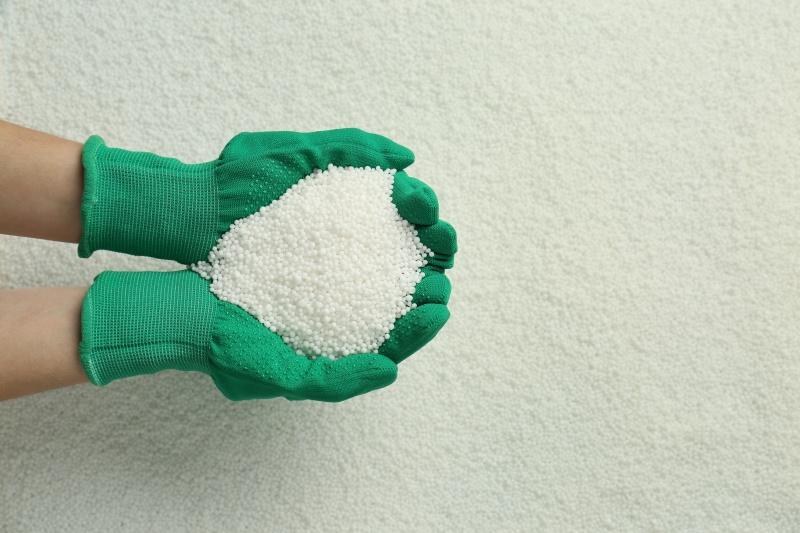
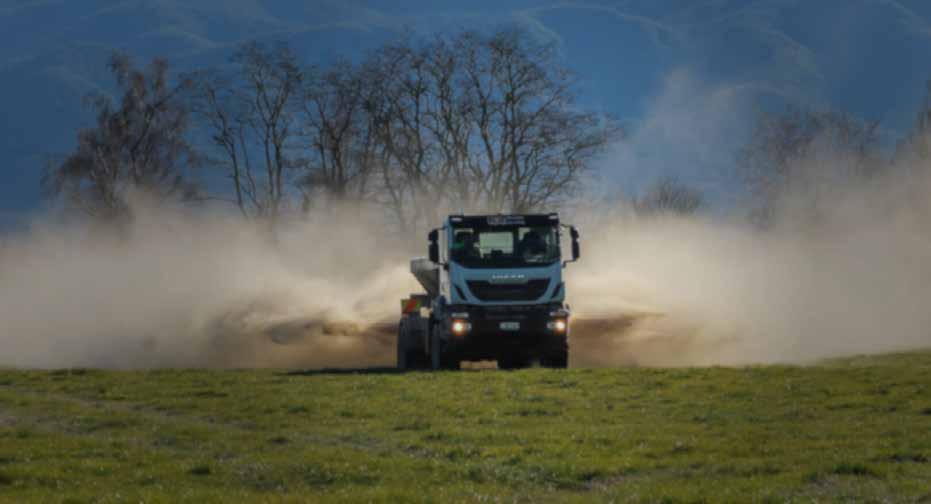
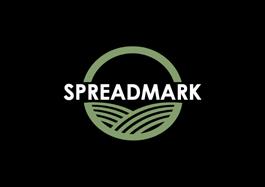
Grass weed control in cereals, ryegrass seed, pasture and turf has just got easier with the launch of a new product from Arxada, the company says.
Jive® is a fully formulated, adjuvant ready, selective post emergence grass weed herbicide based on fenoxaprop-P ethyl (Group 1).
The in-built adjuvant system utilises Arxada’s Oleo® formulation technology, meaning no further tank mix adjuvants or oil are required.
Jive is registered for use over autumn and spring sown barley, wheat, perennial ryegrass, pasture and turf, with extra weeds on the label.
Jive was developed by Arxada’s formulation and field science team, tested in-field to ensure it delivers robust grass weed control without compromising crop safety, and is manufactured at Arxada’s production facility in New Zealand.
“This new herbicide option gives growers the adjuvant ready solution that doesn’t require the addition of other oils or surfactant; is safe over perennial ryegrass and pastures, and has more registered weeds on the label to achieve a broader spectrum of control,” says Arxada technical services and development manager Stephen McKennie.
Jive contains 70.5 g/litre fenoxaprop-
P-ethyl, plus cloquintocet-mexyl safener, in the adjuvant ready Oleo formulation.
Other products containing this active state do not to mix with adjuvants on perennial ryegrass or pasture.
Jive, however, with its in-built adjuvant system, has proven to be safe in this cropping situation.
Wild oat and lesser canary grass (Phalaris minor) are significant weed challenges in cereals - they are well controlled using Jive.
Yellow bristle grass is also controlled by Jive, with the additional grass weeds registered on the label and controlled by Jive being barnyard grass, rough bristle grass and summer grass.
Jive is taken up by green stems and leaves and rapidly transported to the growing points in the shoots and roots, where it stops meristematic cell growth within one to two days, eliminating crop competition almost immediately.
This systemic movement is maximised when weeds are growing actively. Tolerant crops, as registered, rapidly metabolise the herbicide into harmless compounds.
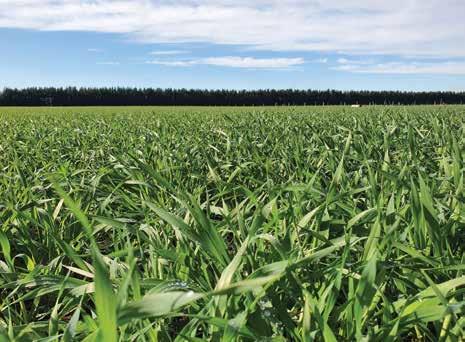

Jive is rapidly broken down by soil microbes, so has no residual effect and no restrictions on crop rotations.
Getting the best out of Jive
The Jive use rate is 750 ml/ha, in 250 litres of water, and this is rain fast in one hour.
Do not add any further surfactant or spraying oil.
Results are best under good growing conditions.
The best yield advantage will come from controlling weeds early.
For wild oats and lesser canary grass, apply from the third leaf stage.
Wild oats can be controlled up to the first node stage in barley and wheat, and through to the end of tillering in perennial ryegrass, with lesser canary grass control in barley and wheat through to the end of tillering.
For summer grass, barnyard grass and rough and yellow bristle grass, apply Jive to the seedling stage, before weeds have become reproductive.
For ryegrass turf, apply to established turf during spring and summer when conditions are warm and weeds are actively growing.
For best results, apply to the weed seedling stage before grass weeds have become reproductive.
Do not apply over seedling kikuyu or paspalum turf, as complete plant loss may occur. In established kikuyu and paspalum the crop will be severely suppressed.
For more information contact your rural retailer or agronomist.
A barley crop that has been treated with Jive to control wild oats.
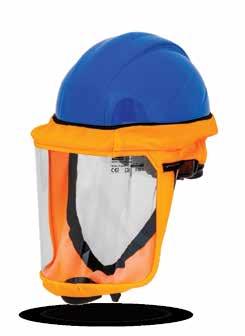







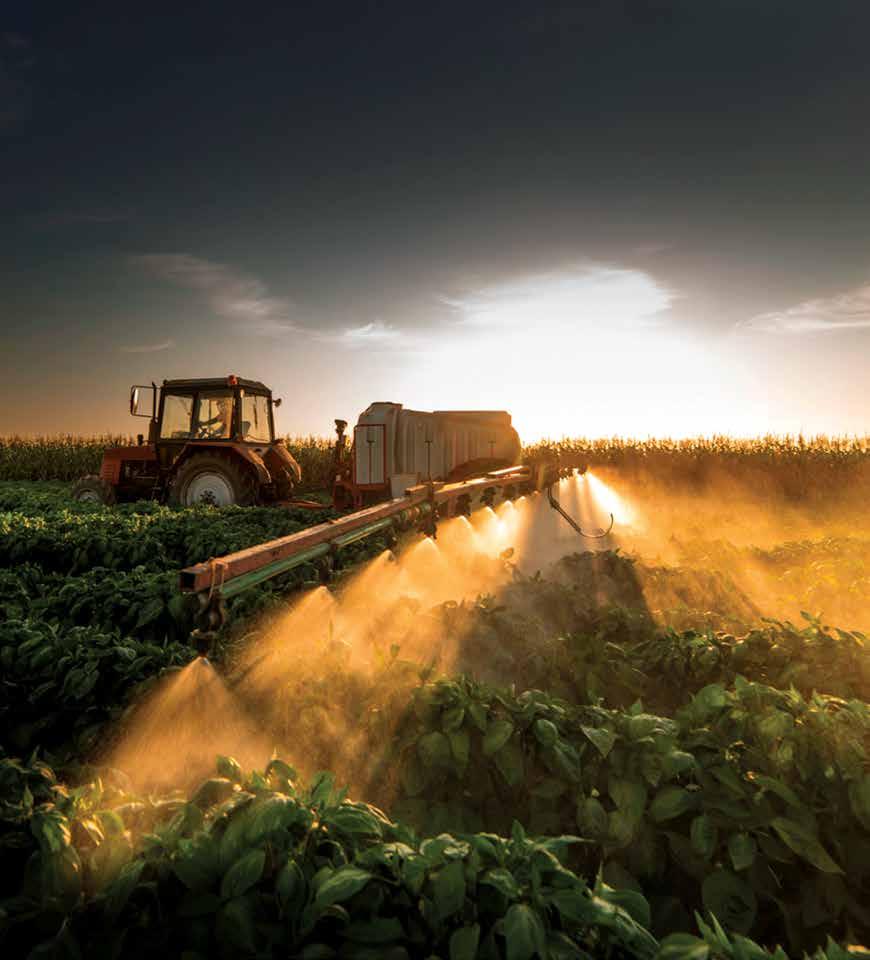
Certificate Who should do it?
Basic
Prerequisite:
None
Standard
Prerequisite:
Growsafe Basic (or equivalent knowledge) plus one season’s spraying
Growsafe recommends that all staff using agrichemicals attend a Growsafe Basic course and at least one person from each workplace hold a Growsafe Standard certificate.
• First time agrichemical users
• Those operating under supervision
• Agrichemical users working with little or no supervision
• Those with responsibility for a workplace where agrichemicals are used
• Those managing or supervising agrichemical users
Higher level specialist certificates:
Prerequisite: Growsafe Standard (or equivalent knowledge and experience)
Advanced Managers, team leaders and decision makers who are managing large scale or higher risk operations
RCA Spraying contractors who spray for hire or reward
Calibrator Those who calibrate agrichemical spray equipment for hire or reward
Supplier Rural retail staff with responsibility for bulk storage or selling agrichemicals
What does it cover?
Practical, task-related knowledge and skills with a focus on personal safety
Safe and responsible use of agrichemicals, risk management and an understanding of regulatory and market requirements
Can be used as evidence towards WorkSafe’s Certified Handler certificate (only required for products classed as Acute toxicity category 1 or 2)
Specialised knowledge to meet market and regulatory requirements in the specific roles
An alphabetical listing of companies supplying a wide range of products and services to New Zealand Arable growers and industry.
A4AG LTD
Manawatu (Head office), Waikato, Canterbury & Southland
Phone: 0800 424 100
Email: info@4ag.co.nz
www.4ag.co.nz
Products & Services: A comprehensive range of Cultivation, tillage & seeding equipment, including primary offset discs, grubbers, soil looseners, pre-rippers, rolling aerators, power-harrows, disc/ripper combinations, multi-discs, stubble cultivators, folding cambridge rollers, direct drills, roller-drills, air seeders, cultivation drills, strip-till units, precision planters, fert distribution systems, land levelers, Hardox Trailers for silage or rock work, mulching & topping mowers, cultivation wear parts. Specialist advice for the best machine to suit your requirements.
ACCIDENT COMPENSATION CORPORATION
PO Box 2521, Wellington 6140
Phone: 0800 222 776
www.acc.co.nz
ADAMA NEW ZEALAND LTD
Level 1, 93 Bolt Road, Tahunanui, Nelson PO Box 1799, Nelson 7040 Phone: 03 543 8275
Email: nzinfo@adama.com www.adama.com
Products & Services: Agriculture & horticulture crop protection chemistry.
ADRIA CROP PROTECTION
PO Box 535, Kumeu, Auckland 0841 Phone: 09 412 9817
Email: len@adria.nz www.adria.nz
Contact: Len Stulich
Products & Services: Marketers of a full range of agricultural & horticultural chemicals.
ADVANCE AGRICULTURE
14 Tamworth Lane, Gore
Phone: 03 203 9100
Fax: 03 208 8180
Email: janine@advanceag.co.nz
Contact: Janine Smith
Products & Services: Specialist suppliers of agrichemicals, seed, spray equipment, & precision ag, with free technical advice.
ADVANCED GPS AG LTD
187 Alford Forest Road, Allenton, Ashburton Phone: 027 455 2305
Email: sales@advancedgpsag.co.nz
Contact: Tony Houston
Products & Services: As NZ’s only authorised Topcon Agriculture distributor, we offer a full season of solutions to enhance efficiency
& productivity to your farming operation with GPS & Guidance Systems. From basic guidance to full auto-steer & RTK signal, we can supply control systems for sprayers, drills & spreaders including variable rate control.
42 Thames Street, Morrinsville
Phone: 07 889 7107
Email: steve@agparts.nz www.agparts.nz
Contact: Steve Elgar
Mobile: 021 070 7081
Products & Services: Late model tractor dismantler.
AGCO NZ LTD
840 Arthur Porter Drive, Hamilton PO Box 764, Waikato Mail Centre, Hamilton 3240
Phone: 07 974 1780
www.masseyferguson.co.nz www.fendt.com.au www.valtra.com
Contact: Josh Vroombout Mobile: 021 763 825
Products & Services: Through our nationwide network of locally owned dealerships, AGCO offers a complete range of agricultural machinery including tractors, hay, harvesting & materials handling equipment from world-renowned brands such as Massey Ferguson, Fendt & Valtra. High performing & quality machinery ideally suited to New Zealand farmers that are supported up by a professional & highly skilled dealer network.
111 The Terrace, Wellington PO Box 25642, Wellington 6140
Phone: 0800 247 326
Email: info@agrecovery.org.nz www.agrecovery.co.nz
Contact: Tony Wilson
Products & Services: Agrecovery is NZ’s solution for the disposal of unwanted agrichemicals, & the recycling of empty containers, drums, IBCs & small seed, feed & fertiliser bags. Supported by over 100 brands of agrichemicals, dairy hygiene & animal health products, the Agrecovery programme is available to all farmers & growers at over 160 sites nationwide. Our focus is on providing sustainable options for more farm plastics & achieving better environmental outcomes for rural communities.
AGRICOM NEW ZEALAND
PO Box 69168, Lincoln 7640
Phone: 0800 183 358
Email: info@agricom.co.nz www.agricom.co.nz
Contact: Mark Brown
Products & Services: Agricom researches, develops & markets a wide range of proprietary pasture & forage crop seeds to the agricultural industry.
487 Tancreds Road, Lincoln PO Box 69035, Lincoln 7640
Phone: 03 325 3311
Fax: 03 325 6117
Email: a.pullin@agrimm.co.nz www.agrimm.co.nz
Products & Services: Agrimm develops & manufactures biological plant protection products based on the beneficial fungus Trichoderma. Agrimm provides safe, environmentally sustainable plant health & protection products for vineyards, orchards, glass house & field crops. A range of ACVM registered & BioGro certified products available.
AGRIQUIP
30 Hurlstone Drive, New Plymouth PO Box 578, New Plymouth 4340
Phone: 06 759 8402
Email: sales@agriquip.co.nz www.agriquip.co.nz
Contact: Mark Hamilton
Products & Services: Spreadmaster fertiliser spreaders, firewood saw benches, woodsplitters, concrete mixers, chipper/ shredders, trenchers, transport trays, tractor mounted edgers, stump grinders, Bomford/ McConnel/spearhead hedgecutters, verge mowers, radio-controlled slope mowers, tuchel rotary sweepers, vacuum machines, Agriquip PTO driven generators. Spearhead Multicut rotary mowers, major mowers, Mulcher mower, Boom mowers, Hedge mulchers.
AGTEK NZ LTD
295 Jellicoe Street, Te Puke
Phone: 07 573 8132
Email: sales@agtek.co.nz
Contact: Gayne Carroll
Products & Services: McCormick & Landini tractors.
AITCHISON AGRI
36 Ratanui Street, Feilding PO Box 5056, Palmerston North 4441
Phone: 06 357 9323
Mobile: 021 433 129
Email: info@aitchisonagri.com www.aitchisonagri.com
Products & Services: Aitchison manufacture an extensive range of seed drills, fertiliser spreaders & accessories. The Grassfarmer, Seedmatic & Airpro seed drill models are available with the coulter disc & T-Boot tine openers or Concave Disc openers.
ALLEN CUSTOM DRILLS
13 Range Street, Ashburton PO Box 71, Ashburton 7740
Phone: 03 308 4094
Email: craig@allencustomdrills.co.nz
Facebook: www.facebook.com/ AllenCustomDrills
www.allencustomdrills.co.nz
Products & Services: Agricultural direct air seeder drill manufacturer & specialist.
ALPINE BUILDINGS NZ LTD
Phone: 0800 428 453
Email: sales@alpinebuildings.co.nz
www.alpinebuildings.co.nz
Products & Services: Birdproof & Clearspan kitset sheds & buildings nationwide.
ANALYTICAL RESEARCH LABORATORIES LTD
890 Waitangi Road, Napier
PO Box 989, Napier 4140
Phone: 0800 100 668
Phone: 06 835 9222
Fax: 06 835 9223
www.arllab.co.nz
Email: arl.lab@ravensdown.co.nz
Contact: Will Bodeker or Hendrik Venter
Products & Services: ARL provides a comprehensive range of soil, plant, feed, water & waste tests for the agriculture & horticulture industries. Our credentials in this area are demonstrated through accreditation by IANZ to the ISO 17025 standard & participation & creditable performance in a wide range of inter-laboratory comparative programmes. ARL offers a 10% discount to all Ravensdown Shareholders for soil, water, plant & feed analysis.
ANIMAL AND PLANT HEALTH ASSOCIATION OF NZ
PO Box 5069, Wellington 6140
Phone: 04 499 4225
www.aphanz.co.nz
Contact: Mark Ross - Chief Executive
Email: mark.ross@aphanz.co.nz
Products & Services: Representing NZ’s animal health & crop protection industries.
AQUALINC RESEARCH LTD
PO Box 20462, Christchurch 8543
Phone: 03 964 6521
Email: info@aqualinc.co.nz www.aqualinc.co.nz
Contact: Helen Elston
Products & Services: Irrigation management. Water resource consultants. Irrigation system evaluations. Soil moisture monitoring & telemetry systems.
ARABLE FOOD INDUSTRY COUNCIL
PO Box 23143, Hornby, Christchurch 8441
Phone: 03 349 8430
Contact: Thomas Chin
ARABLE INDUSTRY GROUP
Federated Farmers
PO Box 20448, Bishopdale, Christchurch 8543
Phone: 0800 327 646
Email: 0800@fedfarm.org.nz
ARXADA NZ LTD
76 Gill Street, New Plymouth
PO Box 8110, New Plymouth 4340
Phone: 06 755 9234
Fax: 06 755 1174
Email: office-newplymouth@arxada.com www.arxada.co.nz
Products & Services: Research, development & manufacture of agrichemical products & the distribution of Headland foliar fertilisers, for the agricultural & horticultural industries including:
Herbicides: ARXADA Activated Amitrole, Beetrix, Bruno, Dynamo, Expo 500, Headstart, Ignite, Jazz, Jive, Millennium, Neeko Oleo, Ombre, Oxy 500 SC, Polka, Prominent, Pycus, Quantum, Saxon, Spark, Stratos, TAG G2, Taipan CS, Terb 500, Twister, Victory Gold, Vixen, Yield.
Fungicides: AG Copp 75, Apex, Barrachlor 720, Cannon, Cobra, Companion Gold, CuSol, Dodine, Esteem, Foschek, Mondo, Neptune, Nexus, Pinnacle, Protek, Speartek, Taratek 5F, Topsin M-4A.
Insecticides: Alpasso, Axcela, Cyhella, Mortar, Pylon, Sniper
Additives: Burnout, Oasis, Squall. Plant Growth Regulators: Advance Gold, Foliar fertilisers: (Headland) Boron150, CaNite, Emperor, Jett, KSolve, MagSuper80, Mo-Bo, Molybdenum 250, Multiple Pro, SeaMaxx, Vanir, Zinc150.
Trading as Asia Pacific Seeds
PO Box 16758, Christchurch 8441
Phone: 03 325 6168
Email: office@asiapacificnz.co.nz
Contact: Nic Tiffen
Mobile: 0274 325 616
ASUREQUALITY LTD
- LINCOLN
PO Box 85006, Lincoln University, Lincoln 7647
Phone: 021 983 552
Fax: 03 325 7088
Contact: Rouke Bakker
Email: rouke.bakker@asurequality.com
Products & Services: A comprehensive range of plant disease diagnostic services including seed health testing, potato virus testing & seed endophyte testing, plant export verification services, seed varietal certification services, plant health surveys, organisation audits & inspections.
ASUREQUALITY LTD
– PALMERSTON NORTH
PO Box 609, Palmerston North 4440
Phone: 06 351 7941
Email: seedlab@asurequality.com
Contact: Andrew Ward
Products & Services: A comprehensive range of seed testing & diagnostic services.
PO Box 9573, Hamilton 3240
Phone: 0800 557 733
Phone: 07 847 5315
Fax: 07 847 5316
Email: sales@aurora-process.com
www.aurora-process.com
Contact: Mike Goddin
Products & Services: Bag & sack filling & closing – sales & servicing. Portable machines – industrial machines. Thread supplies. Palletizing systems – robotic or conventional options for bag/box/crate/carton. Bagging systems - valve & open mouth bag filling, closing & handling.
AUSTINS
131 King St, Timaru
Phone: 03 688 8963
AH: 03 688 3940 or 027 273 3975
Fax: 03 688 3942
Email: austinsfoundry@xtra.co.nz
www.austinsfoundry.co.nz
Contact: Ken Austin
Products & Services: Cambridge rollers & roller drills from 2.5 to 9m.
89 Hautapu Road, Cambridge PO Box 5272, Hamilton 3242
Phone: 0800 833 538
Email: orders@bapsnz.com
www.bapumpsandsprayers.co.nz
Contact: Paul France
Products & Services: BA Pumps & Sprayers (formerly Bertolini Australasia) are a local manufacturer of a full range of specialist linkage, trailed & deck mounted sprayers for the agriculture, horticulture & viticulture industries. NZ distributor of Bertolini pumps, TeeJet agricultural spraying accessories, TeeJet Midtech GPS guidance systems, Arag componentry & Shurflo pumps. All BA Pumps & Sprayers products are available nationwide through our specialist dealer network.
Private Bag 12503, Tauranga Mail Centre, Tauranga 3143
Phone: 0800 222 090
Email: CustomerServices-Mount@ballance. co.nz
www.ballance.co.nz
Products & Services: Ballance Agri-Nutrients is a NZ farmer owned co-operative that helps customers farm more productively, profitably & sustainably. From our core business of fertiliser manufacturing, supply & advice, we have grown to offer a full range of sciencebacked nutrient products & services. This enables us to help farmers & growers achieve soil nutrition, animal nutrition & productivity with a minimal environmental footprint. Our agri-nutrient advice is complemented by award-winning web-based farm systems software, which enables farmers to explore a wealth of information & make the best management decisions for their business. Key arable products include SustaiN, YaraMila Complex, YaraMila 8-11-20, YaraMila Actyva S & the Cropzeal range.
2547 Old West Coast Road, RD1, Christchurch Phone: 03 318 8514
Fax: 03 318 8549
Contact: Jake Gardner
Email: jgardner@barenbrug.co.nz
Products & Services: Proprietary forage breeding, sales & marketing, domestically & export. 4front, Array, Maxsyn, Trojan, Rohan, Governor & Tyson perennial ryegrass. Shogun & Forge hybrid ryegrass, Tabu Plus Italian ryegrass, Hogan annual ryegrass. Bareno pasture brome, Redefine cocksfoot. Apex, Ruru & Kotuku white clover. Morrow red clover, 501 chicory, Hattrick forage oat, Dynamo turnip, Interval forage rape, Caledonian & Bombardier kale & Invitation swede. Robbos & Blizzard fodder beet. Captain plantain. Zulu II annual clover, Laser Persian clover, Agricote seed treatment, NEA12, NEA2, NEA4, NEA & AR37 endophytes.
Shed 5E City Works Depot, 77 Cook Street, Auckland Phone: 09 255 4300
Contact: Fenton Hazelwood, National Commercial Manager – Agricultural Solutions / BASF NZ Country Manager
Phone: 09 255 4331 Mobile: 021 744 028
Email: fenton.hazelwood@basf.com www.crop-solutions.basf.co.nz
Products & Services: Global agricultural chemical company, investing heavily in R&D, marketing & distributing crop protection products in NZ, including: Fungicides: Belanty, Colliss, Comet, Delan, Kinto Duo, Kumulus DF, Imtrex, Opus, Polyram DF, Pristine, Revylution, Revystar, Sercadis, Systiva, Vivando, Zampro.
Herbicides: Basagran, Buster, Frontier-P, Pulsar, Sharpen, Stomp Xtra.
Insecticides: Fendona, Ripcord, Ripcord Xtra, Termidor 100SC.
Other: Cycocel, Poncho, Selontra, Storm Secure, Systiva, Terpal, Regalis Xtra.
B:HIVE Building, 74 Taharoto Road, Takapuna, Auckland Phone: 021 755 326
Contact: Neil Waddingham Products & Services: Suppliers of crop protection products, including: Herbicides: Betanal Forte, Betanal quattro, Firebird, Hussar, Nortron, Othello, Puma S, Sencor & Sakura.
Fungicides: CALEY iblon, VIMOY iblon, Aviator Xpro, Delaro, Folicur, Proline, Prosaro. Insecticides – Confidor, Movento OD, Proteus & Velum Prime.
Seed Treatment arable: Gaucho, Raxil Star.
BIO-START LTD
Suite 4
33A Anzac Street, Takapuna 0622
Phone: 0800 274 524
www.biostart.co.nz
Email: info@biostart.co.nz
Products & Services: A leading manufacturer of biological products for use in the agricultural & horticultural industries. NZ owned & operated & has been developing products specifically for NZ farmers & growers over the past 29 years. Products include forage preservatives (SilageKing, HayKing & MaizeKing), soil biostimulants (Mycorrcin, Digester & ThatchBusta), the BioStart N biofertilizer & a range of crop protection products (TripleX & Karbyon).
BLAIRS SUPERTYRE DISTRIBUTORS LTD
PO Box 14, Geraldine 7956
Phone: 0800 80 90 96
Phone: 03 693 8122
Email: blairs@blairs.co.nz
www.blairs.co.nz
Contact: Warren Blair
Products & Services: Tyres – Brands include Trelleborg, Tianli,, Kumho, Petlas, Goodride.
BRANDT RENTAL AND LEASING LTD
1318 Omahu Road, Hastings PO Box 2098, Hastings 4156
Phone: 06 879 9907
Fax: 06 879 9902
Contact: Bill Barker
Mobile: 027 458 7461
Products & Services: Tractor rental & leasing. Casual hire, charged by the hour. Long term leasing charged by the month.
BRIDGESTONE NEW ZEALAND LTD
PO Box 91440, Victoria Street West, Auckland 1142
Phone: 0800 802 080
Phone: 09 573 5700
Contact: Willem Krige
Email: Willem.Krige@bridgestone.co.nz
Products & Services: Bridgestone & Firestone agricultural tyres & related services.
BROWNRIGG AGRI GEAR LTD
768 Pirongia Rd, Te Awamutu
Phone: 021 942 125
Email: gavinbrownrigg@hotmail.com
Contact: Gavin Brownrigg www.brownriggagrigear.co.nz
Products & Services: NZ distributor for Slurrykat, Donnelly Trailers & SLS trailers.
60-62 Cass Street, Ashburton PO Box 19, Ashburton 7740
Phone: 03 307 6979
Fax: 03 307 6960
Email: grainandseed@carrfields.co.nz
Contact: Ryan McLaren
Products & Services: Producers & exporters of grain, seeds & pulses. Specialist producer of vining/garden pea seed & multipliers of overseas cultivars & vegetable seeds for re-export. Procurement, marketing & sales of feed & milling cereals as well as cereal seed suppliers.
73 Remuera Road, Newmarket, Auckland PO Box 99873, Newmarket, Auckland 1149
Phone: 0800 227 876
Email: orders@castrol.co.nz www.castrol.com/en_nz
Products & Services: Agricultural lubricants, industrial lubricants.
2 Kermode Street, Ashburton PO Box 337, Ashburton 7740
Phone: 03 308 7166
Fax: 03 308 9398
Email: info@cates.co.nz www.cates.co.nz
Contact: Stuart Begg
Products & Services: Grain, seed & agrichemical merchants including small seeds, cereals, brassica & pulses for both domestic & international markets.
C-DAX LTD
PO Box 1010, Palmerston North 4440
Phone: 0800 230 230
Email: sales@c-dax.co.nz
www.c-dax.co.nz
Products & Services: Experience outstanding C-Dax customer service for all spraying, spreading & pasture measure requirements. C-Dax products are renowned
for unique design, innovation, technology & uncompromising quality. Manufacturing a wide range of products to suit every farming application, C-Dax products are designed & backed by people who understand your farming needs.
CENTRAL GRAIN & PRODUCE SOUTHLAND LTD
Dunearn, RD 3, Winton Phone: 03 236 1040
Email: central.grain@xtra.co.nz
Contact: Robert Saunders
Products & Services: Grain, seed & produce merchants.
CLARKES SEED & FEED LTD
55 Annan Street, Invercargill Phone: 0800 621 431
Phone: 03 214 3104
Email: office@clarkes.net.nz www.clarkes.net.nz
Contact: Garry Clarke Mobile: 027 453 4066
Products & Services: On farm dressing & treating, seed supplies & screening, pasture mixtures, brassica seeds, stock feed manufacturers, all dairy & calf feeds.
COCKSFOOT GROWERS ASSOCIATION
PO Box 16574, Hornby, Christchurch 8441
Phone: 03 347 7950
Contact: Brent Stirling (Cropmark Seeds Ltd)
Products & Services: Growers of Cocksfoot. Marketer – seeds.
CONTINENTAL FARM TYRES
PO Box 1590, Invercargill 9840
Phone: 0800 275 897
Email: info@continentalfarmtyres.co.nz www.continentalfarmtyres.co.nz
CORSON GRAIN LTD
PO Box 1046, Gisborne 4010
Phone: 0800 CORSON (0800 267 766)
Email: info@corson.co.nz www.corson.co.nz
Products & Services: Food grade maize millers, maize grain merchants & hominy meal.
CORSON MAIZE
PO Box 69132, Lincoln 7640
Phone: 0800 4 MAIZE (0800 462 493) www.corsonmaize.co.nz
Contact: Graeme Austin - National Sales Manager
Phone: 027 433 0161
Products & Services: Suppliers of premium maize hybrid seed.
CORTEVA AGRISCIENCE
Private Bag 2017, New Plymouth 4320 Phone: 0800 803 939
Email: NZCustomerService@Corteva.com
Products & Services: Manufacturers of agricultural crop protection chemical: Herbicides: Milestone, Rexade GoDri, Paradigm, Tordon PastureBoss, Tordon Brushkiller XT, Tordon 2G Gold, Gallant Ultra, Kerb 500F, Versatill Powerflo, Starane Xtra, Preside, Radiate, T-MAX, Vigilant II.
Insecticides: Transform, Prodigy, Sparta, Entrust SC Naturalyte, Uphold.
Fungicides: Questar, Acanto, Kocide OPTI, Zorvec Enicade, Fontelis, Talendo. Surfactants: Uptake Spraying oil.
Railway Terrace, Doyleston, Canterbury
PO Box 3, Doyleston, Canterbury 7548
Ph/Fax: 03 324 3951
Email: cridgeseeds@xtra.co.nz
www.cridgeseeds.co.nz
Contact: Nick Reid
Mobile: 022 083 3579
Products & Services: Wholesalers & retailers of top-quality ryegrass & clovers (including annual clover). Mixes to suit all pasture requirements. Cleaning specialists.
1422 Omahu Road, Hastings
Phone: 0800 106 898
Fax: 0800 117 711
Contacts:
Rob Marshall – NZ Regional Manager / South Island
Vic Barlow - Lower North Island and Gisborne
Ashley Robinson - Upper North Island and Taranaki
Products & Services: Manufacturer & importers of all types of agricultural & horticultural spraying equipment. Stockists of leading brands of components & parts, including spray controllers, pumps, tanks, Raven GPS technology, nozzles, fittings & selfpropelled sprayers.
CROPMARK SEEDS LTD
PO Box 16 574, Christchurch 8441
Phone: 0800 4 CROPMARK (0800 427 676)
Phone: 03 347 7950
Fax: 03 347 7951
www.cropmark.co.nz
Contact: Callum Davidson
Products & Services: The breeding, marketing & sale of a range of forage grasses, clovers & brassicas into global markets; forage endophyte research & development; specialist crop seed multiplication & nursery work.
DDARFIELD SEED CLEANING CO LTD
87 Horndon St, Darfield
Phone: 03 318 8595
Email: darfieldseed@xtra.co.nz
Contact: Troy Collings
Products & Services: Seed cleaning & seed treating.
DE SANGOSSE NEW ZEALAND LTD
PO Box 113, Te Awamutu 3800
Phone: 07 827 4856
Fax: 07 827 4806
Email: infonz@desangosse.com
www.desangosse.co.nz
Contact: Lynn McQueen
Products & Services: Plant Nutrition
Specialists.
Starter fertiliser: Microstar PZ. Foliar nutrition: Brassimax, Fixa B, Boronia Mo, Thiomax C, Fixa Mn, Moly (Mo), Pancal. Plant stress management products, frost
prevention & mitigation: Fertigofol Ultra; Organic Inputs: Actigreen, Borozinc, Mg85S, Amylis.
Utility products: Tanksafe spray equipment cleaner/decontaminant, Foamfix prevention & elimination of foaming.
PO Box 1075, Christchurch 8140
Phone: 03 338 6509
Email: Sales@donaghyscrop.co.nz
Contact: Customer Service
Products & Services: Bale wrap, Balenet, silage covers, bale twine, silage tubes & bags plus horticultural twines. Let us know if you have any crop packaging requirements & our nationwide team will assist you.
239 Alford Forest Road, Allenton, Ashburton
Phone: 03 307 7445
Email: info@euroagri.co.nz
www.euroagri.co.nz
Contact: James McCloy, Eliot Schofield, Mark Smitheram
Products & Services: Exclusive NZ importers & service agents for Househam sprayers, Bredal spreaders, HEVA cultivation & drilling equipment, Mzuri striptillage, Billericay spray nozzles & Agreto agricultural electronics. In addition, we are the dealers & service agents for Lemken cultivation & drilling equipment, McConnel, & Ag Leader precision farming technology.
Foundation for Arable Research
PO Box 23133, Hornby, Christchurch 8441
Phone: 03 345 5783
Email: far@far.org.nz
www.far.org.nz
Contact: Alison Stewart
Products & Services: Responsible for the investment of grower levy funds & other grants & industry investments for research & information transfer to provide benefits to NZ arable growers.
PO Box 23133, Hornby, Christchurch 8441
Phone: 03 345 5783
Email: far@far.org.nz
www.productionwise.co.nz
Contact: Melanie Bates - Manager
Products & Services: ProductionWise is an integrated online farm management system that allows you to map paddocks, record management practices, complete environmental reporting including integrating to OverseerFM, plus traceability reporting & gross margins. It has been developed by FAR for use in NZ & is freely available to FAR levy payers.
Invercargill Branch:
51 North Road, Invercargill PO Box 619, Invercargill 9840
Phone: 03 215 7750
Email: ben@farmchief.co.nz
Contact: Ben Abernethy
Gore – Depot: 231 Main Street, Gore
Phone: 0800 327 624
Christchurch Branch: 10 Curraghs Road, Christchurch PO Box 16069, Hornby, Christchurch 8441
Phone: 03 349 4450
Email: todd@farmchief.co.nz
Contact: Todd Murray
Palmerston North Branch: 6 Noel Rogers Place, Palmerston North Phone: 06 354 6404
Email: matt@farmchief.co.nz
Contact: Matt McKillop
Waikato Branch: Phone: 0800 327 624
Email: alano@farmchief.co.nz
Contact: Alan Ogden
21 Andrew Baxter Drive, Airport Oaks, Auckland PO Box 107110, Auckland Airport, Auckland 2150
Phone: 09 275 5555
Fax: 09 256 2220
Email: sales@farmgard.co.nz www.farmgard.co.nz
Contact: Scott Capper
Products & Services: Celli rotary hoes, power harrows, spikes rotors & spaders. Berti stubble mulchers, gorse mulchers, forestry mulchers, digger mounted mulchers, orchard mulchers/ mowers, park mowers & toppers. Farmgard grader blades & pre rippers. Stanhay precision planters. RZ RANGE Discs, multi discs, rippers, rollers, cultivators, Min Till equipment. Overum ploughs. ABBEY muck spreaders, slurry tankers, Grainstor grain storage equipment.
FARMLANDS CO-OPERATIVE
First Floor, 76 Cumberland Street, Dunedin PO Box 607, Dunedin 9054
Phone: 0800 666 626
Fax: 0800 666 625
Email: fuelaccountmanagement@farmlands. co.nz
Products & Services: Supplier of bulk fuel to rural & commercial customers, Fuel Card, Gulf Lubricants & bulk fuel storage systems & accessories.
FERN ENERGY LTD
Level 3, 10 Show Place Addington Christchurch
Phone: 0800 99 99 89
Email: enquiries@fernenergy.co.nz
Products & Services: Bulk Fuel & Lubricant Specialists
FMC NEW ZEALAND LTD
PO Box 64199, Botany, Auckland 2163
Phone: 0800 658 080
Contact: Sandra Read
Products & Services: Marketers of agrichemical products, including: Herbicide: Authority, Glean, Granstar, Foxtrot, Hammer Force, Harmony, Magister, Shark Insecticide: Altacor, Avaunt, Benevia, Coragen, Exirel, Fyfanon, Steward eVo, Talstar, Tripsol Fungicide: Octave, Rovral Aquaflo, Sportak
FMG
Farmers Mutual Group
FMG House, 284-292 Church Street, Palmerston North
PO Box 1943, Palmerston North 4410
Phone: 0800 366 466
Fax: 0800 366 455
Email: contact@fmg.co.nz
Products & Services: FMG is NZ’s leading rural advice & insurance specialist. 100% Kiwi owned & operated. They offer a range of Life & Health, property, liability, vehicle & crop cover options for arable farmers. Seasonal cover, including fire only cover is available for a variety of crops - maize, barley, wheat, fodder crops, seed crops & vegetables - as well as top-up cover for the United Wheat Growers Scheme.
FONTERRA FARM SOURCE
Level 1, 19 Home Straight, Te Rapa, Hamilton PO Box 9045, Hamilton 3240
Phone: 0800 731 266
Fax: 0800 731 329
www.nzfarmsource.co.nz/store
Email: nzfss.customerservice@fonterra.com
FRASER GRAIN & SEED LTD
PO Box 220, Rangiora
Ph/Fax: 03 313 8093
Mobile: 0274 329 273
Contact: Alan Fraser
Email: fraser05@xtra.co.nz
Products & Services: Grain & Seed Merchant. Agricultural Chemicals.
FUELCHIEF LTD
PO Box 160175 Hornby, Christchurch 8441
185 Kirk Rd, Templeton, Christchurch
Phone: 03 384 2380
Email: rowan.smithers@fuelchieftanks.com
Products & Services: Manufacturers of FUELCHIEF & SEBCO diesel stations, oil recovery units & blue stations for adblue.
GGENETIC TECHNOLOGIES LTD
PO Box 105303, Auckland City, Auckland 1143
Phone: 0800 PIONEER (0800 746 633)
Phone: 09 307 0000
www.pioneer.co.nz
Contact: marketing@genetic.co.nz
Products & Services: NZ producers & distributors of Pioneer brand seeds & related forage products. Maize: Hybrid maize for grain & silage. Forage: Lucerne, hybrid forage sorghum, microbial silage inoculants & inoculant application systems. Agronomy, animal nutrition & farm systems management; seed treatment; maize planter calibration.
GILTRAP AG
100 Hilton Highway, Washdyke, Timaru
Phone: 03 688 2029
Email: info@giltrapag.co.nz
www.giltrapag.com
Contact: Matt Moodie
Mobile: 021 880 114
Products & Services: Manufacturers, exporters & distributors of Duncan seed drills.
2003 Coaltrack Road, Greendale, RD 1, Christchurch
Phone: 03 318 8132
Email: jo@goughagritech.co.nz
www.goughagritech.co.nz
Contact: Doug Gough
Mobile: 027 480 2604
Products & Services: Importers & distributors of: Flach & LeRoy Crop Drying & Ventilation Equipment for grain & seeds, onions, potatoes, bulbs. Drive on ventilated timber flooring, fans, heaters, consultation & design.
Brandt Agricultural Products Ltd: Swing away Augers, Conventional Augers, Grain Vacs, Grain Belt Conveyors, Heavy Harrows. Twister Silos. “Never Spill Spout” auger-mounted full silo alarm. Cestari Grain Carts/Chaser bins. Grain Air Tubes. Richiger Grain Bagging equipment: grain bag loaders, grain bag unloaders, grain bags.
PO Box 16228, Bethlehem, Tauranga 3147
Phone: 0800 Trimble (0800 874 625)
Email: gpscsl@icloud.com
Contact: John Ahearn
Products & Services: RTK Correction SignalWe operate a GNSS reference station network that broadcasts RTK correction signals to the farming regions in NZ. Customers pay a yearly subscription for access to the signal & this also includes free technical support. The RTK correction signal can be used by Trimble, Topcon & Leica GPS systems, John Deere, Fendt, Massey, CAT, Claas, New Holland & Case factory installed RTK systems.
GRAINSTOR LTD
Complex: 1 Elginshire St, Timaru
PO Box 2067, Washdyke, Timaru 7941
Phone: 03 688 2035
Office: 79 Elginshire Street, Timaru
Phone: 03 688 2800
Fax: 03 688 2036
Email: lee@grainstor.co.nz
Contact: Lee Brown
Mobile: 027 251 0291
Products & Services: Grain storage & consolidators.
20 Watson Street, Ashburton
Phone: 03 308 8335
Email: info@engsolutions.co.nz
Contact: Luke Maginness & Hayden Bonnington www.engsolutions.co.nz
Products & Services: Grain augers, heavy water ballast rollers, spiral welded steel pipe, general engineering & machining.
Level 4, 214 Collingwood Street, Hamilton Phone: 0800 245 463 www.graymont.com
Contact: Kylie Owen (kowen@graymont.com)
Products & Services: Quicklime, Aerolime, Hydrated lime, Aggregates, Calcimate, Agricultural lime & Landscape Chip.
23B Manuka Street, Palmerston North Phone: 06 354 1030
Products & Services: Rapid Plus, spray adjuvant will enhance the effectiveness of
certain herbicides, insecticides & defoliants. Si-Lac silage inoculants. Pro-mark Foam Marker, heavy duty foam blob marker pink & white. ON-Target, water modifier to reduce droplet bounce & drift for better chemical deposition & retention. Pro-Max, an Advanced high specification spray adjuvant especially designed for use in hard water. Pro-Kleen Granular, an all-in-one pesticide decontaminant. Pro-Dye Red, a non-toxic vegetable-based marker dye.
69 Kawakawa Road, Feilding PO Box 321, Feilding 4740 Phone: 06 323 5091
Email: info@hnt.co.nz
Contact: Maria Walters www.hnt.co.nz
Products & Services: Retail & wholesale pastoral & arable seed, crop protection & seed applied technologies. Nationwide agronomy team providing crop planning, management & inputs. Research, development & distribution of seed applied technologies to New Zealand & overseas markets.
Contact: Ross Dickson – NZ Territory Manager
Phone: 027 672 7727
Email: ross.dickson@hardi.com www.hardi.net.nz
Products & Services: All sprayer parts & services. We have a sprayer to suit any market or application you need. Self-propelled sprayers, Trailer sprayers, Linkages sprayers, Engine drive sprayers, 12volt & hand sprayers, Trailer mistblowers, Linkage mistblowers.
HARRAWAY & SONS LTD
165 Main South Road, Green Island, Dunedin PO Box 13040, Green Island, Dunedin 9052
Phone: 03 488 3073
Email: info@harraways.co.nz
Contact: Henry Hawkins - CEO www.harraways.co.nz
Products & Services: Finest quality, NZ grown & milled oat breakfast cereal products.
HARVESTER MARKETS LTD
Phone: 03 318 3775
Contact: Fred Bull Mobile: 021 346 955
Products & Services: Winding down. Parts still available. Belts, Fingers & Knives.
HEINZ WATTIE’S LTD
PO Box 439, Hastings 4156
Phone: 0800 653 050
Fax: 0800 151 675
Products & Services: Processors & marketers of frozen & dehydrated peas, carrots, beans, corn & potatoes.
211 Mt Thomas Road, RD 1, Rangiora
Phone: 03 313 5278
Contact: Andrew Hide
Mobile: 0274 372 006
Products & Services: All boom & gun spraying - weeds, crops, industrial, gorse & broom etc. Self-propelled sprayers. Liquid & solid fertilisers.
28 Duke Street, Hamilton Private Bag 3205, Waikato Mail Centre, Hamilton 3240
Phone: 0508 HILL LAB (0508 44 555 22)
Email: ag.csm@hill-labs.co.nz www.hill-labs.co.nz
Contact: Client Services Manager
Products & Services: Soil testing, plant (leaf) testing, pesticide residue analysis, feedstuff analysis & water quality testing.
HINDS SEED CLEANING CO LTD
PO Box 13, Hinds 7747
Phone: 03 303 7083
Email: brian@hindsseed.co.nz
Contact: Brian Ellis
Products & Services: Seed cleaning & dressing.
HUSTLER EQUIPMENT LTD
1287 Omahu Road, Hastings Phone: 06 879 7926
Phone: 0800 487 853
Email: sales@hustlerequipment.com www.hustlerequipment.com
Products & Services: Market leading farm equipment that is innovative, easy to use, & built to last. Bale handlers, bale feeders, Combi feed wagons, silage wagons, mounted boom sprayers, tip trailers, loader attachments & more. Accredited dealers nationwide.
HW INDUSTRIES LTD
84 Hautapu Road, Cambridge
Phone: 0800 726 677
Phone: 07 823 4418
Email: derek@hwmaxi.com www.hwmaxi.com
Contact: Derek Hoyle
Products & Services: Manufacturers of: MAXI Scrapers, MAXI Trailers, MAXI Rippers.
IINNOVATIVE EQUIPMENT LTD
PO Box 69056, Lincoln 7640
Email: sales@iel.nz www.innovativeequip.co.nz
Contact: Alastair Kermode
Mobile: 027 432 1966
Products & Services: Vegetable handling & harvester spare parts, sieving webs, hedgehog webs, joiners, rollers, drive sprockets etc.
IRRIGATION NEW ZEALAND
PO Box 8014, Wellington 6140
Phone: 04 595 6848
Email: admin@irrigationnz.co.nz www.irrigationnz.co.nz
Contact: Vanessa Winning
Products & Services: Irrigation NZ is a national membership organisation that looks after the interests of irrigating farmers, growers & the industry professionals that service them.
JJOHN DEERE LTD
Email: 23marketing@johndeere.com www.johndeere.co.nz
Contact: Jaiden Drought - Territory Business Manager
Email: Droughtjaiden@JohnDeere.com
Products & Services: Full range of John Deere products including tractors, loaders, combines, planters, seeders, windrowers, forage harvesters, sprayers, round & square balers, mower conditioners, scrapers & precision ag equipment. John Deere Financial.
Bristol Place, Te Rapa, Hamilton PO Box 10306, Hamilton 3241
Phone: 07 849 2982
Contact: Mike McMillan
Mobile: 021 823 729
Email: mikem@jpmarshall.co.nz
Contact: Gary Collins – South Island Phone: 03 201 6035
Mobile: 0274 394 201
Email: gcrecollins@xtra.co.nz www.jpmarshallgrain.co.nz
Products & Services: Chief Agri elevators, conveyors & augers. Chief Agri grain & meal silos. LAW continuous mixed flow grain dryers. Caldwell fans & heaters. Caldwell flush floor & full floor aeration systems. Zheng Cheng milling equipment. RMS Roller Mills.
8 Marsden Bay Drive, Marsden Point, Whangarei Phone: 0800 536 466
Contact: Michael Stobart (Senior Sales Manager)
Mobile: 021 298 7129
Products & Services: Manufacturer of specialty products for agriculture & stock feed including – mould inhibitors & anti-microbials, salmonella inhibitors, antioxidants, natural & organic pigments, surfactants, emulsifiers, enzymes, organic minerals, probiotics, immune modulators (algal beta-glucan), organic acids, essential oils & feed acidifiers, protected butyrate, odour control (yucca), pellet binders, encapsulated rumen by-pass amino acids, encapsulated calcium chloride, silage preservatives, feed mill efficiency improvement programs.
KENSO NEW ZEALAND LTD
2 Bond Crescent, Forrest Hill, Auckland Phone: 0800 536 766
Email: contact@kenso.co.nz
Products & Services: Manufacturers, formulators & wholesalers of a wide range of herbicides, insecticides, fungicides, adjuvants & plant growth regulants for NZ’s farmers, growers & foresters.
PO Box 65070, Mairangi Bay, Auckland
Phone: 09 917 1791
Email: sales@keyindustries.co.nz
Contact: Andre Visser – General Manager
Products & Services: Suppliers of specialty agrichemicals & hardware for horticulture, agriculture & industrial pest control.
KIWI SEED CO (MARLB) LTD
527 Old Renwick Road, RD 2, Blenheim
Phone: 03 578 0468
Fax: 03 578 0806
Email: bruce@kiwiseed.co.nz www.kiwiseed.co.nz
Contact: Bruce Clark
Mobile: 027 4322 750
Contact: Leila Nisbett
Mobile: 027 2862 305
Products & Services: Pasture & vineyard seeds, seed cleaning, cover crops, regenerative agriculture seed mixes, stock feed, multiplication & grain processing.
NEW ZEALAND LTD
45 Ron Guthrey Road, Avonhead, Christchurch PO Box 16130, Christchurch 8441
Phone: 03 357 6000 www.claasharvestcentre.com
Contact: Luke Wheeler
Email: luke.wheeler@landpower.co.nz
Products & Services: NZ agents for:
CLAAS: Tractors (75hp -524hp), combine harvesters, forage harvesters, mowers, swathers & tedders, balers - variable, round & square.
JCB: Tractors, telehandlers & wheeled loaders.
AMAZONE: Ploughs, power harrows, fertiliser spreaders, sprayers, tillage, seeding & cultivation equipment.
GRIMME, ASA-LIFT & SPUDNIK: Potato handling, planting & harvesting equipment. Full parts & service back-up. 24/7 in harvest support.
LEESTON SEEDS LTD
Station Street, Leeston
Phone: 03 324 3806
Mobile: 027 325 5082
Email: leestonseeds@xtra.co.nz
Contact: Kevin Kennett
Products & Services: Seed cleaning, storage & treatment.
LINDSAY NZ
PO Box 895, Palmerston North 4440
Phone: 0800 438 627
Phone: 06 212 0550
Email: office.nz@lindsay.com www.zimmaticanz.com
Contact: Denis Gavin
Products & Services: Variable rate irrigation, FieldNet remote irrigator control, Zimmatic pivots & laterals.
LUISETTI SEEDS LTD
Rangiora Branch: 20 Ashley Street, Rangiora Phone: 03 313 7176
Email: admin@luisettiseeds.co.nz
Ashburton Branch: 188 Dobson Street, Ashburton PO Box 380, Ashburton 7740
Phone: 03 308 9103
Email: ashburton@luisettiseeds.co.nz
Products & Services: Grain & seed processing, suppliers of quality pasture & forage seed, marketers of grain, seed & pulses, registered gaucho applicators. Agricultural chemical suppliers.
MACFARLANE RURAL BUSINESS LTD (MRB)
189 Alford Forest Road, Ashburton PO Box 418, Ashburton 7740
Phone: 03 307 8099
Email: anton@mrb.co.nz
www.mrb.co.nz
Contact: Anton Nicholls
Mobile: 027 586 0246
Products & Services: Independent agronomic advice. Cost of production & accounts analysis. Financial planning. Land lease/ purchase analysis. Strategic advice including irrigation development.
MALTEUROP
- SOUTH ISLAND
8 Glassworks Road, Ashburton PO Box 501, Ashburton 7740
Phone: 03 308 9129
Fax: 03 308 9169
www.malteurop.com
Contact: Brett McFarlane Mobile: 027 432 8273
MALTEUROP
– NORTH ISLAND
56 Wings Line, Marton
Phone: 06 327 0077
Fax: 06 327 0078
www.malteurop.com
Contact: Glen Simmonds Mobile: 0274 346 245
Products & Services: Contractors of malting barley.
MCCAIN FOODS (NZ) LTD
62 Meadows Road, Timaru PO Box 2066, Washdyke, Timaru 7910
Phone: 03 687 4070
Contact: Scott Clelland Products & Services: Processors & marketers of fries.
MERIDIAN ENERGY
PO Box 2128, Christchurch 8140
Phone: 0800 496 777
Email: hello@meridian.co.nz
METSERVICE
PO Box 722, Wellington 6140
Phone: 0275 638 626
Email: peter.fisher@metservice.com www.metservice.com
Contact: Peter Fisher Mobile: 0275 638 626
Products & Services: Farm-specific weather forecasts, observations, warnings & indices. Soil moisture, earth temperature observations.
MIDLANDS SEED
393-405 West Street, Ashburton
PO Box 65, Ashburton 7740
Phone: 03 308 1265
Fax: 03 308 1266
Email: office@midlands.co.nz
www.midlands.co.nz
Products & Services: Seed production/ multiplication specialists, & exporters of grain, seed & pulses.
231 Morrin Road, St Johns, Auckland PO Box 2095, Auckland 1140
Phone: 0800 809 966
Phone: 09 909 3015
Fax: 09 909 5739
Email: Lalith.Kumarasinghe@mpi.govt.nz
Contact: Lalith Kumarasinghe
Products & Services: Diagnostic & Surveillance Services – Plant Health & Environment Laboratory
MINISTRY FOR PRIMARY INDUSTRIES
14 Sir William Pickering Drive, Christchurch PO Box 14018, Christchurch Airport, Christchurch 8544
Phone: 03 943 3220
Fax: 03 943 3222
Email: Lalith.Kumarasinghe@mpi.govt.nz
Contact: Lalith Kumarasinghe
Products & Services: Diagnostic & Surveillance Services
PO Box 85, Methven 7745
Phone: 03 302 8098
Fax: 03 302 8993
Email: office@molloyag.co.nz
Contact: David Molloy
Products & Services: Full, independent agronomy services. Ag-Chem supplier, AgChem crop & pasture spraying. Manufacture & supply Ravensdown FlowFert N. Sole NZ distributor of Bateman self-propelled sprayers. Syngenta nozzle supplier. Agrecovery collection site.
60 Ryans Road, Christchurch
PO Box 16101, Hornby, Christchurch 8441
Phone: 03 342 6070
Fax: 03 342 6074
Contact: Bede McCloy Mobile: 027 242 6070
Products & Services: Independent arable research & advice.
NEW ZEALAND GOOD AGRICULTURAL PRACTICE (NZGAP)
PO Box 10232, Wellington 6140
Phone: 04 470 5867
Email: info@nzgap.co.nz www.nzgap.co.nz
Products & Services: NZGAP certification provides a traceable, accountable assurance system from crop to customer for the production of fruit, vegetables, arable crops & flowers. Certification provides assurance that best practices are in place for the production, packaging & distribution of NZ produce & it reduces the risk of worker health, food safety & environmental issues.
NEW ZEALAND GRAIN & SEED TRADE ASSOCIATION (INC)
PO Box 23143, Hornby, Christchurch 8441
Phone: 03 349 8430
Email: thomas.chin@seedindustrynz.co.nz
Contact: Thomas Chin
NEW ZEALAND SEED POTATO CERTIFICATION AUTHORITY
PO Box 10232, Wellington 6140
Email: Iain.Kirkwood@potatoesnz.co.nz
Mobile: 027 240 1092
Contact: Iain Kirkwood - Secretary
Products & Services: Certifying authority for potato seed crops.
NEW ZEALAND SEEDLAB
60 Ryans Road, Christchurch
PO Box 16101, Hornby, Christchurch 8441
Phone: 03 342 8860
Contact: Decima McCloy
Products & Services: Independent seed testing laboratory.
NEW ZEALAND SEEDS AUTHORITY (INC)
PO Box 23143, Hornby, Christchurch 8441
Contact: John McKenzie
Phone: 03 966 9341
Email: john.mckenzie@pggwrightsonseeds. co.nz
Contact: Sharon Dawe (Secretary)
Phone: 03 349 8430
Email: Sharon.dawe@seeindustrynz.co.nz
NEW ZEALAND TRACTORS LTD
Spring Farm, RD 5, Ashburton
Phone: 03 308 7910
Contact: Grant Reith
Products & Services: Importer/Retailer of Garford precision guided hoes & sprayers, DeWulf vegetable harvesting & handling equipment, Grizzly discs, Gregoire Besson ploughs & cultivation equipment, Evers folding rollers, Hackett harrows, Simplicity air seeders, Richard Western trailers & muck spreaders, Secondhand cultivation & seeding machinery from United Kingdom/Europe, Genuine & aftermarket wearing parts for European cultivation & sowing machinery. New tyres & row crop assemblies for Agri-cultural machines. Ryetec subsoilers, front weights & work boxes. South Island regional dealer for Lockwood vegetable harvesters, Topair onion harvesters, Standen vegetable harvesting equipment. Brohema webs & rollers, Noffsinger webs &accessories. Zurn trial plot combines, Zurn direct cut forager fronts. Machine support & sales.
NORWEST SEED LTD
PO Box 6017, Allenton, Ashburton 7742
Phone: 03 307 7393
Email: tara@norwestseed.co.nz
Contact: Tara Knowles
Mobile: 027 245 7125
Contact: Allan Lill
Mobile: 027 432 8328
Products & Services: Forage seeds & herbs. Specialised seed multiplications. Cover crop options.
NORWEST SEED PROCESSING LTD
582 Highbank Cairnbrae Road, RD 12, Rakaia Phone: 03 302 1724
Mobile: 027 668 1118
Manager: Cara Wilson
Products & Services: Seed cleaning, blending, bag storage, moisture testing, registered seed sampling.
NORWOOD
888 Tremaine Avenue, Palmerston North
PO Box 1265, Palmerston North 4440
Phone: 0800 NORWOOD (0800 6679663)
Fax: 06 356 4939
www.norwood.co.nz
Products & Services: Kuhn grass harvesting, soil preparation, seeding, fertilisation, bedding, feeding & manure spreading equipment; Breviglieri power harrows, mulchers & rotary hoes; Pichon slurry tankers & muck spreaders; StocksAG precision applicators & seeders; Sulky trailed & mounted fertiliser spreaders; Vaderstad cultivators, rollers & seeding equipment. Vredo overseeders.
PO Box 37151, Christchurch 8245
Phone: 03 3296 555
Fax: 03 3296 550
Email: agrichem@agrimedia.co.nz
Orders: admin@agrimedia.co.nz www.novachem.co.nz
Contact: Peter Holden
Products & Services: The complete guide to agrichemicals registered for use in NZ.
NUFARM NZ
PO Box 22407, Auckland 1640
Phone: 0800 683 276
Phone: 09 270 4150
Email: nzinfo@nufarm.com www.nufarm.co.nz
Products & Services: World leading developers & manufacturers of seeds & crop protection solutions. Products include: Herbicides: Agritone 750, Archer 750, Associate 600WDG, Baton 800WSG, Biffo, Charter, 750WDG, Chateau, Conquest, Crest 520, CRUCIAL, Debut, Dictate 480, Director CS, Dockstar, Duplosan KV, Duplosan Super, Emblem Flo, Flowable Atrazine, Goal Advanced, Kamba 750, Kyte 700WG, Latro WG, Nail 600EC, Nufarm Image, Nufarm Hexazinone 750 WDG, Nufarm MCPB 400, Nufarm Terbuthylazine 500SC, Nu-Trazine 900DF, Prestige, Primiera, Ramrod, Relay Super S, Roustabout 840, Scrubcutter, Sempra, SeQuence, Sero750 WG, Sprinter 700DS, Tandus XL, Thistrol Plus, Tribal Gold, Trimec, Valdo 800WG. WeedMaster G360, WeedMaster TS470, WeedMaster Dry.
Fungicides: Amishield, Barrack Betterstick, Botector, Captan 600 Flo, Champ WG, Crop Care Captan 900 WG, Digger EW, Hornet 430SC, Intuity, Joust, Nando, Prolectus, Sumisclex 500SC, Tazer, Thiram 40F. Insecticides - Attack, Chlorpyrifos 500EC, Counter 20G, Dew 600, Diazinon 20G, Dimilin 2L, Endgame, Grandevo, Kaiso 50WG, Mainman, Nuprid 350SC, SlugOut, suSCon Green, VectoBac 12AS, Vectobac WG.
Adjuvants: Amigo, Bonza Gold, Contact Xcel, Foam Marker, Foam Wrecker, Freeway, Pulse Penetrant, Supersil, Tank & Equipment Cleaner, Flume.
Plant Growth Regulators (PGR) –, Payback, ProGibb SG, ReTain, Stabilan 750SL. Seed Treatments: NipsIT INSIDE, Senator 600, Vitaflo 200.
Other: Selcote Ultra.
NZ MOISTURE
1078 Newtons Road, RD 5, Christchurch
Phone: 0800 213 343
Email: rob@moisturemeters.co.nz
www.moisturemeters.co.nz
Contact: Rob McGregor
Mobile: 021 334 469
Products & Services: NZ agents for Protimeter & dickey-John grain moisture meters.
PO Box 673, Cambridge 3450
Phone: 07 823 7582
Fax: 07 823 7583
Email: info@originag.co.nz
www.originag.co.nz
Contact: David Donnelly
Mobile: 021 775 572
Products & Services: OriginAg Ltd is an importing cooperative owned by farm machinery retailers nationwide. Providing a full range of quality farm machinery including Pottinger forage & cultivation equipment, Joskin slurry tankers, muck spreaders & construction trailers, Bogballe fertilizer spreaders, Alpego cultivation equipment, Hatzenbichler air seeders & harrows, & Gascon cultivation equipment.
PO Box 39071, Harewood, Christchurch 8545
Phone: 0800 674 6627
Phone: 03 928 2386
Fax: 03 928 2387
www.orionagriscience.co.nz
Contact: Peter Westaway
Products & Services: Marketers of agricultural chemicals including: Herbicides: Ace, Ammo Max, Assett, Atragranz, Atraflow, Bandit, Bash, Beacon, Beetall PD, Beetron PM, Blast, Brush Off, Charger, Chord, Claw, Colt, Corral, Corsair, Corvette, Crusader, Cutter, Desiquat, Dominator, Element, Fenican, Gesamil, Deal 510, Deal 360, Cropstar 680 Glyphosate, Hurricane, Legend, Mighty, Mustang, Orion Nico Ultra,Orion MCPA 750, Panther S, PQ200, Progard, Quasar, Release KT, Ruck, Simatop, Sylon, Tandem, Terminator G4, Thistle Killem Ultra, Tillmate, Topogard, Tyrant, Triumph 2G, Triumph Brushkiller, Triumph Gold, Triumph Gel, Viper, Void, Wallop, Weedenz Rapid.
Fungicides: Blizzard 720SC, Carafe, Convoy, Compass, Kando, Manco, Pendant, Phytospear, Pilot, Pro-P, Saprol. Insecticides: Actellic 50EC, Actellic Dust, Ambush, Apostle, Applaud, Chlor-P 480EC, Cypher, Diazinon 600EW, Gesapon 20G, GrainMaster Supersmoke, Orion Methomyl, Telemark.
Adjuvants: Kiwi Cover, Megawet, Silmaxx, Spreadout, Synoil, Synergy Foamer, Synergy No Foam, Synergy Red Dye, Synergy Tank Cleaner, Synergy Wetter Sticker.
Other:Align, Amend, Dusk, PastureGibb Liquid.
Animal Health: Anthem, Bovaid, Cyguard Liquid, Cyguard Spray On.
OSBORNE SALES & LEASE
PO Box 401, Morrinsville 3340
Phone: 0800 990 014
Email: nick@powerandearth.co.nz www.powerandearth.com
Contact: Nick Ravlich or Brett Brindle
Products & Services: Tractors available for sale & long or short-term leases.
OSGRO SEED SERVICES
3 Manchester Street, RD 4, Blenheim Phone: 03 577 8323
Email: sales@osgroseed.co.nz
Contact: Jeremy Oswald
Mobile: 027 263 9885
Products & Services: Seed dressing, treating, pasture seed mixes & grain. Vineyard blend.
PPGG WRIGHTSON GRAIN
PO Box 69132, Lincoln 7640
Phone: 0508 GRAINS (0508 472 467)
www.pggwrightsongrain.co.nz
Products & Services: Bulk & bagged grain & pulse products. Crop procurement, marketing, & supply chain activities. Product development & sales of cereal & maize seed products.
PGG WRIGHTSON LTD – RURAL SUPPLIES
PO Box 292, Christchurch 8140
Phone: 0800 102 276 www.pggwrightson.co.nz
PGG WRIGHTSON SEEDS LTD
PO Box 69132, Lincoln 7640
Phone: 0800 805 505 www.pggwrightsonseeds.com
Email: info@pggwrightsonseeds.co.nz
Contact: Hugh McDonald – Sales & Marketing Manager
Phone: 027 380 6668
Products & Services: Proprietary grass & forage seed company.
PH7
4 Tawharau Lane, East Tamaki, Auckland PO Box 259041, Botany, Auckland 2163 Phone: 0800 323 223
Email: inquries@ph7.co.nz
Contact: Darryl Burn www.ph7.co.nz
Products & Services: pH7 is New Zealand’s Leader in Hazchem Safety Solutions. We provide safety equipment for farm workers dealing with hazardous substances including chemical suits, negative pressure & powered respirators, chemical gloves, hazardous goods cabinets, spill pallets & kits. Our products are available through leading rural suppliers nationwide.
PLANT DIAGNOSTICS LTD
185 Kirk Road, Templeton, Christchurch PO Box 23122, Hornby, Christchurch 8441
Phone: 03 377 9026
Email: enquiries@plantdiagnostics.co.nz www.plantdiagnostics.co.nz
Contact: Mark Braithwaite
Mobile: 027 947 9450
Contact: Lewis Brathwaite
Mobile: 027 486 9026
Products & Services: Plant disease diagnostic services & advice. Plant pathogen identification. Phytophthora testing from plants & soil. Plant health
research projects. Plant disease crop surveys. Disease assessment & fungicide trials. Fungicide resistance screening. Plant tissue culture.
(New Zealand Institute for Plant & Food Research Ltd)
Private Bag 92169, Auckland Mail Centre, Auckland 1142
Phone: 09 925 7000 Fax: 09 925 7001
Email: antonia.miller@plantandfood.co.nz www.plantandfood.co.nz
Products & Services: At Plant & Food Research, we believe science can create a better future. By finding smarter, greener options today, we’re helping secure the world we want to live in tomorrow. With our partners, we use world-leading science to improve the way they grow, fish, harvest & share food. Every day, we have 1000 people working across NZ & the world to help deliver healthy foods from the world’s most sustainable systems. New fruits, better grains, smarter use of chemicals, stronger biosecurity, higher yields, exciting foods, great nutrition, reduced waste.
Innovation Park, 185 Kirk Road, Templeton, Christchurch PO Box 23117, Hornby, Christchurch 8441
Phone: 03 325 7031
Email: info@plantresearch.co.nz www.plantresearch.co.nz
Contact: Adrian Russell Mobile: 021 887 887
Products & Services: Proprietary plant breeding, pulses including food (ingredient) & feed peas, cereals (forage & food) & specialty crops. Specialist R&D services including tissue culture, seed testing, international cultivar development & testing, PVR consultancy. Beet dry matter testing. Plant based protein specialists. Oats for food & beverages.
PLASMA BIOTEC SOLUTIONS LTD
48 Franklin Road, Pukekohe PO Box 12695, Penrose, Auckland 1642 Phone: 0800 752 762
Phone: 09 634 0142
Email: info@plasmabiotec.co.nz www.plasmabiotec.co.nz
Contact: Steve Rubie, Rui Jiang Products & Services: Fertiliser solutions, fish-based concentrates. Proto Humic soil conditioner.
PMR GRAIN SYSTEMS LTD
2 John Street, RD 3, Hinds, Ashburton Phone: 03 303 7266
Email: tom@pmr.co.nz
Contact: Tom Burke
Products & Services: Design, supply & installation of all types of grain handling, storage & drying systems inclusive of dairy, pig & poultry feed systems. A fully comprehensive range of seed cleaning equipment.
POPE TEXTILE BAG & PACKAGING LTD
55 Byron Street, Sydenham, Christchurch
Phone: 03 961 3535
Fax: 03 961 3537
Contact: Scott Cozens
Email: scott.cozens@textilebag.co.nz
Products & Services: WPP Bags, Hessian & Jute Bags, Onion Bags, Bulk Bags, Baler twines, Net wrap, Silage Film, Pit silage covers. Paper sacks, pouches, flexible packaging.
POWER FARMING ASHBURTON
233 Alford Forest Road, Allenton, Ashburton Phone: 03 307 7153
www.powerfarmingashburton.co.nz
Contact: Simon Jackson
Email: sjackson@powerfarming.co.nz
Products & Services: Farm machinery Sales, service & parts 24/7. Deutz Fahr, Kioti, Merlo, Kverneland, McHale, Versatile, Agrifac, Agrispread, Fliegl, Jaylor, JCB Construction & LVI.
POWER FARMING CANTERBURY
1 George Holmes Road, Rolleston
Phone: 03 349 5975
Fax: 03 349 5499
www.powerfarmingcanterbury.co.nz
Contact: Geoff McCabe
Email: geoff.mccabe@powerfarming.co.nz
Products & Services: Farm machinery sales, service & parts 24/7. Deutz Fahr, Kioti, Merlo, Kverneland, McHale, Maschio, Gaspardo, APV, Versatile, Vicon, Howard, Jaylor, Fliegl, Humus, Kramp & JCB Construction. We also have a myriad of other products available through our dealerships.
86 Thames Street, Morrinsville
Phone: 07 902 2200
www.powerfarming.co.nz
Contact: Graeme Leigh
Email: graeme@powerfarming.co.nz
Products & Services: Farm Machinery Sales, Service & Parts 24/7. Deutz Fahr, Kioti, Merlo, Kverneland, McHale, Maschio, Gaspardo, APV, Versatile, Vicon, Howard & Jaylor.
151 Waterloo Road, Hornby, Christchurch PO Box 9011, Tower Junction, Christchurch 8149
Phone: 0800 477 001
Email: info@precisionfarming.co.nz www.precisionfarming.co.nz
Contact: Gordon Meachen, Managing Director Products & Services: Precision Farming’s farm management information system provides cropping, horticulture, dairy, dry stock & mixed farming businesses with data on which to make informed management decisions. This includes farm mapping, nutrient management, NPK loadings, soil moisture data, safety data, irrigation schedules, effluent data, spray diary, stock diary & more. Precision Farming data can be integrated with fertiliser & lime suppliers for nutrient management, compliance & sustainability, & for farmers applying their own fertiliser, Precision supplies a tablet based self-spreading app for guidance, electronic recording, & aggregation of data with other applied nutrients from commercial contractors, effluent, whey & other sources. Precision Farming provides Ag Leader Technology for GPS guidance, auto steer, precision planting, granular & spray applications & yield monitoring; software for cropping management includes variable rate application & yield mapping; Precision Solo
for farm health & safety; Precision Water for water monitoring, control & reporting & Precision Irrigation for predictive irrigation scheduling.
131F Roberts Ave, Wanganui
Phone: 0800 2 Plough (756 844)
Contact: Vaughan Dawson
Email: vaughan@prf.co.nz
Products & Services: Manufacture, stock & distribute direct NZ Made Plastic mouldboards for plough brands such as Kverneland, Overum, Kuhn, Lemken & Gregorie Besson. PRF also manufacture to order mouldboards for Klough, Pottinger, Howard, Case & John Deere. We also manufacture custom mouldboards to suit your requirements that fit your plough.
Unit 5, 6 Centrum Lane, Rolleston, Darfield Phone: 027 496 6314
Contact: Andrew Curtis
Email: andrew@primaryinsight.co.nz www.primaryinsight.co.nz
Products & Services: Soil moisture sensors & telemetry; Irrigation Scheduling services; Farm planning services; Nutrient management advisory services.
PO Box 16625, Christchurch 8441
Phone: 0508 733 336
Phone: 03 344 1690
Email: office@ragt.nz
Contact: James White
Products & Services: RAGT is a globally respected seed business, with a mission to be the partner of the agricultural world, creating innovative solutions for the challenges of tomorrow.
10 Robinson St, Ashburton
Phone: 03 307 9049
Fax: 03 307 9047
Email: admin@rainer.co.nz
Contact: Gavin Briggs, Doug Carrodus, Mike Bowler, Tom Duncan
Products & Services: Manufacturers & distributors of Briggs, Irrigation & effluent boom irrigators, & 2018’s award winning Vibra Screen. Suppliers of Zimmatic Pivots & Laterals, Pumps, PVC, Effluent Systems, Angus Irrigation Hose, Irrigation & Effluent System Design, Flow testing & suppliers of Water meters, Fertigation systems & Data loggers.
195 Rakaia Barrhill Methven Road, Rakaia Phone: 03 302 7017
Contact: Earle Cornelius
Products & Services: Grain & seed cleaning.
PO Box 2032, Washdyke, Timaru 7941
Phone: 03 688 2478
Email: sales@rataequipment.com
www.rataequipment.com
Products & Services: Manufacturer of soil aeration & cultivation equipment. Manufacturer of Front-End Loader attachments including silage grabs, bale forks, silage forks, shear grabs, wrapped bale clamps, quick hitches, buckets, pallet forks, log forks, GP buckets, & bulk buckets etc. Rata Offset & Tandem Discs, Vee Rakes. Manufacturer of Vogal ATV & 3PTL Fertiliser Spreaders.
RAVENSDOWN LTD
PO Box 1049, Christchurch
Phone: 0800 100 123
www.ravensdown.co.nz
Products & Services: As a farmer-owned cooperative, we are relentless in our commitment to supporting our customers to achieve their productivity & sustainability goals - because when our customers succeed, we all succeed. We test for, advise, buy, ship, store, spread, measure & map food-creating nutrients & fertiliser in a truly integrated way.
Using technology, science, & smart people, we work in partnership with our farmers to provide the nutrients & agronomic solutions they need, hand-in-hand with innovative environmental products & services. Ravensdown is proud to stand for ‘Smarter farming for a better New Zealand.’
REL GROUP
16 Railway Terrace East, Rakaia PO Box 25, Rakaia, 7743
Phone: 0800 474 567
Phone: 03 302 7305
Fax: 03 302 7577
Email: hayden.kuyf@relgroup.co.nz www.relgroup.co.nz
Products & Services: Alvan-Blanch grain dryers; Batco grain conveyors; Degelman rock pickers & rakes; Drive-over drying floors; Drying shed construction; Edwards grain-guard fans & aeration systems; Elevators; NFS grain crushers/roller mills & Disk mills; REL grain & meal silos; REL water-ballast Rollers; REM grain vacs; Schmelzer full range of aeration & drying floor equipment; Shivvers in-silo auto grain drying systems; Skandia conveyors; Westeel grain & meal silos; Westfield & wheatheart grain & utility augers; Westfield drill-fill augers; Yargus fertilizer & feed batch mixes.
RICHARDS CUSTOM MACHINERY LTD
PO Box 106, Methven 7745
Phone: 03 302 8756
Contact: Geoff Richards
Products & Services: Custom building of spray rigs. Supplier of sprayer componentry.
RURALCO NZ LTD
PO Box 433, Ashburton 7744
Phone: 0800 787 256
Phone: 03 307 5100
Fax: 03 307 6721
Email: ruralco@ruralco.co.nz www.ruralco.co.nz
Contact: John Scott, Ruralco Seed Sales Manager Mobile: 027 227 7048
Email: John.Scott@ruralco.co.nz
Products & Services: Grain & seed merchants; pasture, brassicas, cereals, pulses & maize retail sales; agricultural chemicals; fertiliser supplies.
PO Box 77, Marton 4741
Phone: 027 276 5439
Email: dmcdonald@genetic.co.nz
Contact: David McDonald - Regional Manager for Taranaki & Rangitikei, & the South Island. Products & Services: The Samco System involves the use of a 3-in-1 machine that sows Maize Corn Seed, sprays a pre-emergence herbicide on the soil & lays a thin layer of degradable mulch film over the soil, increasing air & ground temperature & protecting the young seedling from adverse weather & late frosts.
12 Alpito Place, Pukekohe
PO Box 804, Pukekohe 2340
Phone: 0800 77 22 70
Fax: 09 239 0896
Email: sales@seedinnovations.co.nz www.seedinnovations.co.nz
Contact: Steve McCraith
Products & Services: Seed treatment services including film coating, encrusting & pelleting of seed.
79 Elginshire Street, Washdyke, Timaru PO Box 2067, Washdyke, Timaru 7941
Phone: 03 688 2800
Email: admin@seedlands.co.nz
Contact: Tony Nicholson
Products & Services: Seed cleaning, dressing, treatment & storage, grain & seed drying.
PO Box 13518, Onehunga, Auckland 1643
Phone: 09 634 3637
Fax: 09 525 0747
Contact: Steve Grounds - NZ General Manager, Agricultural Commodities Mobile: 027 251 0548
Products & Services: Food & Environmental Laboratories; MPI/IVA – Systems Evaluation & Audit, End Point Consignment Inspection, Export Certificate Verification, Pest Surveys, OAP- Potato Cyst Nematode Compliance Programme, NZ Seed Potato Certification Scheme; GlobalGAP, NZGAP, BRC, SQF, Woolworths, ISO/FSSC22000, other GFSI, Tesco Natures Choice WQA & Coles compliance audits; Claims assessment, MPI FSA HACCP, Food Safety, & WSMP Audits; Quality/Quantity Certification of Agricultural & Horticultural products, Ethical, Social & Animal Welfare Audits, Sustainable Forestry FSC FM & PEFC schemes, FSC CoC & Controlled wood schemes.
SILVAN NEW ZEALAND PTY LTD
22 Sunshine Ave, Te Rapa, Hamilton Phone: 07 849 6030
Email: infonz@silvanaust.com www.silvannz.co.nz
Products & Services: Spraying equipment & accessories including Comet pumps, Arag, Geoline, Tee Jet, diesel storage & transfer units. Mulchers, fertiliser spreaders & slashers.
SMITH SEEDS LTD
10 J B Cullen Drive, Newland PO Box 358, Ashburton 7773
Phone: 03 308 2700
www.smithseeds.co.nz
Contact: Dayle Jemmett
Products & Services: Specialists in seed multiplication for export worldwide.
SOUTH ISLAND SEED DRESSING & STORAGE CO LTD
7 Smallbone Drive, Ashburton
Phone: 03 307 8383
Email: office@siseed.co.nz
Contact: Brent Clarke
Products & Services: Seed dressing, drying, treatment, testing & storage requirements. Container loading & cartage.
SOUTH OTAGO GRAIN CO LTD
PO Box 77, Balclutha 9240
Ph/Fax: 03 418 1197
Email: sograin@xtra.co.nz
Contact: Cory Loper
Products & Services: Grain drying & storage, full range of stock foods.
SOUTH PACIFIC SEEDS (NZ) LTD
PO Box 113, Methven 7745
Phone: 03 302 8115
Email: nzoffice@spsnz.co.nz
Contact: John McKay
Products & Services: Specialists in vegetable seed multiplication.
SOUTHERN SEED TECHNOLOGY LTD
PO Box 42, Leeston 7656
Phone: 03 329 1750
Email: info@sst.co.nz www.sst.co.nz
Products & Services: Involved with arable nurseries, elite seed production & agronomic trials.
SOUTHLAND GRAIN & SEED LTD
PO Box 7114, Invercargill 9844
Ph/Fax: 03 218 7326
Contact: Kevin Kubala
Products & Services: Grain & seed suppliers, seed dressing, in store grain dressing & treating plant.
SPANZ LTD
10 Centrum Lane, Izone, Rolleston, Christchurch
PO Box 79118, Avonhead, Christchurch 8446
Phone: 0800 727 8873
Phone: 03 348 5555
Contact: David Percival
Products & Services: Seed production specialist based in Canterbury. SPANZ provides a link between high quality NZ seed growers & major seed companies throughout Asia, Europe & America.
SPECIALTY SEED LTD
10 Centrum Lane, Izone, Rolleston, Christchurch
PO Box 86043, Rolleston West, Rolleston 7658
Phone: 0800 727 8873
Phone: 03 348 5555
Email: mail@specseed.co.nz
Contact: Stephen Finch or David Percival Products & Services: The supply of pasture, brassica, silage crop, fodder beet, maize to farmers throughout NZ. Independent, free & expert pastoral advice.
119 Carbine Road, Mt Wellington, Auckland
Phone: 09 259 3777
Fax: 09 270 0250
Email: Malcolm.meads@sstnewzealand.co.nz
Contact: Malcolm Meads
Products & Services: Manufacturers, leading adjuvant technology for broadacre, horticulture, viticulture, forestry. Specialising in environmentally responsible adjuvants for agricultural & aquatic situations.
PO Box 109404, Newmarket, Auckland 1149
Phone: 09 306 1500
Email: nzau.info@syngenta.com www.syngenta.co.nz
Contact: Raeleen Watherston
Products & Services: Agricultural chemicals & nozzle technology including: Fungicides: Amistar, Bravo Weatherstik, Elatus Plus, Miravis, Ridomil Gold MZ, Score, Seguris Flexi, Switch.
Herbicides: Boxer Gold, Gramoxone, Preeglone, Reglone, Touchdown IQ, Twinax Xtra. Insecticides: Actara, Ampligo, Avid, Chess, Pirimor, Karate Zeon, Minecto Star, Solvigo. PGRs: Moddus Evo.
Nozzles: Amistar AI, Amistar In-Furrow, Defy 3D, Vegetable nozzles.
TTABULA
PO Box 90, Mosgiel 9053
Phone: 0800 4 82285 - 0800 4 Tabul(a)
Email: info@tabula.live
Products & Services: Tabula’s GPS guided proof of application & job management system brings certainty to your operations & your reporting - GPS Guidance & Job Management System provides task allocation, live job sharing, variable rate application & reporting, autoboom section control, rich data collection, new touchscreen technology providing efficient task management & proof of placement.
Main West Road, Sheffield
Phone: 03 318 3824
Email: sales@taege.com
Contact: Trevor Goodeve Mobile: 027 222 6050
Products & Services: Manufacturers of Seed Drills, both gravity & air, which span 1.2 to 6 metres for both Direct Drilling & Cultivated ground. Post Drivers from 500lb to 850lb monkey weights, Cultivators Tyre Rollers & other bespoke builds. All General Agricultural Repairs, Maintenance & Services.
Divanvale, 21 Divan Rd, RD5 Levels Timaru
Phone: 03 615 9190
Fax: 03 615 9195
Contact: Jeremy Talbot
Mobile: 021 571 893
A/H: 03 615 9190
Contact: Bob Talbot
Mobile: 027 290 6973
Products & Services: SAM (Sands) selfpropelled sprayers, KRM drills, Acremaster (NZ) designed & built harrows, cul-tivators & subsoilers + a wide range of new & used equipment from Europe/UK. Sinar grain & seed testing equipment. RADWAG moisture testers.
65 West Fyans Street, Newtown, Victoria, Australia
Phone: +61 3 5223 3020
Email: info.australia@teejet.com
Contact: Peter Alexander, Jake Lanyon
Products & Services: TeeJet Australasia Pty Ltd markets the complete range of spraying systems & TeeJet Technologies products. These include spray nozzles, guns, strainers, valves, electronic application controls, direct injection equipment & guidance technology for use in arable, horticultural & turf industries. Available throughout NZ from sprayer manufactures & their dealers, TeeJet products include the latest in spray application technology, drift reduction nozzles as well as precision agriculture systems.
5-9 Sealy Street, Temuka PO Box 78, Temuka 7948
Phone: 03 615 7913
Email: admin@temukaseed.co.nz
Contact: Greig Bailey
Products & Services: Seed dressing, treating & marketing, stock food manufacturer, retail grain & seeds.
16 Branston Street, Christchurch PO Box 16168, Hornby, Christchurch 8441
Phone: 0800 93 39 39
Email: support@terracat.co.nz www.terracat.co.nz
Contact: Richard Clark
Products & Services: Nationwide branch network providing parts & service support for Cat equipment. New & used Cat equipment sales including excavators, wheel loaders, motor graders, track type tractors, scrapers, compactors, telehandlers & work tools. Power Systems division provides sales & support of Cat generators.
TOWNSEND SEEDS INTERNATIONAL LTD
1153 Springs Road, RD 6, Christchurch Phone: 03 325 2306
Fax: 03 325 2316
Email: admin@seeds4u.co.nz
Contact: Nikki Bunz
Products & Services: Specialist producers of forage & vegetable seeds.
2 Edmonton Road, Christchurch
Phone: 03 3443 131
Email: sales@transquip.co.nz www.transquip.co.nz
Contact: Richard Townshend
TRS TYRE & WHEEL
1 Imlay Place, Wanganui
Phone: 0508 899 899
Email: tws.nz.sales@trelleborg.com www.trstyreandwheel.co.nz
Contact: Mark Prentice
Products & Services: NZ Leaders in Agricultural tyre & wheel solutions. Specialists in row crop wheel design & manufacture. Distributor of the renowned
Snaplok Dual wheel system. NZ home of Trelleborg, Mitas & Cultor agricultural tyre brands.
TULLOCH FARM MACHINES
300 High Street, Masterton PO Box 200, Masterton 5840
Phone: 06 370 0390
Email: j.tulloch@tulloch.nz www.tulloch.nz
Contact: John Tulloch
Products & Services: Importers & distributors of farm machinery: Krone: Mowers, mower conditioners, tedders, rakes, round balers, big square balers, self-loading wagons & forage harvesters.
Einbock: Air seeders, grass management, weeding & cultivation equipment. Monosem: Precision pneumatic planters, inter-row cultivators, front tanks.
Strebel: Rotary strip-tiller.
Supreme: Feed processors. Orthman: Strip tillers, cultivators.
Bema: Sweepers.
Sky: Seed drills.
Eurobagging Machines for bagging grass, maize & whole crop silage, Bags to suit.
TURNBULL GRAIN & SEED LTD
1 Strathallan Street, Timaru
Phone: 03 684 5184
Email: office@turnbullgrainandseed.co.nz
Contact: Murray Duff
Products & Services: Retail quality pasture & forage seeds with free technical advice. Retail agrichemical chemical with free technical advice. Marketing of cereals & seeds. Fertiliser sales.
PO Box 39195, Christchurch 8545
Phone: 03 365 0881
Email: info@uwg.co.nz
www.uwg.co.nz
Contact: David Seath
PO Box 51584, Pakuranga, Auckland 2140
Phone: 0800 100 325
Email: enquiry.nz@upl-ltd.com www.upl-ltd.com/nz
Products & Services: Research, development & marketers of plant protection products including: Adjuvants: Actiwett, Armobreak M2, Bond Xtra, Browndown Zap-D, Du-Wett, Du-Wett Stainless, Du-Wett WeatherMAX, Engulf, FoamMaster, Jab, LAT-B, Li-700, Li-1000, MaxSpred Low Foam, Oilmate II, Peptoil, Podlock, Punch Penetrant, Ranger, Satur8, Sidekick, Slikka, X-Change, Unison, Validate, ZC Stopp.
Biosolutions: Bacstar, Clenza, Aureo Gold, Du-Wett Organic, Ironmax Pro, K-Pow, Microthiol Disperss, Silo Eco, Surround, Desire Lure Range, Isomate 3NZ Leafroller Isomate Avocado four NZ leafroller, Isomate 4PlayMax, Isomate CPlus, Isomate CTT, Isomate LBAM, Isomate OFM Rosso.
Fungicides: Capetec, Flute, JMS Organic Stylet Oil, Kusabi, Kasumin, Kenja, Mankocide, Manzate Evolution, MBC 500
Flo, Mizar Granuflo, Nebijin 5SC, Penncozeb, Property, Ranman, Supermanz, Syllit Plus, Terrazole 35WP, Thiram 80 WDG.
Herbicides: Aquathol K, Asulox, Bammer, Baron, Betasana Trio, Bladex SC, Bladex WG, Centurion Xtra, Clout, Chloronion, Dacthal 75W, Katana, Linex Flo, Linuron, Merit, Major SC, Metafol SC, Monarch, Prometryne, Tribunil, Twin-star, Unimaz, X-Tree Wet & Dry.
Molluscicides: Metarex Inov, Metarex Micro, IronMax Pro.
Rhodenticides: Generation Block Bait, Generation Soft Bait, Insecticides: Assail, Nemacur, Omite 30W, Orthene WSG, Ovation, Sevin Flo, Silo Dust, Silo EC, Silo Smoke.
Seed Treatments: Rancona Dimension. Bird Repellents: Avex, Flock-Off.
Plant Growth Regulators: Royal MH, Super Sprout Stop, B-Nine.
Tank Cleaners: All Clear 2X.
Marker Dyes: Trakka Blue, Trakka Brite, Trakka Foam Marker, Trakka Red.
Level 1, 167 Main Street, Methven
Phone: 0800 482 682 (0800 4 VANTAGE)
Email: info@vantage-nz.com www.vantage-nz.com
Contact: Garry Watt, Business Manager Products & Services: Precision Agriculture Specialists. NZ dealers for Trimble precision guidance & steering solutions, corrections services & TAS farm software as well as
providing farm system precision ag services, solutions & expertise to NZ farmers. Vantage NZ also offers soil moisture monitoring & farm telemetry solutions & are industry leaders in EM Soil Surveying & Precision Nutrient Management.
PO Box 106298, Auckland 1143
Phone: 0800 VPMAXX www.vpmaxx.co.nz
Products & Services: VPMaxx is NZ’s newest maize brand, since 2014 VPMaxx have been developing the brand & product offering. All of VPMaxx hybrids have been trialed, tested & proven here with NZ maize growers. Service a range of both maize silage & maize grain hybrids to suit the needs of your farm.
PO Box 1590, Invercargill 9840
Phone: 0800 275 897
Email: info@vredesteintyres.co.nz www.vredesteintyres.co.nz
104 Claret Ash Drive, Ashwood Park, Taupo
Phone: 07 376 9911
Fax: 07 376 9913
Email: parts@walterscheid.co.nz
Contact: Chris Rathbone
Product & Services: Walterscheid PTO shafts, clutches & components. Computerised static torque bench for cali-brating clutches. Tractor attachment systems (hydraulic top links, weld on hooks, ball bushes etc). Towing systems for agriculture, K80 ball, quick release pin & forced steering. Agmaster, a new mid-range PTO shaft at a competi-tive price. We service & calibrate (computerized) PTO clutches (cam & radial pin). We deal with all farm machinery dealers from throughout NZ.
150 Ingram Road, Rukuhia, Hamilton Airport, Hamilton
PO Box 136, Te Awamutu 3840
Phone: 07 872 0010
www.webbline.co.nz
Contact: Carl Malcolm
Products & Services: Forage harvesting equipment, agricultural trailers, slurry equipment.
YYARA FERTILIZERS (NZ) LTD
PO Box 8746, Havelock North 4157
Phone: 06 877 6600
Fax: 06 877 6610
Contact: Michael Waites
Email: nz.enquiries@yara.com www.yara.co.nz
Products & Services: Manufacturers of plant nutrient products.
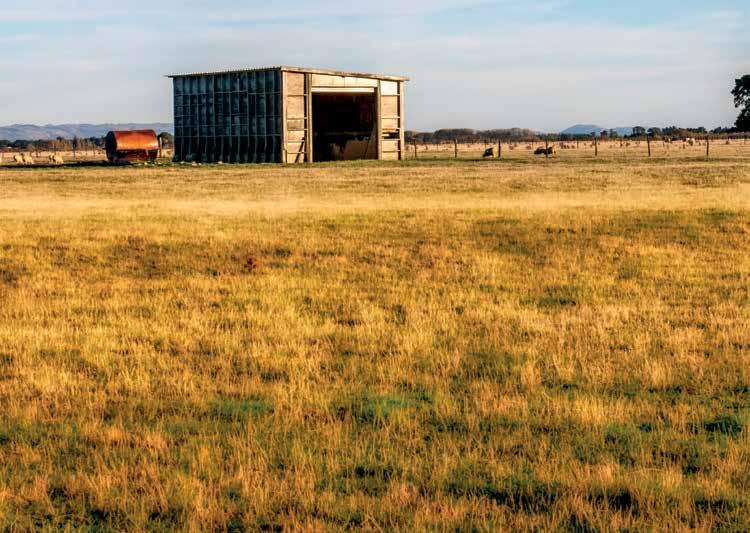
Buildings, sheds and food storage areas can attract large numbers of rodents, so ongoing effort is required to reduce trap or bait shyness. Our toolbox will guide you through how to manage pests across your buildings and storage areas.
An alphabetical listing of companies supplying a wide range of products and services to New Zealand arable growers and industry.
A4AG LTD
Cameron Smith 021 324 269
Product Specialist Upper North
Darren Raikes 021 228 3419
Product Specialist Lower North
Clint Jordan 021 719 461
Product Specialist Upper South
Glen Malcolm 021 537 602
Product Specialist Lower South
ADAMA NEW ZEALAND LTD
Lester Deighton 021 424 163
Country Manager
Blair Hopkins 021 424 957
Business Manager Christchurch
Daren Mabey 021 424 160
Commercial Manager Christchurch
Damian MacKenzie 021 424 964
Commercial Manager Dunedin
Bryce Simpson 021 424 815
Commercial Manager Tauranga
Doug Speers 021 424 179
Commercial Manager Hamilton
Han Eerens 021 424 124
Technical Services & Development Manager
Haydn Murdoch 021 424 917
Regulatory & Compliance Manager
Hamish Mulcock 021 424 752
Portfolio Manager
ADRIA CROP PROTECTION
Graeme Fulton 0274 893 500
Territory Manager South Island
ADVANCE AGRICULTURE
Howard Clarke 0274 328 257
Managing Director
Janine Smith 0274 759 216
General Manager
Paul Sinclair 0272 844 479
Machinery and Precision Ag Specialist
Martin Sloane 0272 215 557
Arable Specialist
Chris Wilson 0272 212 206
Field Rep Eastern/Northern Southland
Rob Wilson 0272 212 214
Field Rep Eastern/Northern Southland
Daniel Knowles 0272 215 551
Field Rep Eastern Southland
Jordan Anderson 0272 212 226
Field Rep Eastern Southland
Nick Bunting 0274 180 988
Field Rep Eastern Southland
Scott Laurence 0272 313 552
Field Rep Southern/Western Southland
Daniel Pinn 0272 212 234
Field Rep Western/Northern Southland
Lane Cuthbert 0272 215 553
Field Rep Central/Western Southland
Paula McMillin 0272 215 560
Field Rep Northern Southland
Richard Devlin 0274 128 098
Field Rep Otago/South Otago
Simon Walker 0272 215 559
Field Rep Otago/South Otago
Chris Buntin 0272 215 554
Field Rep Otago/South Otago
Merran Casse 0274 637 726
Field Rep Otago/South Otago
AGRICOM NEW ZEALAND
Mark Brown 027 220 4110
Australasian Brand Manager
Allister Moorhead 027 433 7739
Product Development Manager
Sarah McKenzie 027 704 6684
Extension Manager
Glenn Judson 027 490 2033
Animal Nutritionist
Kaylee Spain 027 952 2845
Nutrition Specialist
Cassey Edgcombe 027 247 9189
Upper North Island Sales Manager
Laura Pulman 027 706 6309
Central North Island Sales Manager
Georgia Massie 027 705 0664
Eastern North Island Sales Manager
Dylan Moratti 027 550 4085
Western North Island Sales Manager
Mat McKenzie 027 229 5776
Northern South Island Sales Manager
Matt Cooper 027 590 8064
Central South Island Sales Manager
Ben Trotter 027 591 8712
South Island Sales Lead
Jim Beer 027 226 2777
Southern South Island Sales Manager
Blake Gunn 027 406 0474
North Island Forage Systems Specialist
Fraser Harrison 027 404 5513
South Island Forage Systems Specialist
Angee Nagra 027 216 8970
Upper North Island Extension Agronomist
Kylie Dobbs 027 335 3311
Lower North Island Extension Agronomist
Luke Visser 027 541 2232
Upper South Island Extension Agronomist
Greg Dunshea 027 670 9776
Central South Island Extension Agronomist
Sam Anderson 027 405 7195
Southern South Island Extension Agronomist
Jessica Dunbar 027 309 6543 Agronomy Project Coordinator
ALLEN CUSTOM DRILLS
Craig Allen 021 861 440 Director/Design & Sales
AQUALINC RESEARCH LTD
Jim Herbison 021 227 4473
Business Manager NZ Melanie Smith 027 444 7349 Area Manager North Island
Jim Herbison 021 227 4473
Acting Area Manager Mid/South
Canterbury Hamish Maxwell 027 567 3007 Area Manager North Canterbury
ARXADA NZ LTD
Craig Farr 027 2800 416
Territory Manager West NI
Jason Payne 027 280 0975
Territory Manager East NI
John Trott 027 280 0232
Territory Manager Northern SI
Sam Macpherson 027 280 0979
Territory Manager Southern SI
Jason Gosney 027 280 0980
Head of Crop Protection, APAC
Stephen McKennie 027 677 7163
Technical Service and Development Manager
ASUREQUALITY LTD
PLANT HEALTH LABORATORY
Rouke Bakker 021 983 552
Laboratory Manager - Plant Health Lab
Lincoln
Chris Hardy 021 532 625
Administrator - Plant Health Laboratory
Nik Grbavac 021 220 7968
Scientist – Plant Health Lab Lincoln
Jana Monk 021 060 4485
Scientist – Plant Health Lab Lincoln
Nicholas Cummings 027 280 2365
Scientist – Plant Health Lab Lincoln
Harry Huang 021 162 9235
Analyst – Plant Health Lab Lincoln
Nellie Chan 021 211 3905
Analyst – Plant Health Lab Lincoln
Leigh Wyatt
Analyst – Plan Health Lab Lincoln
FIELD SERVICES, AUDITS & INSPECTIONS
Erin Buckland 027 201 7749
Team Leader Ashburton South/South
Canterbury
Julie Hyde 021 703 412
Area Coordinator North Canterbury
Donna Evans 027 643 7593
Area Coordinator Mid Canterbury inland
Nyssa Glare 027 260 4820
Area Coordinator Mid Canterbury coastal
Gunjan Gera 027 299 0378
PVR/OECD Field Trial Team Leader Lincoln
Alan Grieg 021 796 589
Inspector Invercargill
Kullum Ladley 027 302 3107
Operational Delivery Manager Seed and Plant Health
PALMERSTON NORTH SEED LABORATORY
Andrew Ward 021 798 126
Business Manager Seed & Plant Health
Sue Cousins 06 351 7958
Laboratory Manager
Barbara Campbell 06 351 7941
Seed Administration Supervisor
PALMERSTON NORTH
FIELD SERVICES, AUDITS & INSPECTIONS
Justin Salter 021 967 844
Technical Specialist Seeds
BBARENBRUG
Jake Gardner 021 820 398
National Sales Manager
Paul Hames 021 908 177
Area Manager BOP/Central Plateau/King Country
Paul Sharp 021 540 673
Area Manager East Coast North Island
Bruce Paterson 021 495 594
Area Manager Taranaki/Manawatu/ Horowhenua
Craig Weir 021 912 280
Area Manager Upper South Island
Richard Doney 021 948 154
Area Manager Lower South Island
Jen Corkran 021 308 167
Area Manager Northland/Waikato North Island
Mark Shand 021 312 427
Pasture Systems Agronomist Upper South Island
Shannon Morton 021 220 3716
Pasture Systems Agronomist Lower South Island
Blair Cotching 021 307 422
Pasture Systems Manager
Gemma Hansen 021 103 6810
Pasture Systems Agronomist Lower North Island
Fenton Hazelwood 021 744 028
National Commercial Manager Auckland
Grant Hagerty 021 622 406 Technical Manager Christchurch
Rafael Barbieri 027 585 9976
Portfolio Manager Auckland
Tim Herman 027 490 3359 Senior Technical Services Specialist – Crop Protection
Mamoun Al-Farra 027 261 5288
Regulatory Affairs Manager
Tim Fyfe 021 584 582
Territory Manager Arable Canterbury
Geoff Booth 021 744 025
Territory Manager Pasture Otago/ Southland
TBC
Territory Manager Maize/Vege & Non-Crop
Waikato/Upper NI
Colin Dunstan 027 222 7205
Seed Treatment Lead NZ
Tim Geuze 021 730 438
Territory Manager Horticulture Hawkes Bay/Poverty Bay/Wairarapa/Nelson/ Marlborough
Pieter Steyn 021 904 018
National Key Account Manager
Phil Bertram 021 426 825
Regional Business Manager Hamilton
Marc Fox 021 426 823
Regional Business Manager Hastings
Susie Dalgety 021 426 824
Regional Business Manager Palmerston North
David Parker 021 760 794
Regional Business Manager Kaiapoi
David Weith 021 426 096 Regional Business Manager Timaru
Daniel Suddaby 021 426 822
Regional Business Manager Dunedin
BIO-START LTD
Wayne Robinson 027 526 0000 Upper and Eastern North Island
Rex Turnbull 027 575 2696 Lower North Island
Dave Chambers 021 764 247 Upper South Island
Aaron Scarlett 021 733 110 Lower South Island
BLAIRS SUPERTYRE DISTRIBUTORS LTD
Mike Baldwin 027 271 4025
NZ Sales Manager
BROWNRIGG AGRI GEAR LTD
David Stafford 027 501 8566
Sales & service Methven/South Island
CARRFIELDS GRAIN AND SEED
Ryan McLaren 027 275 9978
General Manager Grain & Seed
Lyndon Anderson 027 286 4874
NZ Sales Manager
Mark Derriman 027 432 8027
Grain Trading Manager
Phil Smith 027 889 5815
Cereal Seed Product Manager
Andrew Lilley 027 511 4895
International Sales & Product Manager
Leanne Doherty 021 823 672
Production Manager
Mark O’Grady 027 839 9105
International Seed Production Sales Manager
Izaak McDonald 027 202 0261
Trading Manager
Grant King 027 742 8068
Hybrid Business Manager
Luke Evans 027 869 6831
R&D/Arable Agronomist
Mark McDonald 027 262 4861
Arable Agronomist South Canterbury
Rachael Robinson 027 435 1978
Arable Agronomist North Canterbury
Dave Loomes 027 532 9685
Arable Agronomist Mid & South Canterbury
James Hastings 027 889 3286
Arable Agronomist Mid Canterbury
Rebecca Brooker 027 211 6644
Graduate Arable Agronomist
Johnny Doyle 027 439 3383
Pastoral Agronomist Mid Canterbury
Logan Tasker 027 267 4861
Pastoral Agronomist Mid Canterbury
Huw Murray 027 418 6276
Pastoral Agronomist Central Otago
Matt Jensen 027 856 9999
Pastoral Agronomist North Canterbury
Nicole Holliday 027 341 5769
Pastoral Agronomist South Canterbury
Aaron Watson 027 422 6361
Pastoral Agronomist Central Otago
CATES
Stuart Begg 03 308 7166
General Manager Head Office
Corey Hastie 027 433 5793
Small Seed Manager/Agronomist
Ashburton
Martin Reid 027 432 3269
Produce Manager/Agronomist Ellesmere
Paul Winter 027 434 1787
AgChem Manager/Agronomist Ashburton
Nick Williams 027 273 2786
Agronomist Ashburton
Darcy Moore 027 210 6556
Agronomist Ashburton
Morgan Hunt 027 479 6094
Agronomist Ashburton
Matt Winter 027 542 4927
Agronomist Ashburton
Liam McCormack 027 295 5035
Agronomist Ashburton
Ramon Hurst 03 308 7166
Warehouse Manager Ashburton
Greg Taylor 027 239 4977
Warehouse Manager Rakaia
CENTRAL GRAIN & PRODUCE
Robert Saunders 027 431 0043
Seed Produce South Island
CORSON GRAIN LTD
Richard Hyland 021 243 6325
Maize Grain
CORSON MAIZE
Craig Booth 027 213 1628
Area Sales Agronomist Northland/North Auckland
Maria Klaus 027 231 8140
Area Sales Agronomist Central/Western Waikato & King Country
Cameron Hussey 027 290 3737
Area Sales Agronomist Taranaki/Southern North Island
Andrew Emslie 027 839 7317
Area Sales Agronomist Bay of Plenty/East Waikato/Gisborne/Hawke’s Bay
Arthur Short 027 643 2360
Area Sales Agronomist South Auckland/ North Waikato
Chris Sanders 027 596 3574
Area Sales Agronomist South Island
Mike Turner 027 406 6228
Senior Research Agronomist
CORTEVA
Matt Denton-Giles 027 700 5397
Technical Specialist
Richard Brenton-Rule 027 700 6065
National Sales Manager
Morgan Bell 027 445 1782
Territory Manager Western North Island
John van der Linden 027 839 4748
Territory Manager Central New Zealand
Ian Kirkland 027 446 0952
Territory Manager Northern North Island
John Smith 027 445 1801
Territory Manager Central South Island
Nicole Morris 027 445 1799
Territory Manager Southern South Island
CROPMARK SEEDS LTD
Glen Jarvis 027 432 5570
CEO
Garry Begley 027 434 4435
Marketing Manager
Brent Stirling 027 432 7865
International Sales Manager
Callum Davidson 027 648 8935
NZ Sales Manager
Matthew Deighton 022 1840 550
Technical Manager
Tim Cookson 027 434 4458
Technical Advisor
Nick Cameron 027 232 6664
Plant Breeder
Stephane Montel 027 432 7864
Research Director
James Kinsman 027 250 9964
Assistant Plant Breeder
Matthew Hicks 027 432 5567 Research Agronomist
Sheree Gouk 027 442 2747
Trials Agronomist Upper North Island
James Bryan 027 235 4989
Customer Relations Manager North Island
Liam Martin 027 555 6813
Customer Relations Manager South Island
Carol Maginness 027 432 4891
Senior Production Agronomist
Bradley Jarvis 027 648 8934
Production Agronomist
Richard Moate 027 432 7868
Trials Agronomist South Island
Matthew Kidby 027 230 1783
Technical Sales Specialist Lower North Island
Charlotte Field 027 236 5552
Technical Sales Specialist Lower South Island
Stuart Miller 021 288 2703
Business Manager AUS/NZ - Upper SI/ Lower NI Territory Manager
Shane Dyer 021 242 6217 Upper NI Technical & Territory Manager
Emily Darling 027 716 0869 Technical and Development Manager AUS/NZ
Kieran Fowler 021 473 458 South Island Territory Manager
FFAR (FOUNDATION FOR ARABLE RESEARCH)
Steven Bierema 021 755 198
FAR Board Chairman
Alison Stewart 027 550 0558
Chief Executive
Andrew Pitman 027 252 5722
GM Research & Extension
Anna Heslop 021 960 058
Communications and Events
Ivan Lawrie 027 432 8245
GM Business Operations
FARMGARD LTD
Scott Capper 021 228 3162
Mike Thomas 021 516 551
FARMLANDS CO-OPERATIVE
Brian Richards 027 210 7862
Taupo/Bay of Plenty
Joseph Butler 027 272 6770
Hawkes Bay
Shane Brownlie 027 349 5563
Manawatu/Taranaki
Elton Mayo 027 405 1740
Manawatu
Warren Boocock 027 652 4663
North Canterbury/Tasman
Phil Johnston 027 801 1316
Canterbury
Dave Schrader 027 454 0188
Canterbury/West Coast
Michael Bennet 027 227 2472
Southland
Trevor Todd 027 232 1393
Southland
FERN ENERGY LTD
RURAL SALES TEAM
Amanda Broughton 027 406 6226
Rural Sales Manager Northland
Brad Rufus 027 245 2399
Rural Sales Manager Auckland/North Waikato
Kelly Brears 027 208 4388
Rural Sales Manager King Country
Glenn Ward 027 704 7884
Rural Sales Manager Tauranga/ Bay of Plenty
Tim Redstone 027 446 8934
Rural Sales Manager South Waikato
John Jowsey 027 334 5568
Rural Sales Manager East Coast
Peter Woodward 027 579 8258
Rural Sales Manager Manawatu
Bernie Illston 027 702 0105
Rural Sales Manager Wairarapa
Tom Sherborne 027 237 4304
Rural Sales Manager Eastern Waikato
Greg Rowlands 027 449 9982
Rural Sales Manager Taranaki/Central North Island
Louis Picot 027 245 2403
Rural Sales Manager Nelson
Maisie Davison 027 593 6229
Rural Sales Manager Marlborough
Rob Taylor 027 555 3381
Rural Sales Manager North Canterbury
Pete Manson 027 404 7343
Rural Sales Manager Canterbury
Roy Rose 027 730 5818
Rural Sales Manager South Canterbury
Clare Suzuki 027 512 6309
Rural Sales Manager Central Otago
Reece Winter 027 554 4859
Rural Sales Manager Otago
Russell Smart 027 642 5877
Rural Sales Manager Eastern Southland
Keith Harris 027 245 2397
Rural Sales Manager Western Southland
Paul Topper 027 558 3308
Commercial Sales Manager Upper North Island
Matthew Pilton 027 530 3008
Commercial Sales Manager Waikato
Richard Weir 027 774 4446
Commercial Sales Manager Taranaki/ Wanganui
Grant Miller 021 246 1010
Commercial Sales Manager East Coast, Hawkes Bay
Darryl Watson 027 545 4563
Commercial Sales Manager Wellington/ Wairarapa/ Manawatu
Phil Gavin 027 279 4020
Commercial Sales Manager Blenheim, Tasman, West Coast
Ross Elliot 027 609 9948
Commercial Sales Manager Canterbury
Scott Ayto 027 705 5931
Commercial Sales Manager Southland
Mark Douglas 027 704 8429
Technical Sales Manager
Zoe Ander 027 285 7088
Dargaville
Kerrin Luond 027 270 3981
Wellsford/Helensville/Maungaturoto
Fleur Scelly 027 233 1683
Waipapa/Kaitaia/Kaikohe
Kim Simpson 027 285 7094
Whangarei
Bryant Martin 027 272 2562
Whangarei South/Ruawai
NORTH WAIKATO
Nick Anderson 027 405 2654
Assistant Technical Sales Manager
Mel Leefe 027 240 6377 Pukekohe/Waiuku
Jaimin Benton 027 225 5523
Ngatea
Dilbir Singh 027 807 7265
Taupiri
Ryan Jackson 027 225 5524
Te Aroha, Paeroa
Hayley Benfell 027 704 5323
Morrinsville
Katie Morrison 027 245 7000
Morrinsville
SOUTH WAIKATO
Kirsty Skinner 027 839 4873
Technical Sales Manager
Jarno Sammet 027 494 5433
Technical Ag Specialist
Victoria Power 027 228 3950
Otorohanga
Soroya Rowling 027 704 9664 Putaruru
Weston Kranenburg 027 284 4704
Tokoroa
Bri Bonnar 027 233 1675 Te Awamutu
Debbie Thomson 027 492 2957 Te Awamutu
Brett Wallace 027 607 5898 Hamilton
Brad Cullen 027 681 1250 Cambridge/Matamata
Rebekah Buchanan 027 458 7527 Matamata
Adam Borriello 027 248 9279 Technical Sales Manager
Derek Gibson 027 483 4395 Edgecumbe
Gav Brears 027 226 8348 Taupo
Jackson Blake 027 234 5998 Te Puke
Daniel Stoupe 027 839 2051 Rotorua
Cliff Duggan 027 839 1598 Technical Sales Manager
Neville Giddy 027 477 2641 New Plymouth, Waitara
Andrew Tulloch 027 224 5137 Inglewood
Kelsey Vanner 027 673 2306
Opunake/Okato
Corryn Soothill 027 511 4871 Hawera/Manaia
David Sattler 027 209 9375 Eltham/Kaponga
Chris Lloyd 027 675 0953 Stratford
Kathryn Milne 027 540 4754 Waverley/Hawera South
Shaun Morresey 027 233 1348 Opunake/Manaia
Dean Kane 027 204 4395 Kaponga
Tony Mass 027 801 9639
Technical Sales Manager
Belinda Barclay 027 292 8096
Dannevirke
Danielle Harvey 027 807 0409 Feilding
Jess Morrison 027 263 9373 Wairarapa
Linda Hally 027 236 4897
Shannon, Levin
Val Hollister 027 221 7623
Pahiatua
Kenny Henderson 027 318 6981
Hawkes Bay
Paul Mercer 027 356 4117
Marton
CANTERBURY/TASMAN/MARLBOROUGH
Shanelle Wray 027 555 1239
Technical Sales Manager
Bronwyn Gilchrist 027 453 4358 Ashburton
Cristian Zavala Ruiz 027 555 8976
Ashburton
Bill Cook 027 340 5064
Leeston
Lisa Morrison 027 511 4886
Rakaia
Rachel Butt 027 363 6308
Rangiora
Jo Gordon 027 276 9787
Waimate/Temuka
Kim McNamara 027 676 6524
Temuka
Diane Heinz 027 220 3790 Oamaru
Nick Hewitt 027 638 5734
Murchison
Jen Kay 027 807 5306
Culverden
Alice Cartwright 027 313 0138
Methven
SOUTHLAND / OTAGO
Jamie Callahan 027 405 8184
Technical Sales Manager
Julia Wyatt 027 449 9393
Technical Ag Specialist
Ann Callahan 027 220 3771
Wyndham
Lindsay Youngman 027 839 9432
Otautau
Lauren MacPherson 027 301 2680
Invercargill/Otautau
Kate Lindsay 027 251 9823
Winton
Neville Knight 027 220 3806
Winton
Tim Grant 027 435 3596
Balclutha/Gore
Sean Hallet 027 741 5035
Balclutha (Virtual TSR)
Rory Purvis 027 511 4880
Balclutha
FMC NEW ZEALAND LTD
Hayden Toy 027 442 4990
Country Sales Manager/Area Business Manager Lower NI
Hamish Gates 027 700 9565
Area Business Manager Upper NI
Nick George 027 700 9563
Area Business Manager Upper SI
Stan McKay 027 432 3222
Area Business Manager Lower SI
FRASER GRAIN & SEED LTD
Alan Fraser 03 313 8093 027 432 9273
Rangiora
GENETIC TECHNOLOGIES LTD
NORTHLAND & NORTH AUCKLAND
Brent Bishop 027 554 3315
Regional Manager North Waikato & Northland
Shaun Ruddell 027 507 4881
Area Manager Dargaville & Far North
Corey Thorn 027 886 0221
Area Manager Whangarei & Wellsford
Gil Dallas 027 275 2147
Area Manager South Auckland & North Waikato
Matte Kirk 027 222 2403
Area Manager Hamilton, Taupiri & Morrinsville West
Craig Maxwell 027 224 0917
Regional Manager Central Waikato & Bay of Plenty
Warren Coulson 027 838 7869
Area Manager Hauraki Plains & Coromandel
Grant Douglas 027 554 3316
Area Manager Matamata & Morrinsville South
Logan Scott 027 471 0116
Area Manager Te Awamutu East & South Waikato
Matt Towers 027 255 3048
Area Manager Te Awamutu West & King Country
Ben Gordon 027 422 7604
Area Manager South Waikato & Central Plateau
BAY OF PLENTY
Craig Maxwell 027 224 0917
Regional Manager Central Waikato & Bay of Plenty
Robin Billett 027 273 0497
Area Manager Bay of Plenty
TARANAKI
David McDonald 027 276 5439
Regional Manager Taranaki & Rangitikei
Alan Bunning 027 206 0147
Area Manager North Taranaki
Kim Sharpe 027 528 0012
Area Manager South Taranaki
LOWER NORTH ISLAND & EAST COAST
Mark Burke 027 451 3987
Regional Manager Lower North Island &
Hawke’s Bay
Simon Begley 027 590 8072
Area Manager North Hawke’s Bay & East Coast
Fergus McNaught 027 555 9017
Field Officer Lower North Island
Helen France 027 839 1578
Area Manager Hawke’s Bay, Tararua & Wairarapa
Richard Templeton 027 239 0279
Area Manager Southern Manawatu & Horowhenua
David McDonald 027 276 5439
Regional Manager South Island
Paige Abernethy 027 251 1316
Area Manager North Canterbury, Tasman & Marlborough
Duncan Gillanders 027 555 9016
Area Manager Mid Canterbury & West Coast
Rachel Bell 027 839 7657
Area Manager Canterbury
Daryl Moore 027 767 1119
Area Manager South Canterbury & North Otago
Darin Dick 027 546 0005
Area Manager Otago & Southland
KEY ACCOUNT CONTACTS
Ian Williams 027 495 0789 Farm Systems Specialist
Matt Dalley 027 508 1719
Farm Systems Manager Lower North Island, Taranaki & South Island
Wade Bell 027 702 7049 Farm Systems Manager
Hamish Johnstone 027 886 0217 Grain Account Manager
GILTRAP AG
Matt Moodie 021 880 114 New Zealand Sales Manager
GPS CONTROL SYSTEMS LTD
For technical support please contact Vantage NZ
Russell Van De Laak 021 874 622 Upper North Island
Wade Riley 021 874 602
Central North Island
Cam Burmeister 027 261 0708
Central North Island
Shane Blampied 027 380 5332
South Island
James Story 027 627 4605
South Island
GREVILLIA AG LTD
Charles Borthwick 027 284 1400
Southern North Island
Kevin Scott 027 521 8991
Northern North Island Simon
H&T AGRONOMICS
Paul Oliver 0274
Managing Director/Wairarapa
Andrew
NZ
South
KEY INDUSTRIES LTD
Peter Visser 027 434 1944
Technical Sales Representative
South Island
Donna Daken 027 242 3140
Technical Sales Representative Lower North Island
Warren Wright 027 211 8947
Technical Sales Representative Upper North Island
LLUISETTI SEEDS LTD AGRONOMISTS
Kerry Thomas 027 439 6104 Ellesmere/Methven
Nick Jenkins 027 441 1106 Ellesmere
Andrew Johnston 027 433 4876
Amuri/Cheviot
John McCaw 027 280 4082
Mid Canterbury
Jono Young 027 404 0540
Mid Canterbury
Simon Fleetwood 027 466 0030
Central-Mid Canterbury
Jack Harnett 027 807 2854
Central-Mid Canterbury
Michael Stanley 027 569 6967
North Canterbury
Stephen Booth 027 555 8595
South Canterbury/North Otago
Dean Smith 027 222 3246
Grain Manager
Brendan Morahan 027 434 7355
Agchem Manager
Caleb Pomare-Edwards 027 723 1931
Trainee Agronomist
MMACFARLANE RURAL BUSINESS LTD (MRB)
Anton Nicholls 03 307 8099 / 0275 860 246 Independent Agronomy
MIDLANDS SEED
Charles Wood 027 403 9278
General Manager
Ross Wilson 027 4399 377
Production Manager
Jo Townsend 027 596 0078
R&D Manager
Steve Williams 027 553 0846
Sales Manager Seed Multiplication
Peter Burton 027 444 5122
Sales Manager Cereal Seed & Grain
Brett Colgan 0276 867 328
Sales Manager Pulses
Michael Syme 027 435 4719
Processing Manager
Michael Davies 027 252 2499 Export and Logistics Manager
Brent Middleton 027 441 2466 Field Consultant
Brad Stara 027 287 6920 Field Consultant
Andrew Doyle 027 559 8200 Field Consultant
Michael Bruce 027 807 4101 Field Consultant
Duncan King 027 433 3352
Midlands Contracting Operations Manager
Matt McCully 027 839 5390 Midlands Bees Operations Manager
NNUFARM NZ
NORTH ISLAND TERRITORY MANAGERS
Paul Greenbank 0274 425 835
Hawkes Bay & North Island Sales Manager
Joe Heng 0274 949 012 Northland/Auckland/Hauraki & Coromandel
Celese Smit 0274 425 840 East Waikato/Bay of Plenty/ Gisborne
Jason Marriott 0274 949 009 West Waikato & King Country
Richard Bell 0274 949 015 Taranaki, Wairarapa, & Manawatu
SOUTH ISLAND TERRITORY MANAGERS
Mike Cox 0274 354 271 North Otago & South Canterbury & South Island Sales Manager
Patrick Bissett 0277 000 066
Nelson, Marlborough & West Coast
Jeff Hurst 0277 008 011 Mid/North Canterbury & Kaikoura
Paul Bridgman 0274 425 838 Otago & Southland
OORION AGRISCIENCE LTD
Te Oti Kaihe 021 337 977
Upper North Island
Tony Polkinghorne 021 671 616
Lower & Eastern North Island
Bruce Gemmell 022 375 9977
Upper South Island
Chris Johnson 021 281 3285
Central/South Canterbury
Luke Holmes 021 636 654
Otago Southland
PPGG WRIGHTSON GRAIN
Andy Wilson 027 596 3575
Grain Trading Manager South Island
Kevin Flaxman 027 266 7077
Grain Trading Manager North Island
Ian Ormandy 027 593 9536
Cereal Seed Manager
Nick Brooks 027 596 3972
Product Development Manager
PGG WRIGHTSON – RURAL SUPPLIES NORTH ISLAND
Simon Dodds 027 595 8268
Cambridge (TFR)
Wayne Robinson 027 292 8966
Carterton (TFR)
Mark Jones 027 590 1454
Dannevirke (TFR)
Mark Bradley 027 335 6282
Dargaville (TFR)
Olivia McKay ……………………………………………………….
Dargaville (TFR)
Kerry Davidson 027 218 1606
Eketahuna (TFR)
Glen Terry 027 296 4899
Fielding (TFR)
Hamish McCallum 027 712 7018
Fielding (TFR)
Nikki Barbarich-Waikari 027 208 7826
Gisborne (TFR)
Brett Law 027 218 5030
Gisborne (TFR)
Jamie Yates 027 207 1300
Gisborne (TFR)
Paul Kahaki 027 276 3508
Gisborne (TFR)
Michael Hegarty 027 597 5824
Hastings (TFR)
Warren Johnson 027 592 7511
Hastings (TFR)
Paul Holden 027 434 7678
Hastings (TFR)
Belinda Wilson 027 836 1806
Hawera (TFR)
Bradley Stone 027 463 5390
Hawera (TFR)
Sophie Holst 09 412 2711
Helensville (TFR)
Olivia Rhodes 027 556 6606
Hunterville (TFR)
Sharne Purchase 027 704 8806
Huntly (TFR)
Jon Nutt 027 705 6932
Huntly/Te Kauwhata (TFR)
Phill Oates 027 894 4361
Kaikohe (TFR)
Mike Dyball 027 590 1430
Katikati (TFR)
Kody Boyce 027 448 0725
Marton (TFR)
Bodean McGhie 027 244 9958
Martinborough (TFR)
Jo Balfour ……………………………… 027 294 9680
Martinborough (TFR)
Gavin Harris 027 600 4382
Masterton (TFR)
Mark Enevoldsen 027 590 1435
Matamata/Putaruru (TFR)
Pete Smart Matamata (TFR)
Brad Lovell Matamata
Max Cumpstone 027 267 9102
Morrinsville (TFR)
Scott Daubney 027 235 6454
Morrinsville (TFR)
Nathaniel Turner 027 441 4454 Ohakune (TFR)
Conor Robertson Ohakune (TFR)
Neil Dunderdale 027 202 4758
Otorohanga (TFR)
Doug Burnell 027 595 8232 Piopio (TFR)
Steve Thomas 027 238 5462 Pukekohe (TFR)
Michelle Vining 027 558 2634 Pukekohe (TFR)
Kiri Matthews Pukekohe (TFR)
Dion Schreiber 027 365 5311
Rotorua (TFR)
Chris Hall 027 406 5770
Stratford (TFR)
Cameron McDonald 027 833 6402
Stratford (TFR)
Jason Bolton 027 302 2664
Stratford (TFR)
Butch Cashell 027 590 1036 Taihape (TFR)
Edie Neill 027 702 1025
Taumarunui (TFR)
Darryl Jones 027 230 9237
Taupo (TFR)
Annalise Williams 021 135 9264
Taupo (TFR)
Sarah Wilson
Taupo (TFR
Mark Bulwer 027 707 9356
Te Awamutu (TFR)
Leigh Falleni 027 403 7027
Te Awamutu (TFR)
Bex Whitehead
Te Awamutu (TFR)
Russell Smith 027 590 4921
Te Kuiti (TFR)
Leighton Hammond 027 445 5846
Te Puke (TFR)
Isaac Vujcich 027 590 0471
Waipapa/Kerikeri (TFR)
James Parsons 027 807 8538
Waipukurau (TFR)
Ollie Wilson 027 225 6462
Waipukurau (TFR)
Anthony Bell 027 811 2866
Wanganui (TFR)
Todd Polkinghorne 027 601 6567
Wanganui (TFR)
Michele Smith 027 675 1188 Wellsford (TFR)
Mark Wootton 027 273 1437 Whakatane (TFR)
Martin Topp Whangarei (TFR)
Dan Pavey 027 434 4097
Alexandra (TFR)
Mark Grimward 027 601 2085
Alexandra (TFR)
Sarah Mills 022 429 8749
Alexandra (TFR)
Henry Wardell 027 434 4076 Amberley/Hawarden (TFR)
Mark Clyne 027 531 2964 Amberley (TFR)
Sarah Dalzell Amberley (TFR)
James Fuller Amberley (TFR)
Phill Bloomfield 027 431 4046 Ashburton (TFR)
Dan Copland 027 477 4046
Ashburton (TFR)
Stuart Kelly 027 209 7133
Balclutha (TFR)
Kadys Grant 027 563 9213 Balclutha (TFR)
Rachael Davis 027 598 1720 Blenheim/Kaikoura (TFR)
Andrew McWhannell 027 672 7008 Cheviot (TFR)
Gerard McCarthy 027 473 0614 Cromwell (TFR)
Kaleb Bolton 027 448 6269 Culverden (TFR)
Hamish Marshall 027 434 4097 Culverden (TFR)
Chris Kelly Culverden (TFR)
Gerry O’Neil 027 431 4057 Fairlie (TFR)
Maree Ferriman-Smith 027 591 8420 Fairlie (TFR)
Brent Dalley 027 568 8068 Geraldine (TFR)
Roger Collins 027 435 0740 Gore (TFR)
Paul Henry 027 837 6330 Gore/Tapanui (TFR)
Gareth Kean 027 436 4140
Tapanui/Heriot (TFR)
Lester Howden 027 504 1144 Gore (TFR)
Tony Pascoe 027 454 3618 Greymouth (TFR)
John Hellewell 027 253 0851 Heriot (TFR)
Phil Simons 027 664 4317
Invercargill (TFR)
JJ (Jonathan) Morgan 027 889 3440
Invercargill (TFR)
Jaimee Elder 027 432 0422
Invercargill/Tuatapere (TFR)
Paul Botha 027 226 3018
Kurow (TFR)
Paul Verdonk 027 235 0051
Kurow (TFR)
Robert Trott 027 591 8437
Leeston (TFR)
Jeff McFarlane 027 598 9947
Lumsden/Te Anau (TFR)
Jason Robson 027 839 9494
Lumsden/Te Anau (TFR)
Mitch Carter 027 225 9194
Methven/Rakaia (TFR)
Sarah Swinbourn 027 563 9213
Milton (TFR)
Annie Stephens 027 242 1077
Milton (TFR)
Andrew Young 027 235 6999
Motueka/Richmond (TFR)
Mark Prosser 027 598 9948
Murchison (TFR)
Robin Jamieson 027 231 2313
Oamaru (TFR)
Allan Carlene 027 212 5707
Otautau (TFR)
Alex Clark 03 225 9710
Otautau (TFR)
Paul Sullivan
Otautau (TFR)
Luke Turfus 027 265 5427
Outram (TFR)
Dean Harrison Palmerston (TFR)
Alan Steel 027 252 0951
Rangiora (TFR)
Dayne Paton 027 432 8224
Rangiora (TFR)
Dylan Benny
Rangiora (TFR)
Loryn Robertson 027 273 9790
Ranfurly (TFR)
Tony Sanders 027 839 7081
Roxburgh (TFR)
Todd Anderson
Southland (TFR)
Graeme McCleely 027 590 7502
Takaka (TFR)
Andrew Drummond 027 836 7958
Temuka/Timaru (TFR)
Andrew Brosnahan 027 595 6457
Timaru (TFR)
Josh Dalziel 027 403 4091
Waimate (TFR)
David Wheeley 027 263 3233
Winton (TFR)
Allister Gibson 027 538 8064
Winton (TFR)
Allister Gauldie 027 434 5213
Wyndham
Graeme Jones 027 431 0840
Arable Business Manager Ashburton
Shane Butler 027 477 4134
Arable Business Team Manager Ashburton
Phil Prendergast 027 432 7768
Arable Representative Ashburton
Chris Lock 027 837 7283
Arable Representative Ashburton
Clint Bell 027 595 6470
Arable Representative Ashburton
Campbell Morrow 027 259 4221
Arable Representative Ashburton
Hamish Schmack 027 590 4008
Arable Representative, Ashburton
Tom Adams 027 222 4829
Arable Representative Methven
Tom Middleton 027 836 5010
Arable Representative Methven
Roger Sheat 027 591 0448
Arable Representative Leeston
Steve Roulston 027 434 4079
Arable Representative Darfield
Justin Inwood 027 590 8065
Arable Representative Darfield
Sean Mulligan 027 432 4026
Arable Representative Rakaia
Ash Pace 027 479 1481
Arable Representative Mayfield
Alice Keir 027 431 4048
Arable Representative Temuka
Mark Currie 027 595 6459
Arable Representative Timaru
Jack Millar 027 233 2691
Arable Representative Timaru
Dave Keane 027 705 8137
Arable Representative Waimate
Chris Whitham 027 439 3316
Arable Representative Oamaru
Nick Hishon 027 229 6697
Arable Representative Gore
Campbell Humphrey 027 546 3184
Arable Representative Gore
George Roysmith 027 311 5748
Arable Representative, Gore
Samantha Crossley 027 247 8220
Trainee Arable Representative, Ashburton
Ben Innes 027 205 5627
Trainee Arable Representative, Ashburton
Sam Wiltshire 027 201 4597
Area Sales Agronomist Northern North Island
Greg Zeuren 027 503 0629
Area Sales Agronomist South Waikato/Bay of Plenty
TBC 027 595 3313
Area Sales Agronomist Eastern North Island
Duncan Phyn 027 595 3314
Area Sales Agronomist Western Lower North Island
Lydia Proffit 027 801 8020 Forage Agronomist Upper North Island
ISLAND – SALES AND FORAGE AGRONOMISTS
Chris Sanders 027 596 3574 Extension Agronomist Northern South Island
Richard Goldie 027 502 6182 Area Sales Agronomist Central South Island
Mike Fairbairn 027 201 9327 Area Sales Agronomist Southern South Island
Brian Young 027 590 1640 Area Sales Agronomist Southern South Island
Ethan Butcher 027 404 7452 Forage Agronomist Lower South Island
Wayne Nichol 027 596 3975
Extension Agronomist & Nutritionist
Charlotte Westwood 027 554 4541 Veterinary Nutritionist
Stu Hunter 027 248 6910 Forage Agronomist
PGG WRIGHTSON TURF
Jason Weller 027 596 3974
NZ Sales and Marketing Manager
Tom Littlewood 027 344 6439 Greater Auckland
Rob Green 027 487 4002 Auckland/Northland
Julian Holden 027 289 2244 Waikato/BOP
Karen Crake 027 430 2995 Waikato/Taranaki
Kevin Timms 027 210 8572 Lower North Island
Brendon O’Hara 027 332 5644 Christchurch/Tasman/Marlborough/ Gisborne
Andy McWhirter 027 801 0034
Canterbury
Deon Biggs 027 294 9261
Christchurch/South/Mid Canterbury
Ben Finn 027 649 4943
Otago/Southland
Brian Griffiths 027 430 2992 Business Development Manager
Joe Johnson 027 596 3565 Business Development Manager
Customer Service 0800 PGW TURF Nationwide
PLANT & FOOD RESEARCH
LINCOLN
Maryann Robson 03 940 3948 Cultivar Manager 027 229 2006
Sarah Eady 03 325 9671
Business Manager 027 476 6137
Antonia Miller 03 325 9546
Business Manager 021 571 039
PMR GRAIN SYSTEMS LTD
Tom Burke 027 514 6606
Sales Manager
POPE TEXTILE BAG & PACKAGING LTD
Ross Bruggemann 021 225 8326
Southern Region Sales
David Edwards 0274 941 468
Northern Region Sales
Paul Gleeson 021 819 026
Central Region Sales
POWER FARMING ASHBURTON
Simon Jackson 03 307 7153 027 512 7205
Dealer Principal Mid Canterbury
POWER FARMING CANTERBURY
Geoff
Sales
Jimmy
Sales
- CULTIVATION & SEEDING SPECIALISTS
Graeme
Machinery Manager Morrinsville
John Chapman
Product
Mike
Product
Vaughan
PRIMARY
Andrew
Consultant/Lower South Island
Liam Donnelly 027
Supply & Technical Manager
Nicola Lee 027 873 4622
Seed Production Agronomist
RAVENSDOWN
Hayden Kuyf 027 711 3719
Grain Sales Representative
Mark Jessep 027 439 8000 National Feed Systems Specialist
SSGS NEW ZEALAND LTD
Peter Ward 027 540 9542 Independent Verification Agency
Melanie Creed 027 239 5456 Auckland/Pukekohe
Peter Ward 027 540 9542 Napier/BOP
Sue Young 027 541 4475 Nelson/Marlborough
Fay Trezise 027 706 4447 Canterbury
SMITH SEEDS LTD
Grant Smith 027 432 8654
Managing Director
Dayle Jemmett 027 438 0684
General Manager
Steve Forrester 027 241 5973
Production Manager
Wayne McDowell 027 247 4999 Agronomist
Gary Compton 027 620 8351 Agronomist
Brad Quinlan 027 900 0410 Agronomist
Jo Copland 027 336 3932 Agronomist
Charlie Blair 027 274 1772 Logistics
SOUTH PACIFIC SEEDS (NZ) LTD
John McKay 027 435 2160
Managing Director
David Harrison 027 201 7566
General Manager Business Development
Richard van Garderen 027 229 6664
General Manager Field Production
Jeremy Johnson 027 269 0400
General Manager Production
Hamish Gilpin 027 438 2140
Field Dept Manager
James Taylor 027 201 7601
Field Manager Lincoln/Southbridge
Shane King 027 209 9885
Field Manager Lincoln/Southbridge
Phil Peek 027 493 4345
Field Manager Ashburton
Jane Fitzpatrick 027 441 1256
Field Manager Methven/Lyndhurst
Steve Dunlop 027 445 1954
Field Manager North Canterbury
Birch Jenkinson 027 807 3547
Field Manager Selwyn
Jonathan Hanrahan 027 438 8690
Field Manager South Canterbury
Chris Cavanagh 027 435 7715
Field Manager Winchmore/Ashburton
Sophie Lilley 027 558 1139
Field Manager Methven/Ashburton
Julia Raynes 027 558 0751
Field Manager Central Canterbury
Sam Locke 027 871 9836
Field Manager Hawkes Bay
Malcolm Meads 09 259 3777
Business Manager 021 732 078
SYNGENTA CROP PROTECTION LTD
Nicola Smith 027 494 9013
NZ Regional Manager Auckland
Raeleen Watherston 021 611 664
Customer Marketing Lead Auckland
Ross McCallum 027 494 2662
Territory Sales Manager Ashburton
Nigel Goodwin 021 984 079
Territory Sales Manager Timaru
Dean Perry 021 428 674
Territory Sales Manager Napier
Andrew McIntosh 027 366 5858
Territory Sales Manager Tauranga
TTABULA
Jack Martin 027 560 0675
Upper North Island Sales Manager
Martin Orange 027 489 2120
Lower North Island Sales Manager
Kelly Glover 027 560 1233
Upper South Island Sales Manager
Lauren Stewart 027 560 1237
Central South Island Sales Manager
Georgia Hendrie 027 230 9193
Central Otago & West Coast Sales Manager
Sam Cotterill-Craig 027 474 4615
Lower South Island Sales Manager
TEMUKA SEED (1984) LTD
Greig Bailey 03 615 7913 027 449 9062 Manager
TOWNSEND SEEDS INTERNATIONAL
LTD
Kym Townsend 027 522 3060
Field Rep
Hayden Argyle 027 534 4534
Field Rep
Tim Dale 027 332 4174
Field Rep
TURNBULL GRAIN & SEED LTD
Murray Duff 03 684 5184 027 434 4326
Field Rep Timaru
Hamish Holland 03 684 5184
027 434 4569
Field Rep Fairlie
Jess Williams 03 684 5184 027 434 4356
Field Rep Waimate
Brittany Talbot 03 684 5184 027 249 4751
Field Rep Pleasant Point/Geraldine
UUPL LTD NEW ZEALAND
David Lingan 021 804 450
Adjuvant Product Manager
Mike Goodwin 021 987 735
Regional Manager Central South Island
Pete de Jong 021 790 775
Regional Manager Northern South Island
Tom McDonald 021 519 772
Regional Manager Southern South Island
Ryan Pierce 027 286 5685
Regional Manager Lower North Island
Pieter van der Westhuizen 021 392 740
Regional Manager Upper North Island
VANTAGE NEW ZEALAND
Garry Watt 027 395 9595
Business Manager
VPMAXX (NZ SEED HOUSES LTD.)
Barry Smallridge 027 801 9992
Account Manager Bay of Plenty/Manawatu & East Coast
Alan MacDougall 027 204 4418
Account Manager Waikato, King Country, Taranaki
Alastair McConnachie 027 201 3677
Account Manager Northland, South Auckland
YARA FERTILIZERS (NZ) LTD
Michael Waites 021 491 722
Country Manager
David Spencer 021 471 591
Agronomy & Crop Solutions Manager
Glen Baylis 021 555 214
Commercial Manager
Paul Johnston 027 229 7159
NZ Arable Specialist
Mark Redshaw 021 471 722
North Island Sales Agronomist
Tim Brooker 021 537 309
South Island Sales Agronomist
New Zealand MPI Seed Varietal Certification Scheme - Closing Dates
March
June
July
September
First Monday
First Monday
November
First Monday
First Monday
December
First Monday
Beet (spring sown crops)
Kale
Annual Clovers - Legumes
Beet (autumn sown crops)
Fodder Radish (autumn sown crops)
Hybrid Clover
Rape (autumn sown crops)
Raphanobrassica (autumn sown crops)
Strawberry Clover* (change of variety - see below)
Swede
Turnip
White Clover* (change of variety - see below)
Cocksfoot
Pea (sown prior to 1 July)
Red Clover (Autumn sown)
Serradella
Brome Grass (Bromus sp.)
Browntop
Caucasian Clover
Chicory
Dogstail
Fescue (Festuca sp.)
Festulolium
Lentil
Lotus
Lupin
Phalaris
Plantain
Poa
Ryegrass
Strawberry Clover* (see below)
Timothy
White Clover* (see below)
Yorkshire Fog
Barley
Bean
Fodder Radish (spring sown crops)
Linseed
Lucerne
Mustard
Oat
Pea (if sown after 1 July)
Phacelia
Rape (spring sown crops)
Red Clover (spring sown crops)
Ryecorn
Triticale
Wheat
Hemp (Cannabis sativa) by the 20th of December
Maize
I. * White Clover/Strawberry Clover - If sowing is a change of cultivar in Nucleus, Breeders or Basic class, application for certification must be made by the first Monday in June.
II. Where a public holiday falls on a Monday specified, the closing date is extended one day to the Tuesday immediately following.
III. Overseas cultivars of species for which there is a set closing date should, where possible, be entered by that date, otherwise within 14 days of sowing. For other species where there is no set closing date the crop must be entered within 14 days of sowing.
The New Zealand MPI Seed Varietal Certification Scheme is administered by AsureQuality Ltd for The Ministry for Primary Industries (MPI). www.asurequality.com/our-industries/seeds/new-zealand-seed-business
EXACTA TL GEOSPREAD
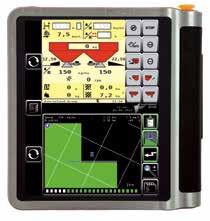
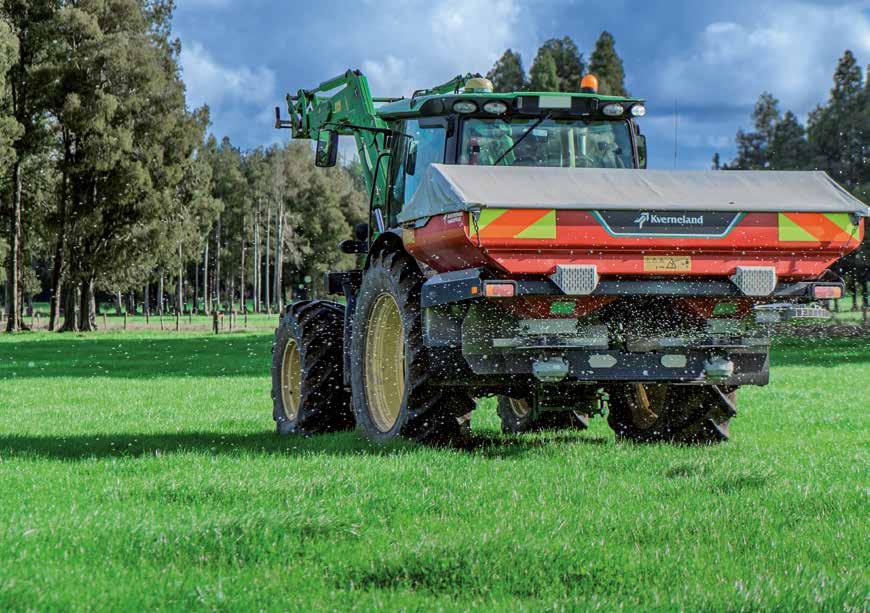
The machine automatically switches between spreading on/off for headlands, along with adjusting the working width in 1m sections to suit overlap and coverage. The application rate is also automatically adjusted to account for forward speed.
The centreflow spreading system accelerates the
fertiliser up to disc speed before it reaches the vane, preventing fragmentation of the granules due to the impact of the vanes. Fertiliser always contacts the vanes at the same point, and travelling the complete length of the vane, even on slopes, you are guaranteed accuracy no matter what the terrain.
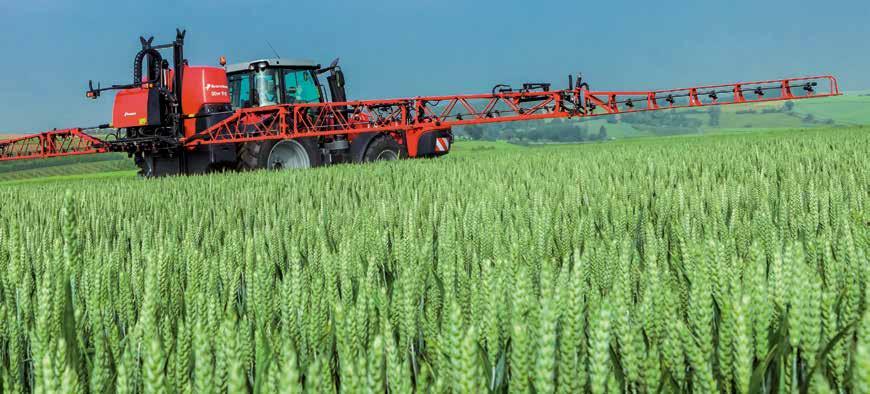
The Kverneland iXter B mounted sprayer is the most advanced mounted sprayer range, with focus on user friendliness and environmental protection.
The iXter B range is available with four different tank volumes from 1000 up to 1800 litres and two boom alternatives (HOSA, HC) from 15 to 30m. Pumps are available with capacities of 150, 200 and 260 l/min. Liquid fertiliser resistant and capable of running dry without damage.

High tech features like iXclean, IsoMatch Tellus, IsoMatch Tellus GO, IsoMatch GEOCONTROL, Boom Guide and a lot more features are available for more operator comfort. kverneland nz
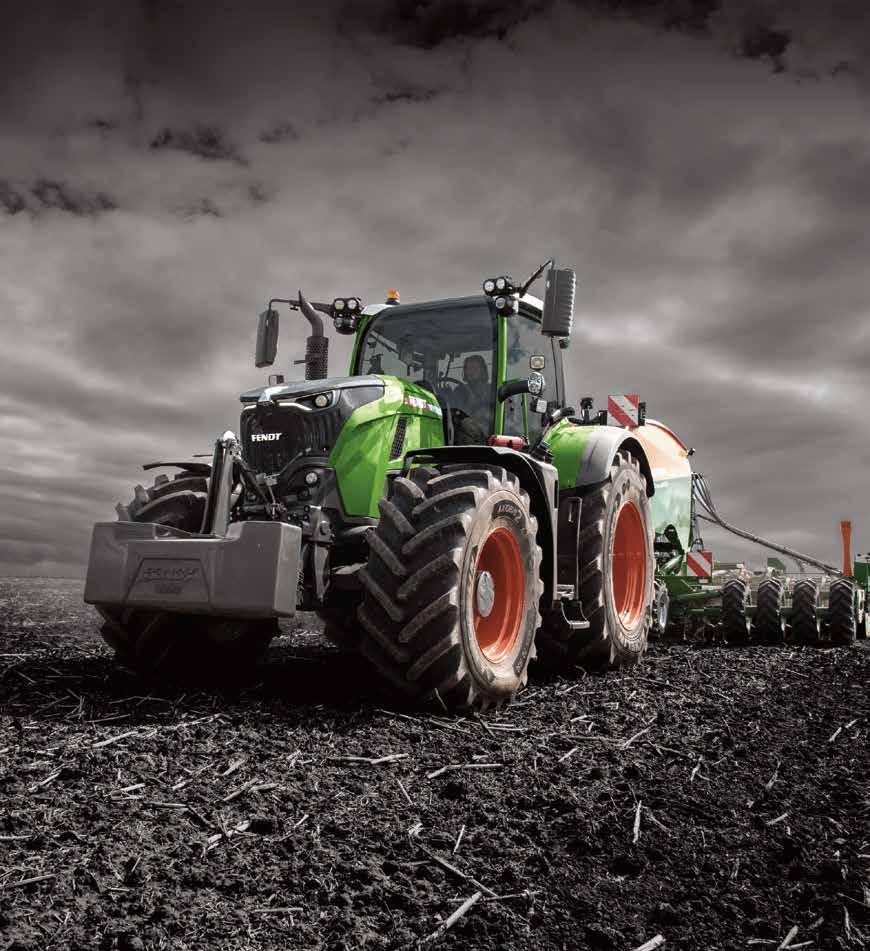

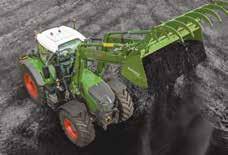

The all-new Fendt 700 G7 is perfect for those with big plans. It features the latest innovations and technologies, and delivers unrivalled efficiency and performance. The FendtONE workstation, combined with intelligent vario drive and Fendt iD low-speed concept set this tractor apart from every other machine in its category.
In the moments that matter, you can count on the 700 G7. Visit fendt.com/au or contact your local Fendt dealer to find out more.